To print the story please do so via the link in the story toolbar.


Odysseus' Journey Timeline
This is a timeline of Odysseus' Journey From Ithaca to the Trojan War Then Back Home
by: Emilia Irovic
Leaving Ithaca to the Trojan War
There was a call to war of the Achaeans (Greeks) against the people of Troy. This war, the Trojan War, started because Paris, the Trojan prince, abducted (or eloped with) Helen, the wife of Menelaus. Menelaus convinced his brother, Agamemnon, the king of Mycenae, to lead an expedition to find her.
Odysseus left Ithaca and his wife, Penelope, and infant son, Telemachus, to fight in the Trojan War.
The Trojan War
Odysseus had the idea of building a large wooden horse on wheels big enough to fit a bunch of Greek soldiers to hide inside it to ambush the Trojans. The Greeks used his idea to won the war.
After the war was won, Odysseus took all his treasures and the his men (supposedly around 528 soldiers) and was headed back to Ithaca in a fleet of 12 ships.
The Journey Home
After leaving Troy, Odysseus and his men arrive at the island of the Lotus-Eaters. Odysseus sends his men out to find food and they begin to eat the Lotus Flowers. Odysseus must recover them and drag them back to the ships so they can continue their journey home.
Afterwards, Odysseus and his men land on the island of the Cicones to raid it for supplies but the Cicones retaliate and kill 72 of Odysseus' men.
While still on the island of the Cicones, Odysseus and his men come across a Cyclops' cave and is lured in by the wine and cheese. Polyphemus, the Cyclops, traps them inside the cave and kill several of Odysseus' men. Odysseus ends up blinding Polyphemus while his men sneak out under sheep and Polyphemus calls upon Poseidon, his father, to not let Odysseus to return home.
Odysseus and his remaining men come across an island floating above the sea with a steep cliff and a bronze palace on top. This island is the island of Aeolia, home of the god, Aeolus, the god of wind. Aeolus gives Odysseus all the bad winds so they can return safely home.
Odysseus' men get curious and go against his orders of not touching the bag and ends up releasing the bad winds. These winds sends them to unknown waters and they are lost at sea.
Odysseus and his men come across a race of powerful giants who's king, Antiphates, and queen decide to turn Odysseus' scouts into dinner. Odysseus and his men flee for their ships but the giants throw boulders at the ships. Only Odysseus' ship gets away.
Odysseus and his men reach the island of Circe and split into two groups. Eurylochus and his group of twenty-two men hear singing coming from Circe's house and enter her home. Circe turns the men of this group into pigs and only Eurylochus escapes to report it to Odysseus.
Still on the island of Circe, Odysseus goes off by himself and meets the god Hermes, who is disguised as a young man, who gives him a magic herb--moly--that can protect him from Circe's magic. Odysseus confronts Circe and when she uses her magic on him, it doesn't work. Circe then asks Odysseus to stay with her which makes Odysseus suspicious. Odysseus makes Circe take a solemn oath to not harm him. Circe eventually turns Odysseus' men back to normal and they stay on Circe's island for a year.
Odysseus travels to the land of the dead, guided by Circe's instructions, to seek advice of the prophet Teiresias. Teiresias tells Odysseus 3 things:
- stay away from the cattle of Helios
- make a sacrifice to Poseidon
- he will have a peaceful old age
Before leaving the Land of the Dead, Odysseus talks to many people such as famous heroes, his mom, people he fought with in the war, and Agamemnon and Achilles. Agamemnon, who was killed by his wife, gives Odysseus advice about women and Achilles tells him that life is better than death. After talking, he fears the glance of the Gorgon monster and rushes back to his ship.
After leaving the Land of the Dead, Odysseus returns to the island of Circe to retrieve his men and prepare themselves to make their way past the Sirens in which Circe had warned them about.
Odysseus puts beeswax into the ears of his men to keep them from hearing the Sirens' dangerous song, while Odysseus is tied securely to the mast so he can hear the song of the Sirens. They pass by safely and lose no one.
The next feat Odysseus and his men must overcome is getting past Scylla and Charybdis. Circe advised Odysseus to cling to the walls near Scylla and lose six of his men rather than risking his whole ship to Charybdis. She advised him to sail as quickly as possible rather than trying to fight Scylla. Odysseus is not happy about this because he would rather not lose any of his men but Circe practically tells him to "suck it up" and play it safe. Odysseus does this (without telling his men about it to avoid panic) and they get past, losing six men.
Next, Odysseus and his men comes to Thrinacia, the island of the Sun, Helios. Odysseus wants to avoid it completely but Eurylochus insists they need to stop there to rest. They are kept there for a month because of a storm and for a while they are able to survive on the provisions of the ship, but when they run out Eurylochus convinces the other men to disobey Odysseus' orders and they slaughter the cattle of Helios. Odysseus was sleeping the entire time and when Helios finds out, he has Zeus destroy their ship.
Odysseus ends up drifting on the sea without any of his men left and is brought to Ogygia, the island of Calypso. Calypso, a nymph, keeps him on her island for years and years, but all Odysseus wants is to go home. Calypso offers Odysseus eternal life, but he refuses and is still miserable. Hermes is sent to the island to help Odysseus and to convince Calypso to let him go. Calypso eventually agrees and Odysseus is able to build a boat and set off for home once again.
Poseidon, seeing Odysseus at sea again, is furious and brings a violent storm and down on Odysseus and his boat is destroyed. Odysseus drifts to the island of the Phaeacians and is found by the daughter of Alcinous and Arete, Nausicaa. Odysseus is able to talk to Alcinous and Alcinous agrees to help him get home
The Phaeacians take Odysseus home to Ithaca and on their way back, they and their ship are turned to stone by Zeus to punish them for helping Odysseus return home.
After 10 years at war, and 10 years of traveling home, Odysseus is finally home at Ithaca but before he can officially return to his household, he must kick the suitors out of his house. With Athena's help, Odysseus, disguised as an old man from Crete, is able to infiltrate his own home and participate in an shooting challenge that his wife, Penelope came up with, and re-win the hand of his wife.
Odysseus is finally home with his wife, Penelope, and son, Telemachus. This concludes his journey.
Greek Gods & Goddesses
Odysseus Journey Map
The Greeks celebrate their victory over Troy at the beginning of the Odyssey, forgetting that it was not their own strength that won the city, but rather the will of the gods.
In light of this neglect to give credit where it is due, Athena and Poseidon become very angry. They begged Zeus to make the Greeks suffer, and he agreed. Poseidon drowned many of their boats and made them go off-track with waves from the ocean.
However, this story is about Odysseus’ voyage in particular. He confronts not only perils set before him by fate or gods, but also common challenges that all people face such as fear, stupidity, and maliciousness of others. Here, we take a look at the Odysseus Journey Map in order. With some details about each of the locations.

- Cicones
- Lotus Eaters
- Cyclops
- Island of Aeolia
- Laestrygonians
- Circe
Teiresias and the Land of the Dead
- Circe
- Sirens
- Charybdis
- Scylla
- Calypso
- Phaeacia
The Greeks have won the Trojan War and are now journeying back to their homeland. Led by Odysseus , they could not have predicted the series of lengthy, dangerous events they would encounter along the way.
The first stop on their journey was the land of the Cicones, where they looted and pillaged to their heart’s content.
Lotus Eaters
The Lotus Eaters lived on an island where the lotus flower grew. These flowers caused anyone who ate them to forget their home and desire nothing but to stay on the island forever.
The Greeks ran into trouble when they landed on the island of the Cyclops. This one-eyed, giant creature kept the Greeks captive in his cave until they finally escaped by blinding the Cyclops.
Island of Aeolia
The next stop was the island of Aeolia, where they met the god Aeolus . He gave Odysseus a bag full of wind to help them on their journey.
Laestrygonians
The Laestrygonians were a race of giants who lived on an island and attacked the Greeks with huge boulders. Many Greek ships were destroyed and only a few men escaped.
Odysseus and his remaining men landed on the island of Circe , where they were turned into animals by the witch Circe. They were eventually turned back into humans and spent a year on the island before leaving.
Odysseus journeyed to the Land of the Dead to speak with the prophet Teiresias. The first spirit to visit Odysseus is that of the man they lost on Aeaea. This soul begs his former captain to go back and give him a burial. Next, the blind prophet Tiresias appears to him. He tells Odysseus that Poseidon is punishing the Achaeans because they blinded his son Polyphemus . Odysseus also speaks with his mother.
Upon returning to this land, Odysseus and his men partake in a burial ritual for one of their fallen comrades. Afterwards, Circe spends her last night with Odysseus.
The Sirens were creatures who sang such beautiful songs that sailors would crash their ships into the rocks just to listen. Odysseus had his men plug their ears with wax and tie him to the mast so he could hear the song without being drawn in.
Charybdis was a creature who lived under the water and would spew out a whirlpool every few days. The Greeks barely escaped her clutches.
Scylla was a creature with six heads who lived on a cliff overlooking the water. She would reach down and snatch up sailors as they passed by.
This is where they met the sun god, Helios. The Greeks angered him by eating his cattle and he punished them by causing a storm that destroyed their ship.
Odysseus was the only one who survived the storm and he washed up on the island of Calypso . She fell in love with him and held him captive for seven years.
Odysseus was finally rescued by the Phaeacians and taken back to their land. He told them the story of his journey home and they provided him with a ship to take him the rest of the way.
He finally arrived home to his wife, Penelope, and son, Telemachus. After twenty years, he was finally reunited with his family.
Link/cite this page
If you use any of the content on this page in your own work, please use the code below to cite this page as the source of the content.
Link will appear as Odysseus Journey Map: https://greekgodsandgoddesses.net - Greek Gods & Goddesses, November 1, 2022

Story of Odysseus: The Brilliant Hero of Greek Mythology
In Greek mythology, the name Odysseus is synonymous with bravery, cunning, and resilience. The epic story of Odysseus chronicled in Homer’s poem Odyssey , has captivated audiences for centuries. From his humble origins to his perilous adventures and triumphant return home, the life of Odysseus is a testament to the strength of the human will and the power of perseverance.
This blog post will delve into the origin, life, and death of the legendary hero Odysseus, shedding light on his remarkable exploits and the impact he left on Greek mythology.
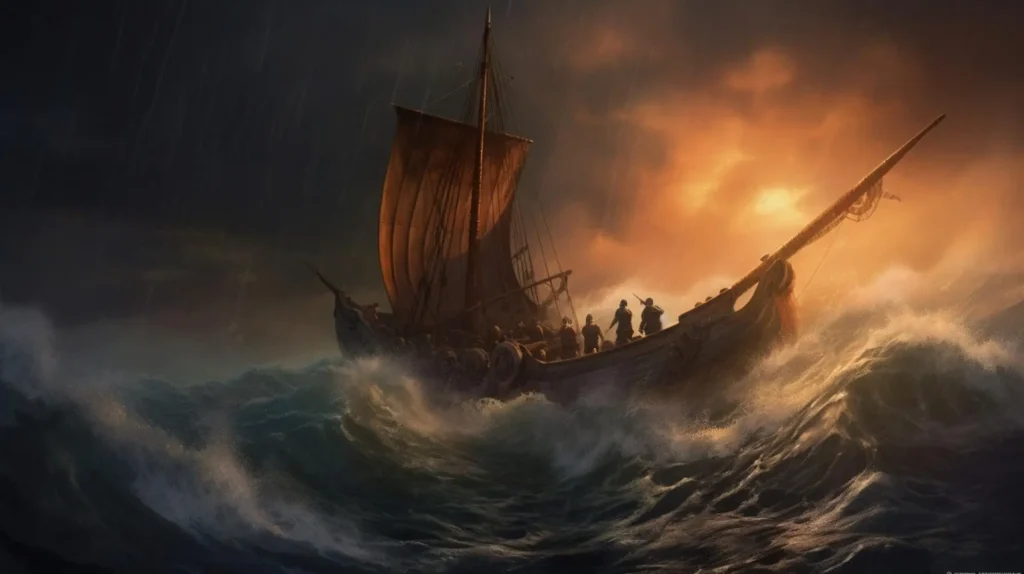
Table of Contents
Beginning story of odysseus.
Odysseus was born on the island of Ithaca, nestled in the crystal waters of the Ionian Sea. He was the son of Laertes and Anticlea, both of noble lineage. From an early age, he displayed exceptional intelligence and a natural aptitude for leadership. It is said that even as a child, he would outsmart his playmates with clever tricks and riddles. These qualities would shape his destiny and set him on a path of extraordinary adventures.
The Trojan War
One of the most significant events in Odysseus’ life was his participation in the Trojan War . As a skilled warrior and strategist, he played a vital role in the ten-year-long conflict. Odysseus is best remembered for devising the idea of the Trojan Horse, a wooden structure that allowed the Greek army to infiltrate the city of Troy and ultimately claim victory. His strategic brilliance and courage earned him the respect and admiration of his comrades.
The Journey Home (The Odyssey)
After the fall of Troy, Odysseus and his men embarked on an arduous journey back to Ithaca. This journey, known as the Odyssey, would last for ten long years and take him through numerous trials and tribulations. During his journey, Odysseus and his crew encounters various mythical creatures and has to overcome several challenges that tested his resolve and resourcefulness.
- The Lotus Eaters: On his journey home, Odysseus and his men land on the island of the Lotus Eaters. Here, some of his men eat the intoxicating lotus fruit which causes them to lose all desire to return home. Odysseus forcibly retrieves them and continues their journey.
- The Cyclops Polyphemus: On another island, they encounter the Cyclops Polyphemus. The Cyclops traps them in his cave and eats several of Odysseus’s men. Odysseus blinds the Cyclops with a wooden stake and they escape while clinging to the undersides of the Cyclops’ sheep.
- The Island of Aeolus: Aeolus, the keeper of the winds presents Odysseus with a bag containing all of the winds, and he stirs up a westerly wind to guide Odysseus and his crew home. However, just as home is in sight, the men open the bag while Odysseus sleeps, thinking it contains gold. All of the winds fly out and they are swept back to Aeolus.
- Circe: On Circe’s island, Odysseus’s crew are turned into pigs after eating food laced with one of her magical potions. With the help of Hermes, Odysseus resists Circe’s magic and she agrees to change his men back to their human form.
- Song of the Sirens: Later in their journey, they have to sail past the Sirens whose enchanting song can lure sailors to their deaths. Odysseus fills the men’s ears with beeswax and has himself tied to the mast so he cannot steer the ship onto the rocks.
- Scylla and Charybdis: To return home they must navigating past Scylla (a six-headed sea monster) or Charybdis (a dangerous whirlpool), Odysseus choose to pass through Scylla because less dangerous, nevertheless he loses six men.
- The Cattle of Helios: Against advice not to, Odysseus’s crew slaughters and eats cattle sacred to sun god Helios. As punishment, Zeus sends a thunderbolt which destroys the ship and all the greek warriors except for Odysseus.
The Return to Ithaca
Eventually, after a decade of trials and tribulations, Odysseus finally returned to Ithaca. However, he found his kingdom in disarray. Suitors had overrun his palace, vying for the hand of his faithful wife, Penelope. Disguised as a beggar, Odysseus devised a plan to reclaim his throne and eliminate the suitors.
With the help of his son Telemachus, the goddess Athena and a few loyal allies, Odysseus executed his plan with precision and brutality. Odysseus revealed his true identity to the suitors and engaged in a battle that resulted in their defeat. Odysseus had triumphed once again, proving himself to be a true hero, reestablishing his reign and reuniting with his beloved Penelope.
The Death of Odysseus
After reclaiming his throne, Odysseus is said to have lived a peaceful and prosperous life in Ithaca. However, his fate took a tragic turn in his later years. According to some accounts, he met an untimely death at the hands of Telegonus, his son with Circe. Mistaking Ithaca for another island, Telegonus accidentally killed his father with a poisoned spear.
Story of Odysseus, the greek hero, continues to capture our imagination with his extraordinary journey. From his cunning tactics during the Trojan War to his tenacious struggle to return home in The Odyssey, Odysseus exemplifies the qualities of a true hero, demonstrated unwavering determination and unmatched intelligence. Though his life ended tragically, his legacy lives on as a symbol of courage, resourcefulness, and the indomitable human spirit.
Story of odysseus serves as a timeless reminder that even in the face of insurmountable odds, one can overcome adversity through courage, wit, and steadfastness.
The Trojan War: The Epic Conflict in the Ancient City of Troy
Greek Mythology: Exploring the captivating Ancient Tales and Their Modern Influence
Story of Medusa: a Tragic Snake-Haired Gorgon from Greek Mythology

[email protected]
081 8054 22671
Privacy Policy
Documentation
Timeline: The Odyssey
An interactive website for The Odyssey , written by Homer .
- After the Trojan war, Odysseus and his men set sail from Troy.
- They plunder the Cicones but are routed by reinforcements.
- On the island of the lotus eaters , some men eat the food of the enchanting inhabitants and loose all hope of home.
- On the Island of the Cyclops, Odysseus's curiosity causes him trouble: he and twelve others are imprisoned by the cannibal Polyphemus . They blind him in order to escape.
- At Aeolia, the wind king Aeolus offers to help Odysseus. He bags up all the winds and places them on Odysseus's ship. But Odysseus's foolish crew open the bag, thinking it is treasure. The winds become a storm and blow the ships back to the island. Aeolus is angry at their irresponsibility and sends them away.
- They arrive at an island inhabited by cannibals who destroy all of the ships except for Odysseus's.
- Next they land on Aeaea, where the enchantress Circe lives. She turns some of the men into pigs. Later, she restores them and sends Odysseus on a lone quest to the Land of the Dead.
- In the Land of the Dead, Odysseus sees his mother who died while waiting for him to return home. Next, A blind prophet named Teiresias gives Odysseus a warning and a promise: Odysseus will arrive home, but all the other men will die.
- Odysseus and his men return to Aeaea. Circe warns him of three perils that await him: the Sirens, Scylla , and Charybdis . They set sail and manage to avoid the danger.
- After their adventures, they arrive at the island of Helios . Eventually, the crew get discouraged and kill the holy cattle for food. Zeus kills all the crew except for Odysseus.
- Odysseus arrives at Calypso's island where he is held captive for seven years.
- At Athena's urging, the gods on Mount Olympus decide it is time for Calypso to free Odysseus.
- Telemachus sets sail to find information about his father. Nestor tells Telemachus that he should ask King Menelaus about his father. King Menelaus tells Telemachus that Odysseus is being held by Calypso .
- Calypso releases Odysseus, and he builds a raft and sets sail.
- Poseidon , who holds a grudge against Odysseus, destroys the raft in a storm. Odysseus washes up on an island.
- A young girl named Nausicaä finds Odysseus and leads him to the city. Athena appears to Odysseus and leads him to the palace of Alcinous.
- The king invites Odysseus to the feast if he will entertain them for a while. The next day, the king holds a party for Odysseus. They play games and a minstrel sings for Odysseus. Odysseus tells his tale in the courts. Afterward, King Alcinous gives him passage to Ithaca . Athena disguises him as an old beggar.
- Odysseus travels to the hut of his old swineherd, Eumaeus. Eumaeus doesn't recognize Odysseus because of the disguise, but he politely entertains Odysseus.
- Athena appears to Telemachus and advises him to return to his home.
- Telemachus meets his father.
- Telemachus, followed by Odysseus, travels to the palace. There, Odysseus is first recognized by his faithful hunting dog, Argos.
- Another beggar from the local town arrives and tries to drive Odysseus out.
- Still disguised as a beggar, Odysseus tells Penelope that he met Odysseus in his travels. The nurse recognizes Odysseus by his scar, but Odysseus quickly tells her not to tell Penelope.
- Odysseus is nervous about his upcoming task. Athena reassures him that the suitors will die.
- Penelope creates a test to prevent the suitors from marrying her: they must string Odysseus's huge bow—a task that only he can do. All the others fail, but Odysseus is successful. The suitors still ignore the beggar.
- Odysseus defeats the suitors.
- Penelope finally recognizes Odysseus as her husband.
- Odysseus visits his father, king Laertes , but the relatives of the suitors have gathered to revenge. Laertes kills the leader, but Athena interrupts them before anything else can happen. She commands them to end the violence.
Bibliography

Oxford University Press's Academic Insights for the Thinking World

A map of Odysseus’s journey

The Odyssey
Odysseus--soldier, sailor, trickster, and everyman--is one of the most recognizable characters in world literature. His arduous, ten-year journey home after the Trojan War, the subject of Homer's Odyssey , is the most accessible tale to survive from ancient Greece, and its impact is still felt today across many different cultures.
- June 26 th 2014
Homer’s epic poem The Odyssey is a classic adventure filled with shipwrecks, feuds, obstacles, mythical creatures, and divine interventions. But how to visualize the thrilling voyage?
The map below traces Odysseus’s travel as recounted to the Phaeacians near the end of his wandering across the Mediterranean. Odysseus’s ten-year trek began in Asia Minor at the fallen city of Troy (the green marker) following the end of the Trojan War. His ultimate destination: his home in Ithaca (the red marker). Click the markers for information on each step of his journey. It is important to note that the 14 locations plotted on this map have been widely debated by both ancient and modern scholars.
Barry Powell, translator of a new edition of The Odyssey , asserts that the currently agreed upon location of the Island of the Sun (#11) is in fact modern-day Sicily. However, the characters in The Odyssey are in “never-never land,” and consequently, the locations plotted cannot be deemed entirely accurate.
Headline image credit: Ulysses and the Sirens by John William Waterhouse, 1891. Public domain via Wikimedia Commons .
Barry B. Powell is Halls-Bascom Professor of Classics Emeritus at the University of Wisconsin, Madison. His new free verse translation of The Odyssey was published by Oxford University Press in 2014. His translation of The Iliad was published by Oxford University Press in 2013.
- Arts & Humanities
- Classics & Archaeology
- Images & Slideshows
Our Privacy Policy sets out how Oxford University Press handles your personal information, and your rights to object to your personal information being used for marketing to you or being processed as part of our business activities.
We will only use your personal information to register you for OUPblog articles.
Or subscribe to articles in the subject area by email or RSS
Related posts:

Recent Comments
There is NO ‘republic of Macedonia! There’s only a so-called Former Yugoslav Republic of Macedonia (FYROM). Please amend your map. You of all to make such mistake?! It’s disgraceful.
Well, your work is an excellent one and enjoyed it. However, I would like to point out that your map has a huge mistake.Does not exist a state named “Republic of Macedonia”, it is FYROM. So if you want to be accepted by Greeks “Hellines”, you have to correct that name at once. FYROM did not exist at the times of Odysseus, they appeared in that territory many-many centuries later from the NE Slaves.
EDITOR’S NOTE:
The map above was created using Mapbox, which sources its geography from Open Street Map. All countries and locations named on the underlying map are modern. The former Yugoslav Republic of Macedonia is commonly referred to as ‘Republic of Macedonia’ in English for brevity (as ‘Italy’ instead of ‘Italian Republic’). This is reflected in the Open Street Map data and is not the direct work of the authors or editors.
Alice Northover OUPblog Editor
Thank you of your reply. In any case any official organization must not accept to participate to the propaganda game of Scopia.Their real old name was and is “Vardaska”. So we, Hellines, will never accept to play their game.In any case, if they want to belong to the Hellenic recent history, they have to ask their union with Hellenic state. Regarding “brevity” this is another of their games…..
Since you are interested of Greek/Hellenic history, please see/read new articles regarding recent discovery at ancient Amphipolis of Macedonia.This is the real history and not the constructed one.
Please do not seek in the Mediterranean!
Homeros was not a fanciful poet.
I say: explorations for Homeros should also be in the Netherlands, where in the ever sinking delta formerly was situated the land Phtia, twice a day inundated by the sea. Clay soils it had, with coarse clods, and the king was married to a sea goddess. Maps have recently been reconstructed.
Who wrote this
Comments are closed.
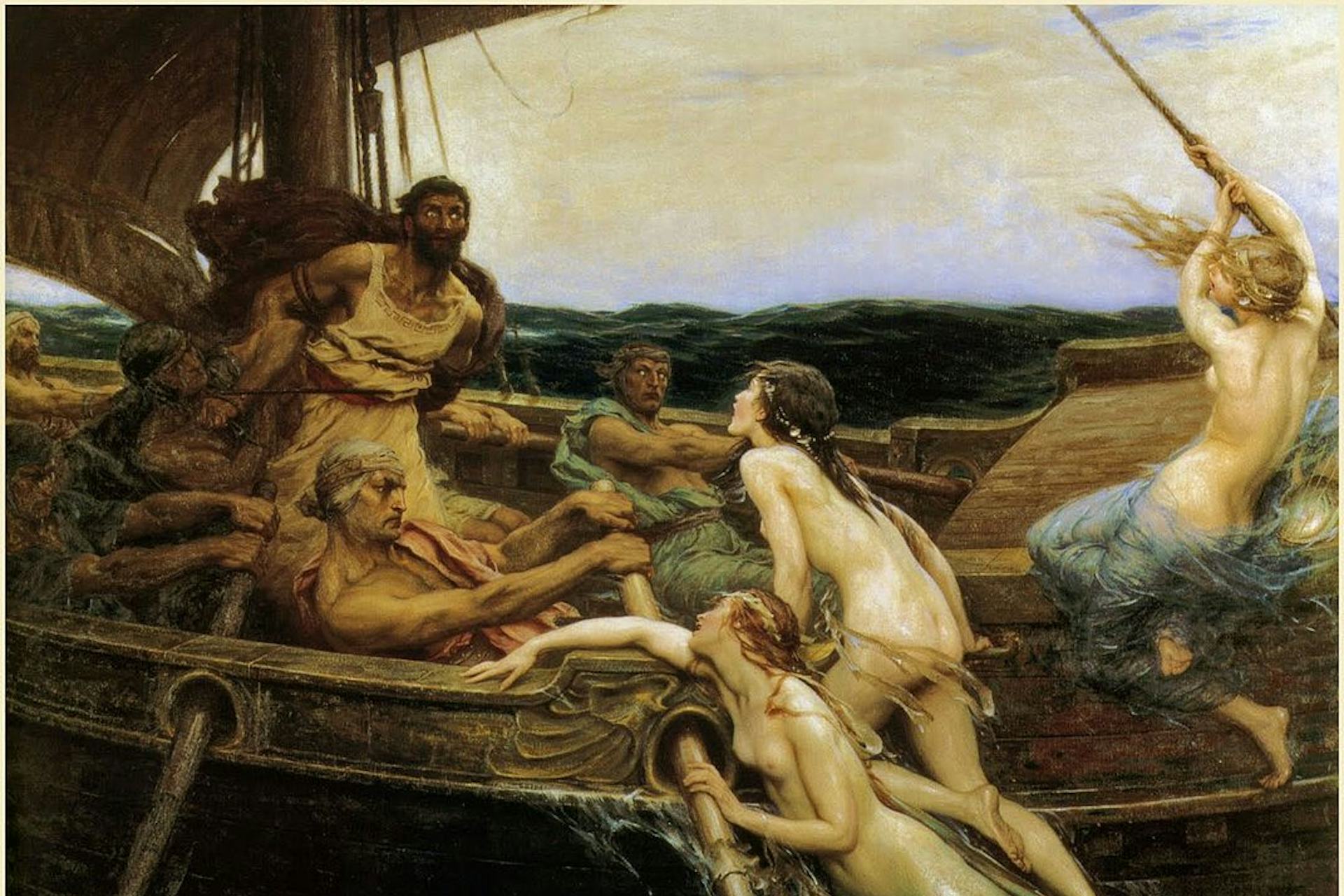
Ulysses and the Sirens by Herbert James Draper (ca. 1909)
The Odyssey —an epic poem made up of 24 books—is one of the earliest works of ancient Greek literature. Together with the Iliad , it is one of two epics said to have been written by Homer, a Greek poet of quasi-mythical status. The Odyssey was probably composed around 750–700 BCE, shortly after the Iliad .
The Odyssey takes place after the end of the Trojan War, a decade-long conflict in which the “Achaean” heroes of Greece attacked and sacked the city of Troy. The poem narrates the wanderings of the Greek hero Odysseus , the “man of twists and turns,” as he journeys home to his island kingdom of Ithaca after fighting at Troy.
Odysseus’ tale of tumultuous seas, terrifying monsters, and angry gods is interwoven with a parallel narrative set in Ithaca, in which Odysseus’ wife Penelope and his son Telemachus must fend off an army of boorish suitors vying for Penelope’s hand in marriage.
To this day, the Odyssey is still considered one of the most important works of Western literature, exerting a significant influence on scholarship, the arts, and popular culture.
The title “ Odyssey ” (Greek Ὀδύσσεια or, more rarely, Ὀδυσσείη, translit. Odysseia or Odysseiē ) is a feminine adjective derived from Odysseus’ name. It thus means “Odyssean” or “of Odysseus.” We can imagine the hypothetical full title of the poem as being Ὀδύσσεια ποίησις ( Odysseia poiēsis ), that is, “poem of Odysseus.”
Pronunciation
We know nothing (possibly less than nothing) about Homer, the name traditionally given to the author of the Iliad and the Odyssey .

Homer and his Guide by William Adolphe Bougueraeu (1874)
A handful of ancient biographies of Homer (called “Lives”) were produced in antiquity. These made various claims about Homer, including that he was blind, that he was born on the Aegean island of Chios, that he was a wandering singer, and that he died on the island of Ios after being stumped by a riddle which some fisherman had posed to him. We have no reason, however, to believe that any of these things are true.
Today, most scholars agree that the Iliad and the Odyssey were composed between 750–700 BCE, meaning that Homer must have lived around that time. But many details surrounding the authorship and composition of Homer's poems remain fuzzy. Today, most scholars agree that a careful study of the language of the poems—especially their use of repeated words or phrases called formulae—demonstrates that the Iliad and Odyssey had been composed orally before they were written down.
Finally, though scholars today continue to refer to both the Iliad and the Odyssey as “Homeric poems,” it is almost universally agreed that the two poems were not written by the same author (the Iliad is now regarded as the earlier of the two). In other words, the two “Homeric poems” were probably not by the same “Homer.” Many other poems were also attributed to Homer in antiquity (including the Homeric Hymns , the Epic Cycle , the Margites , and the Battle of Frogs and Mice ), but these are now regarded as considerably later works (and, with the exception of the Homeric Hymns , they have not survived).
Mythological Context
The Odyssey tells of Odysseus’ voyage home to his small island kingdom of Ithaca after fighting in the Trojan War. [1] This war was fought between the city of Troy (also known as Ilium) on the coast of modern Turkey and the “Achaeans,” a coalition from the mainland and islands of Greece. The Achaeans had sailed to Troy to restore the beautiful Helen to her Achaean husband Menelaus , the king of Sparta, after she was carried off by the Trojan prince Paris . After ten years of fighting, the Achaeans finally penetrated Troy’s impregnable walls, using Odysseus’ cunning trick of the Trojan Horse, and burned the city to the ground.
The myth of Odysseus’ journey home, like the myth of the Trojan War, spans a period of ten years. It begins with Odysseus’ departure from the sacked city of Troy and follows him as he sails to numerous strange and exotic lands throughout the Mediterranean. Along the way, Odysseus encounters hostile populations (the Cicones, the Laestrygonians), fantastic creatures (the Cyclopes , the Sirens , Scylla and Charybdis ), and an array of gods and goddesses ( Circe , Calypso ). At one point, Odysseus even passes through the Underworld.
Through all his wanderings, Odysseus never loses the desire to be reunited with his homeland and family. Eventually, he does reach Ithaca, though by that point he is all alone, having lost his ships and his men. But Odysseus’ trials do not end there: he must still retake his palace from the savage suitors trying to steal his wife Penelope from him. With the help of his son Telemachus, his patron goddess Athena , and several loyal servants, Odysseus finally kills the suitors and reclaims his kingdom.
While Homer’s Odyssey would remain the main source for the myth of Odysseus’ homecoming, the myth and character of Odysseus himself was developed—and continued to develop—through numerous sources.
Odysseus is an important character in Homer’s Iliad , of course, usually thought to have been composed just before the Odyssey . The hero also appeared in other Greek epics that told of his role in the Trojan War or even his adventures after returning to Ithaca—though unfortunately, these have not survived.
Later, Odysseus was adapted and reinvented by a variety of lyric poets, tragedians, and visual artists. Euripides’ Cyclops , for example—the only satyr play from antiquity that has survived intact—is a burlesque retelling of the tale of Odysseus and the Cyclops Polyphemus from Book 9 of the Odyssey .
The Romans (who knew Odysseus as “Ulysses”) reimagined the cunning hero as a kind of deceitful villain.
Significance
The Odyssey is a key example of what the Greeks called nostos (plural: nostoi ), meaning “return” or “homecoming.” There were many famous nostoi traditions in antiquity, covering the various Greek leaders who fought in the Trojan War. One epic—appropriately titled Nostoi —was even devoted to recounting all these myths. The Odyssey is thus part of a well-developed narrative tradition—and, importantly, the only example that has survived.
Odysseus was not always the sympathetic hero presented by Homer—and even for Homer, Odysseus is a very different kind of hero than the more obviously valorous Achilles . But with his famous cunning and unrivaled ability to escape even the most dire of straits, Odysseus always held an important place in the Greek imagination.
Odysseus’ journey was likely shaped in important ways by historical developments. The myth of the Trojan War itself may have been a historical memory (albeit a heavily embellished one) of a conflict that took place towards the end of the Mycenaean period, the last phase of the Greek Bronze Age (ca. 1600–1050 BCE). This memory was likely preserved as an oral tradition long before it entered written form in the Iliad , the Odyssey ,and other poems.
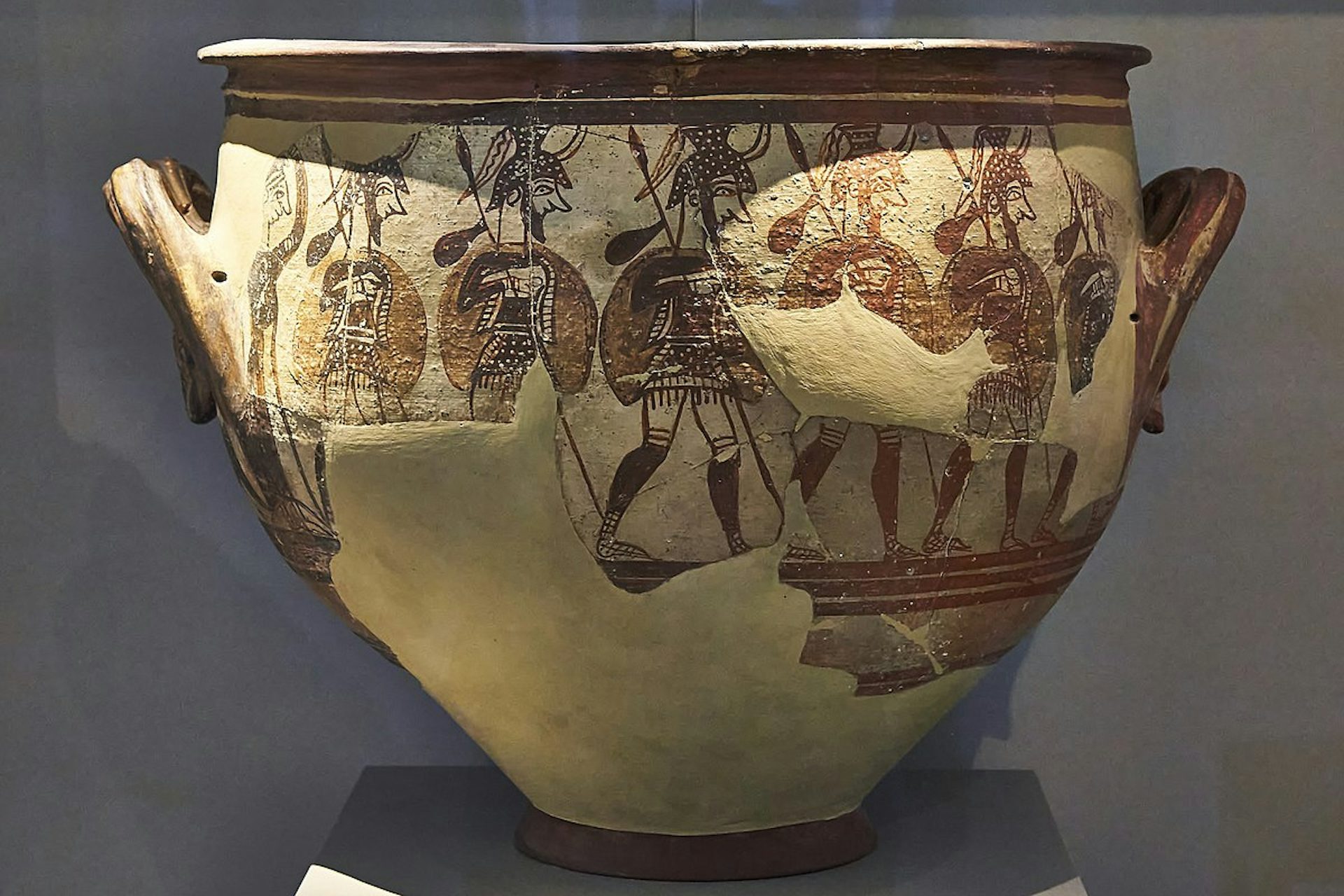
Mycenaean krater (mixing bowl) showing soldiers setting out for battle (12th century BCE)
Above all, the Odyssey appears to have been influenced by the increase in travel and colonization that marked the Archaic period of Greek history (ca. 800–490 BCE). Odysseus journeys to many distant and exotic lands, meeting strange people and creatures along the way—experiences that probably resonated with the poem’s early Greek audience, who were increasingly discovering other civilizations.
This increased contact no doubt led to foreign influences on the literature and mythology of the Greeks. Indeed, the Odyssey shows clear signs of Near Eastern influence. For example, Odysseus’ travels closely resemble those of the Mesoptomian hero Gilgamesh, who, like Odysseus, journeyed to the end of the world, consorted with goddesses, and visited the land of the dead.
Telemachus and the Telemachy (Books 1–4)
Book 1 of the Odyssey begins with an introduction to Odysseus and his absence. On Mount Olympus, the gods decide that it is time for Odysseus, who has been stranded for seven years on the island of the nymph Calypso, to finally return home. Athena, goddess of wisdom and Odysseus’ protector, goes to Odysseus’ palace in Ithaca, which is being overrun by unruly suitors who wish to marry Odysseus’ wife Penelope and take over the kingdom. Athena disguises herself and convinces Telemachus, Odysseus’ son, to go in search of his father.
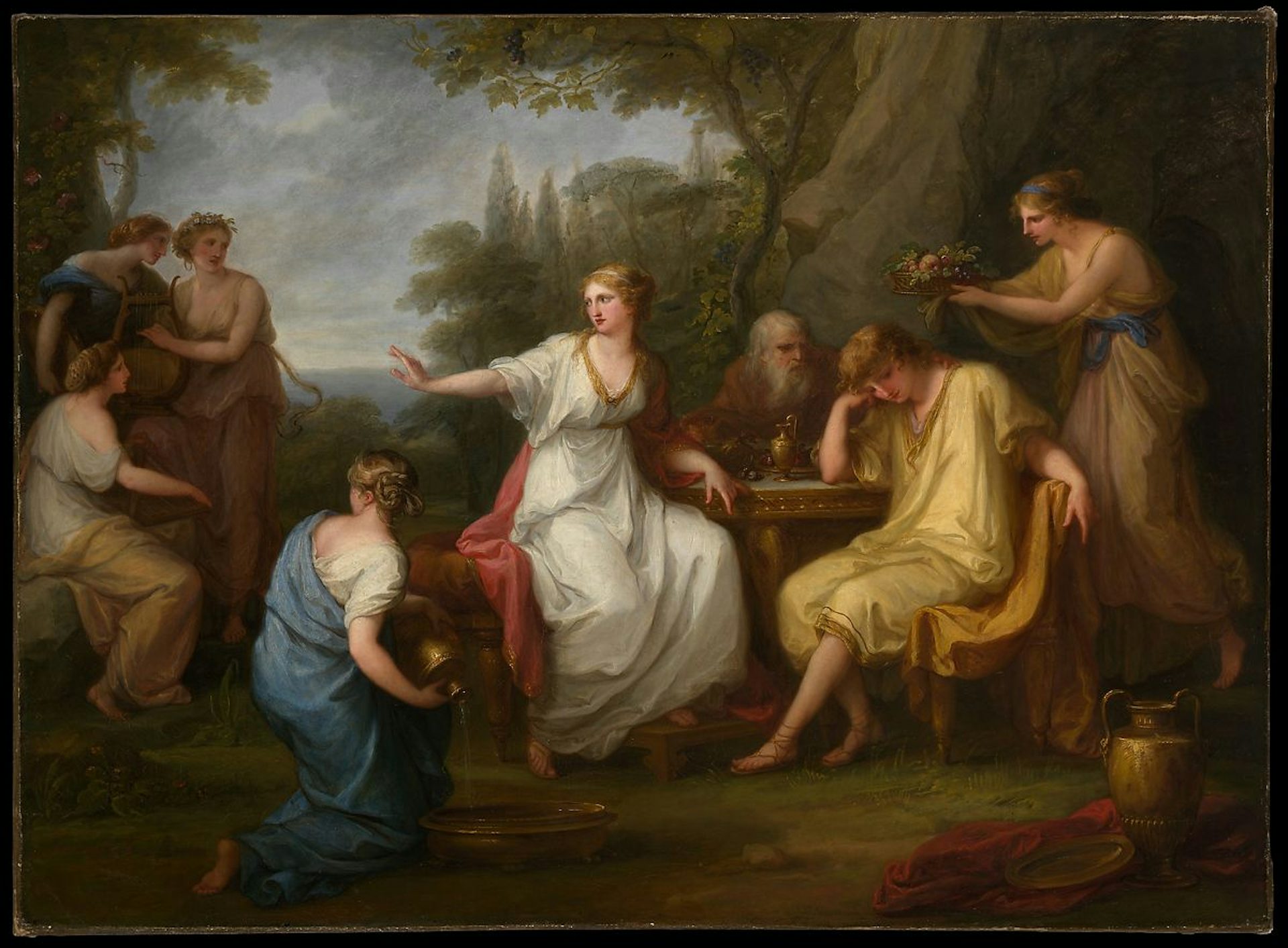
The Sorrow of Telemachus by Angelica Kauffmann (1783)
Book 1 of the Odyssey begins with an introduction to Odysseus and a discussion of his absence. On Mount Olympus, the gods decide that it is time for Odysseus, who has been stranded for seven years on the island of the nymph Calypso, to finally return home. Athena, goddess of wisdom and Odysseus’ protector, goes to Odysseus’ palace in Ithaca, which has been overrun by unruly suitors who wish to marry his wife Penelope and take over the kingdom. Athena disguises herself and convinces Telemachus, Odysseus’ son, to go in search of his father.
Odysseus, the Phaeacis, and the Apologoi (Books 5–12)
In Book 5, we finally meet Odysseus. Zeus sends Hermes , the messenger of the gods, to order Calypso to release Odysseus. The hero builds a raft and sets sail. But Poseidon , the god of the sea and Odysseus’ enemy, spots the hero and shipwrecks him.
Odysseus eventually washes ashore on Scheria, the island of the Phaeacians, where Athena arranges for him to be found by the princess Nausicaa (Book 6). With Nausicaa’s help, Odysseus arrives at the court of Alcinous and Arete, the king and queen of the Phaeacians (Book 7).

Odysseus and Nausicaa by Valentin Serov (1910)
The Phaeacians entertain Odysseus, who does not initially reveal his identity (Book 8). Pressed by Alcinous, however, Odysseus finally tells the court who he is and begins recounting the story of his wanderings in Book 9.
Odysseus narrates his adventures after the fall of Troy, including his encounters with the Cicones, the lotus-eaters, and the terrifying Cyclops Polyphemus. He and his men manage to escape Polyphemus by blinding him in his one eye, but this earns Odysseus the hatred of Polyphemus’ father Poseidon.
Odysseus continues his story in the following books. He tells of further adventures with Aeolus (the lord of the winds), the man-eating Laestrygonians, and the sorceress Circe. Circe initially transforms several of Odysseus’ men into swine, but she eventually restores them to their original form and even grants hospitality to Odysseus and his companions (Book 10).
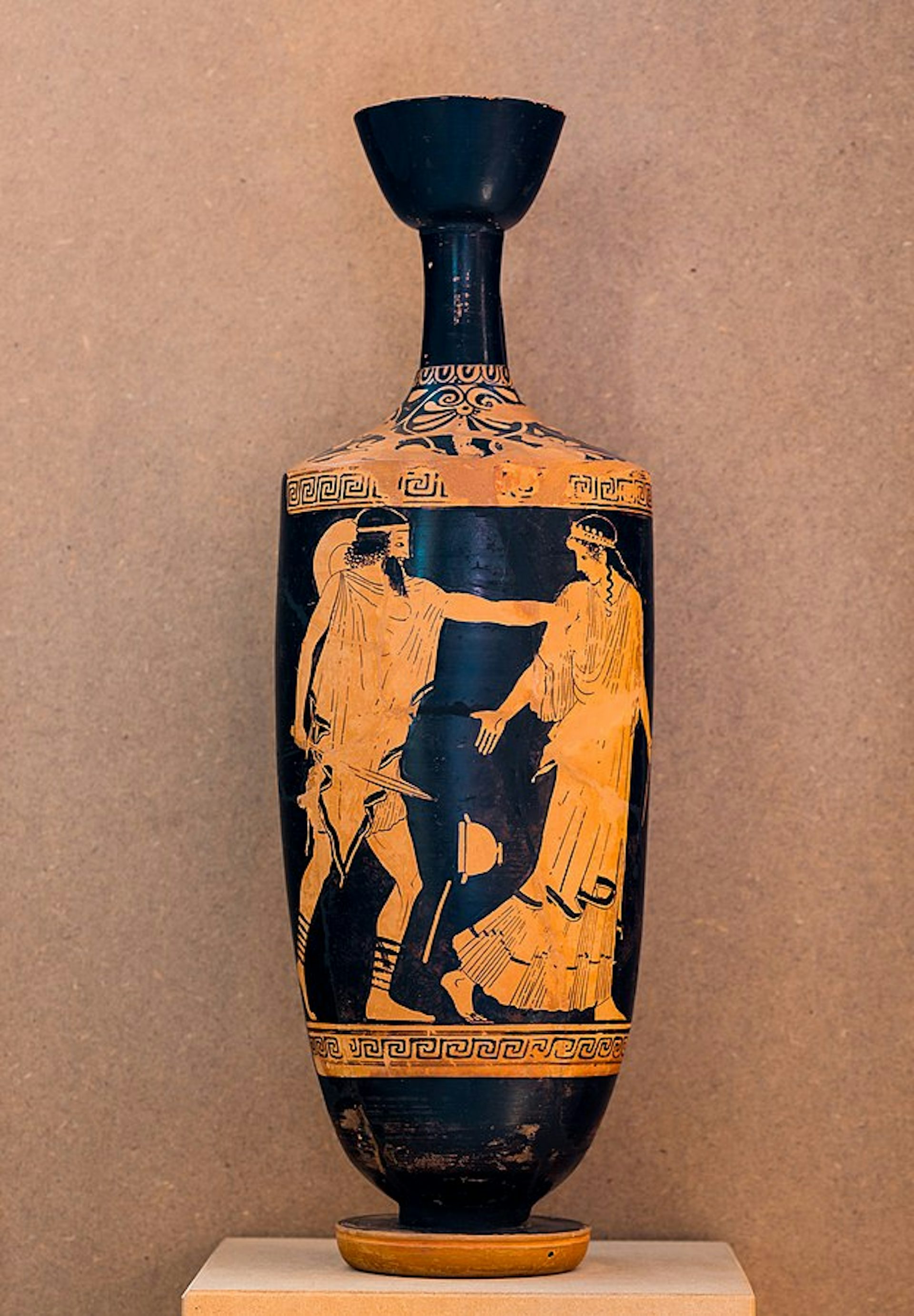
Attic red-figure lekythos (oil jar) showing Odysseus threatening Circe by the Nikon Painter (ca. 480–470 BCE)
In Book 11, Odysseus describes his journey to the Underworld to seek advice from the seer Tiresias. [4] While there, he meets many shades (spirits of the dead), including his warrior companions Achilles and Agamemnon and his mother Anticlea .
In Book 12, Odysseus tells of how he and his men managed to escape the Sirens and the sea monsters Scylla and Charybdis. But on the holy isle of Thrinacia, his men decide to devour the cattle of the sun god Helios and are killed in a storm as punishment. Odysseus, the sole survivor, washes ashore on Ogygia, where he is kept as Calypso’s lover for several years before traveling to Scheria.
The Return (Book 13–24)
After Odysseus finishes his tale, the Phaeacians give him lavish gifts, put him on a ship, and return him to Ithaca while he is sleeping (Book 13). In Ithaca, Odysseus is greeted by Athena, who disguises him as an old beggar so that he can go into the city without being recognized by the dangerous suitors.
Still dressed as a beggar, Odysseus is entertained by his old swineherd Eumaeus in Book 14, though he continues to lie about his identity. Telemachus, meanwhile, makes his way back home, meeting the seer Theoclymenus on the way and narrowly avoiding the ambush the suitors had set for him (Book 15). Upon reaching Ithaca, Telemachus stops at Eumaeus’ hut, where he is reunited with his father after twenty years (Book 16). The two begin to plot the destruction of the suitors.
In Book 17, Odysseus and Telemachus go to the palace separately. Odysseus, still disguised as a beggar, is viciously abused by the suitors (Books 17 and 18). At night, Odysseus and Telemachus hide all the palace’s weapons so the suitors cannot find them (Book 19). Odysseus speaks with his wife Penelope but does not reveal his identity to her. He is, however, recognized by his old nurse Euryclea, who is sworn to secrecy.
The next day, Odysseus and Telemachus—helped now by Eumaeus and another loyal slave, the cowherd Philoetius—continue their preparations to kill the suitors (Book 20). Penelope announces that she will marry whoever can string Odysseus’ great bow and shoot an arrow through twelve ax heads (Book 21). All the suitors try and fail. Odysseus then takes the bow and, of course, passes the test easily before slaughtering the suitors with the help of Telemachus, Eumaeus, and Philoetius (Book 22).
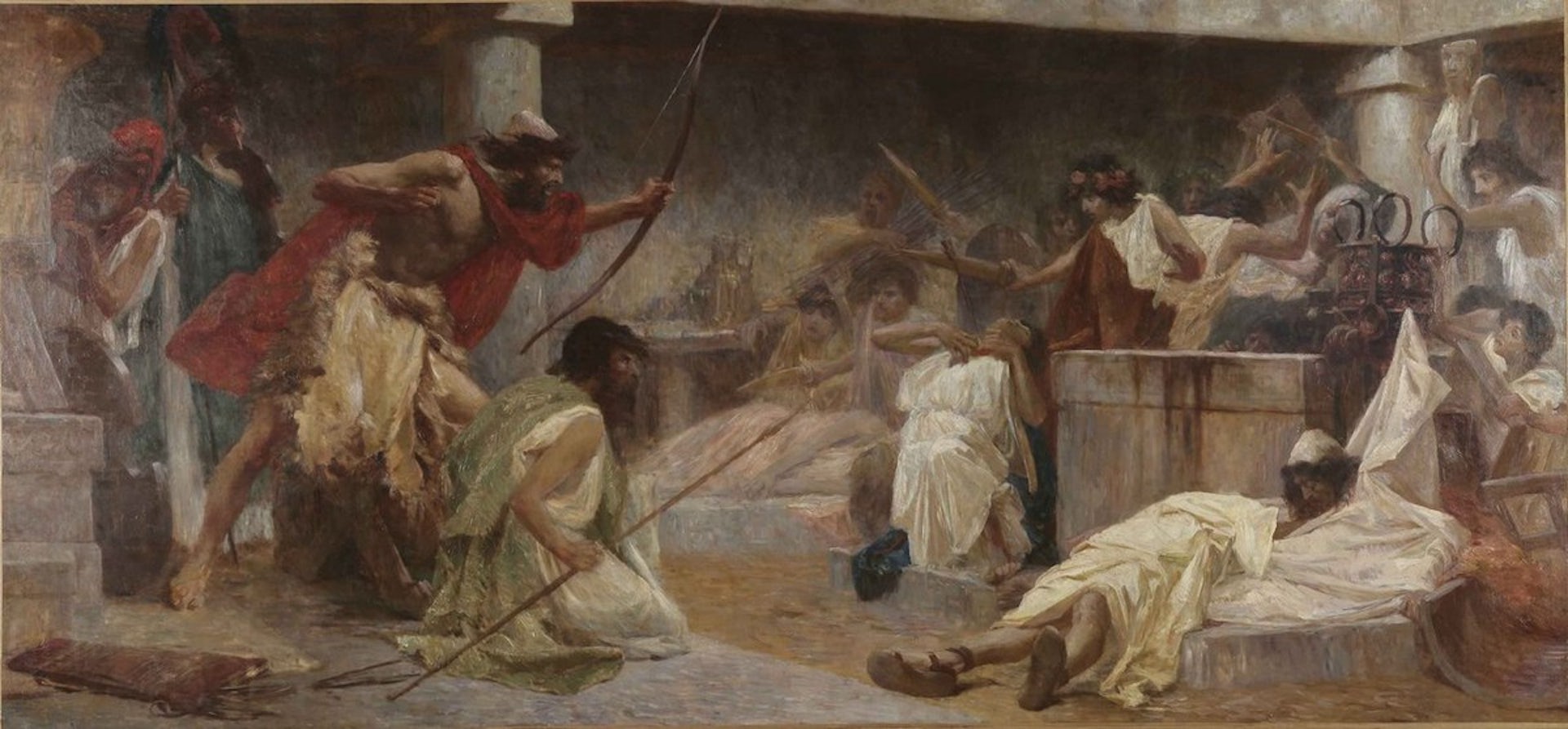
Odysseus Kills the Suitors by Bela Čikoš Sesija (early 20th century)
After the massacre is complete, Odysseus and Penelope are finally reunited (Book 23). The next morning (Book 24), Odysseus is also reunited with his elderly father Laertes. The angry families of the suitors prepare to attack Odysseus, but Athena swoops down to make peace.
Style and Composition
The Odyssey is generally believed to have been composed just after the Iliad , the other epic regarded as “Homeric.” Like the Iliad , the Odyssey typifies the basic conventions of early Greek epic poetry, employing dactylic hexameter and an elevated, artificial diction, which does not appear to have corresponded to any spoken dialect of ancient Greek. Stylistically, these epics are also notable for their use of elaborate speeches and similes.
Together with the Iliad , the Odyssey represents one of the earliest examples of written literature in ancient Greece; before the eighth century BCE, Greek poetry was composed and transmitted purely orally. In fact, the Odyssey (like the Iliad ) probably originated as an oral poem and retains some of the formulaic elements that distinguished such poetry. However, because it was eventually written down, the Odyssey stands out as a remarkable example of the transition from orality to literacy in ancient Greece.
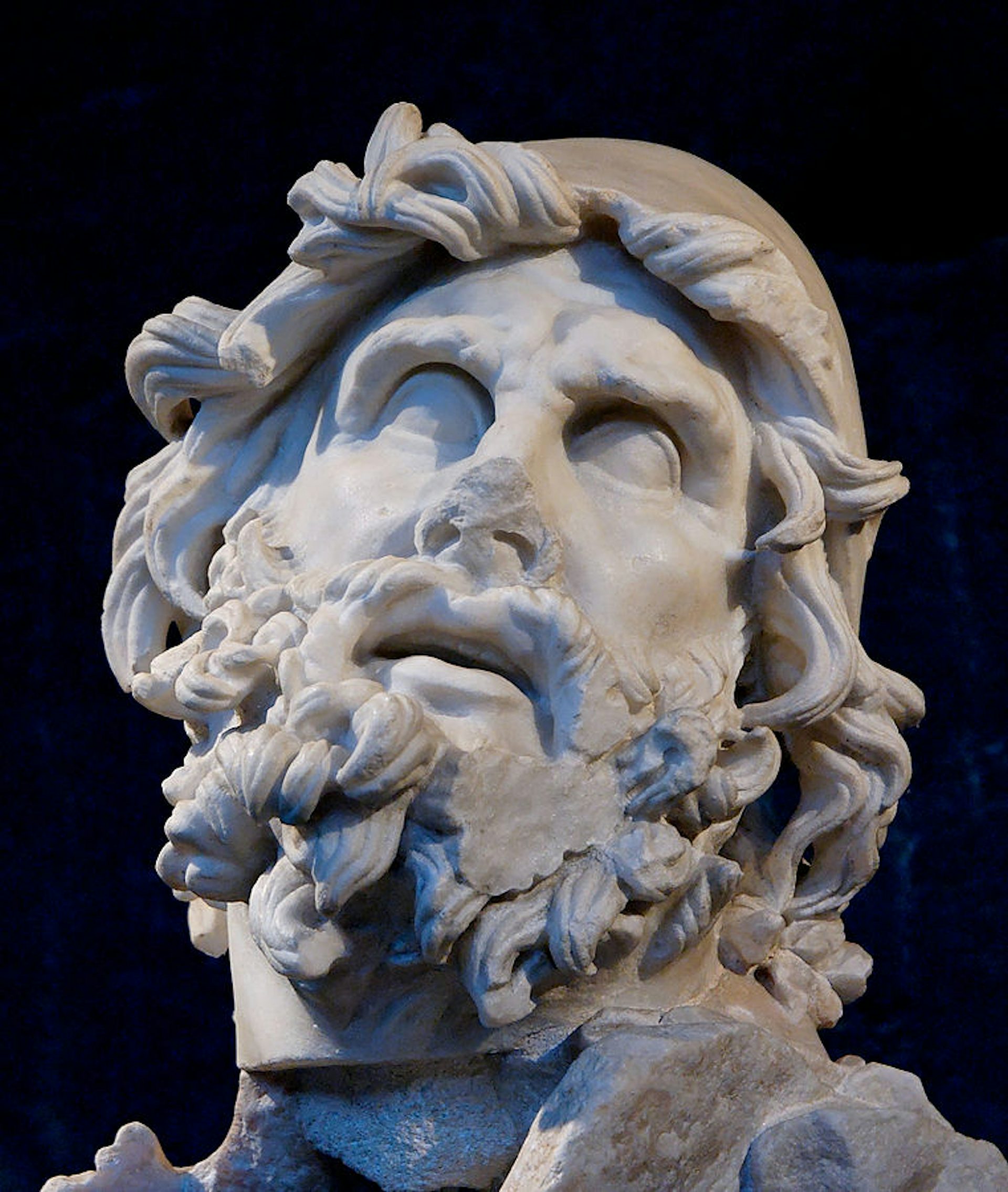
Head of Odysseus from a sculptural group showing the blinding of Polyphemus (1st century CE). From the Villa of Tiberius at Sperlonga.
Though the Iliad and the Odyssey have many similarities, there are also important stylistic differences between the two epics. For instance, there are fewer extended similes in the Odyssey , as well as greater thematic “variety” ( poikilia ). Such differences may reflect gradual developments in early Greek literature, but they also lend credence to the theory—accepted by most scholars today—that the two epics were not written by the same poet.
The Odyssey explores an astonishing variety of themes, including heroism, duty, family, gender, and the relationship between gods and mortals. These themes are all filtered through the main subject of the Odyssey : the homecoming ( nostos ) of the hero Odysseus. This is announced in the very first lines:
Tell me, O Muse, of the man of many devices, who wandered full many ways after he had sacked the sacred citadel of Troy. Many were the men whose cities he saw and whose mind he learned, aye, and many the woes he suffered in his heart upon the sea, seeking to win his own life and the return of his comrades. Yet even so he saved not his comrades, though he desired it sore, for through their own blind folly they perished—fools, who devoured the kine of Helios Hyperion; but he took from them the day of their returning. Of these things, goddess, daughter of Zeus, beginning where thou wilt, tell thou even unto us. [5]
The Odyssey weaves through different worlds as it follows the return journey of Odysseus, leading us to reflect on the value of human life and civilization. We encounter numerous fantastical lands and creatures in Odysseus’ narrative of his travels. These are contrasted with the “real” world of Ithaca, Pylos, and Sparta—a world that contains suffering, death, and war, but that is also defined by order and rules that must be obeyed.

Illustration of Scylla attacking Odysseus and his crew by John Flaxman (1910)
The real world, for all its flaws, is the only place where mortals like Odysseus can find happiness, community, and family. This is why Odysseus turns down Calypso when she offers to make him immortal if he will only forget Ithaca and stay with her on Ogygia (Book 5). It is also why Achilles’ shade tells Odysseus in the Underworld that
“I should choose, so I might live on earth, to serve as the hireling of another, of some portionless man whose livelihood was but small, rather than to be lord over all the dead that have perished.” [6]
In order for the civilized human world to function properly, however, certain rules must be obeyed, and the punishment for violating those rules is severe. The lawless suitors, for example, who try to steal Odysseus’ wife and property, are wiped out in the end.
The gods, too, must be obeyed, but even they are subject to a hierarchy, with each god ruling over their own domain and Zeus ruling over all. Poseidon can do whatever he wants with Odysseus while he is at sea—even Athena cannot step in—but in the end, Poseidon must bow to the will of Zeus when he decides it is time for Odysseus to return home.
The Odyssey is also a poem about heroes and heroism, not unlike the Iliad . But Odysseus is a very different kind of hero from Achilles, the Iliad ’s protagonist. Though both are great warriors, Odysseus is more approachable than Achilles. He is, as the very first word of the Odyssey declares, a “man.” Throughout his epic, Odysseus’ chief goal is not military glory ( kleos ) but simply to go home to his family. While Achilles’ heroism lies primarily in his superiority as a fighter, Odysseus never shies away from using cunning to get his way. Odysseus also typifies the qualities of endurance and self-control far more effectively than the impulsive Achilles.
While the heroism of the Odyssey is defined by noble male figures, slaves and women also play an important role in this sprawling epic. Penelope is shown to be the intellectual equal of her famously intelligent husband, using her cunning not only against the suitors but also, in Book 23, to test Odysseus himself. Penelope is also the epic’s paragon of female virtue, though this ultimately means she is largely defined by her relationships to men (she is the wife of Odysseus, the mother of Telemachus, the daughter of Icarius, etc.). Indeed, her most notable virtue is her stalwart marital fidelity to Odysseus.
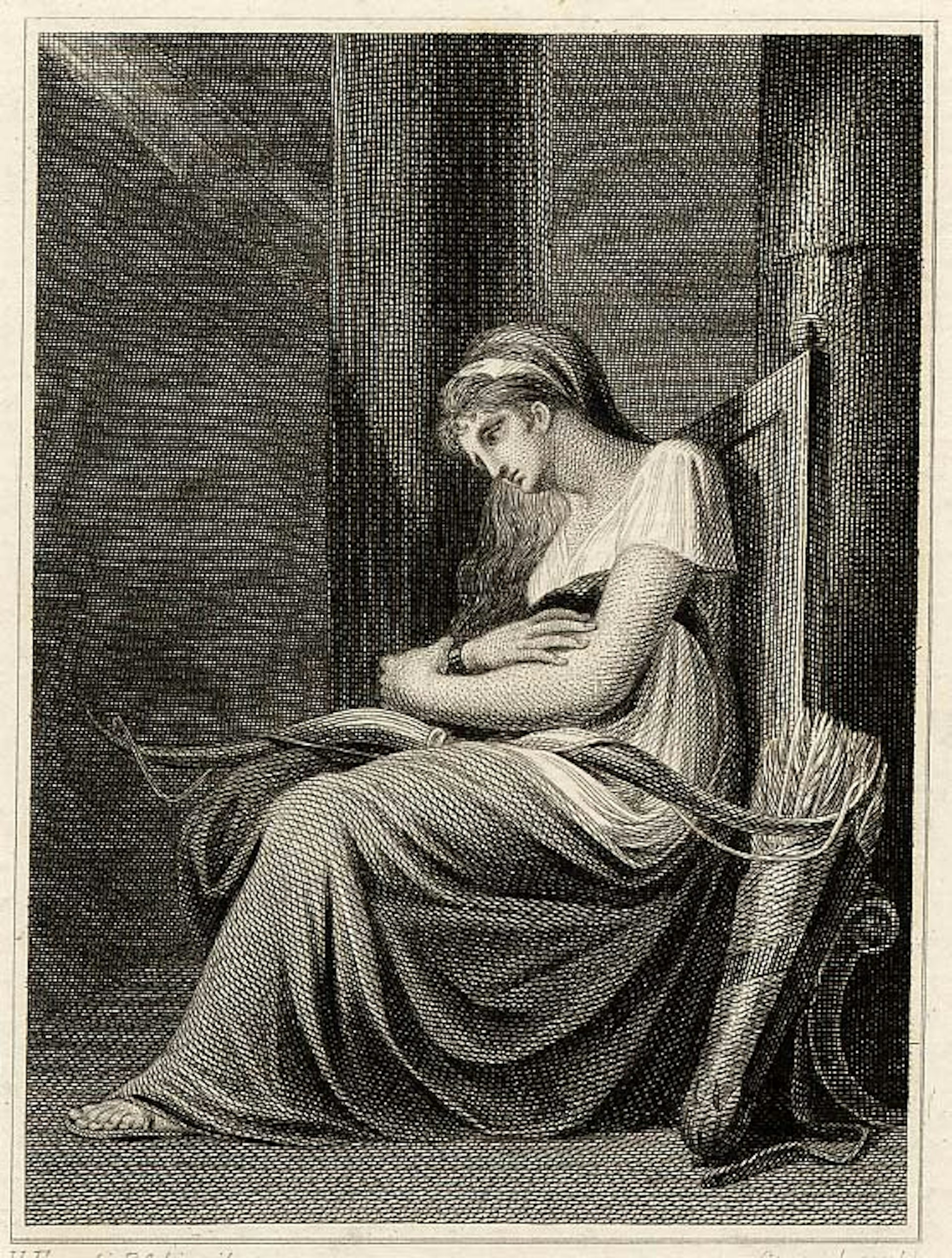
Penelope Holding the Bow of Odysseus by Robert Hartley Cromek after Henry Fuseli (1806)
Throughout the epic, Homeris often remarkably metaliterary or metapoetic; in other words, the Odyssey embeds numerous sub-narratives within the overarching frame narrative. Some of these are told by poets such as Phemius (Book 1) or Demodocus (Book 8), but the most famous internal narrative comes from Odysseus himself, whose story spans four books of the Odyssey . The Odyssey is thus a sophisticated meditation on the nature of storytelling and poetry.
The impact of Homer’s poems cannot be overestimated. The Iliad and the Odyssey have been essential to Greek cultural and religious identity practically since their inception, and they exerted a huge influence on the Romans as well. These texts became the basis for all subsequent hexameter and elegiac poetry; all ancient epics, from Apollonius of Rhodes’ Argonautica to Virgil’s Aeneid to Nonnus’ Dionysiaca , were in some way a response to Homer. Homer was also central to the development of ancient drama, with Aeschylus reportedly describing his own tragedies as “crumbs from Homer’s feast.” Indeed, many have dubbed Homer the father of tragedy.
Already in antiquity, the Odyssey was influencing individual poems as well as whole genres (such as the Alexandrian novels, which became popular in the first century CE). The Odyssey also played a formative role in Latin literature; Livius Andronicus’ Latin translation of the Odyssey around 241 BCE is widely cited as the first true work of Latin literature. Scenes from the Odyssey were extremely popular in ancient art as well.
Medieval, Renaissance, and Early Modern Europe
During the Middle Ages and Renaissance, the Iliad and the Odyssey became the heart of the Western literary and artistic canon. Numerous translations and adaptations of the Odyssey were produced during this period. In Dante Alighieri’s Inferno , for example, the narrator meets Odysseus in the eighth circle of Hell.
The Odyssey continued to influence later European literary figures, including William Shakespeare, John Milton, and Alfred Tennyson. More recently, James Joyce’s novel Ulysses (1922) reworked the narratives and themes of the Odyssey in a modern context. In 1938, the Greek author Nikos Kazantzakis published his masterful epic Odyssey: A Modern Sequel , which picks up the story of Odysseus where Homer left off.
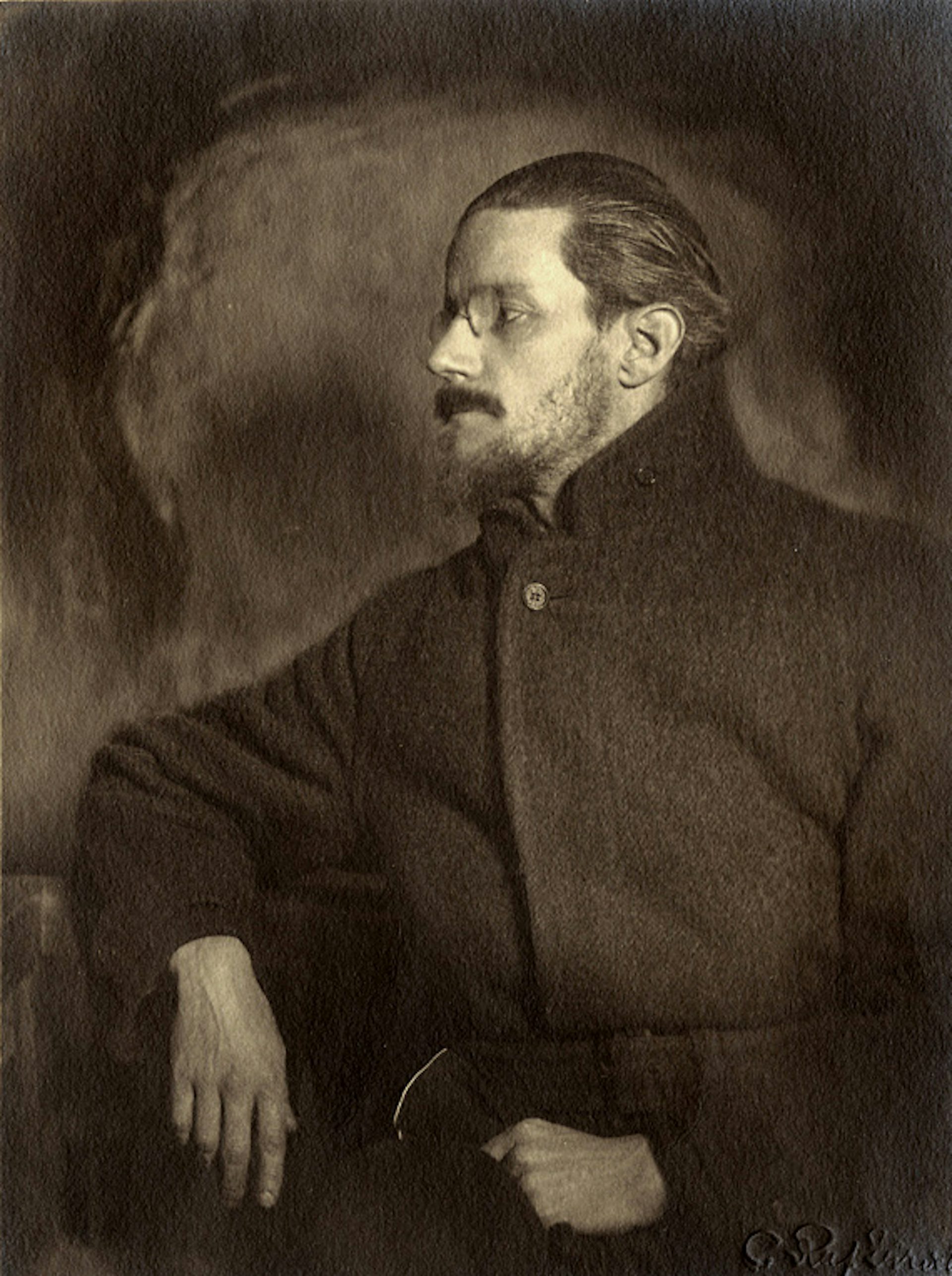
James Joyce, photographed in Zurich by Camille Ruf (ca. 1918)
Scenes from the Odyssey have also captured the imagination of artists such as Jacques-Louis David, Jean-Auguste-Dominique Ingres, William Theed the Elder, and many more.
Pop Culture
The Odyssey remains prominent in contemporary pop culture. It has inspired numerous works of literature, including novels by Margaret Atwood and Madeline Miller. It has also been adapted into films, miniseries, and TV shows, among them the 1954 film Ulysses and the 1997 miniseries The Odyssey .
Translations
There have been numerous English translations of Homer’s Odyssey , many of them dating back hundreds of years. The following is a selected chronological list of important and useful translations:
Pope, Alexander, trans. The Odyssey of Homer . London: Bowyer, 1725: A fluid translation of the Odyssey in rhyming couplets. Still popular today, though known to contain many artistic liberties and inaccuracies.
Butler, Samuel, trans. The Iliad of Homer . London: Longmans, Green, and Co., 1900: An old prose translation of the Odyssey , still widely known and used today.
Murray, A. T., trans. Homer: Odyssey . 2 vols. Loeb Classical Library 104–5. Cambridge, MA: Harvard University Press, 1919: An old-fashioned, literal translation. Useful, but not the most readable. Revised by George E. Dimock and reprinted in 1995.
Rieu, E. V., trans. Homer: The Odyssey . London: Penguin, 1946: Prose translation; somewhat formal and dated.
Fitzgerald, Robert, trans. The Odyssey . New York: Doubleday, 1961: An elegant literary translation in blank verse. Popular, but with some creative liberties. Reprinted by Farrar, Straus, and Giroux in 1998.
Lattimore, Richmond, trans. The Odyssey of Homer . Chicago: University of Chicago Press, 1965: Verse translation in a meter very close to Homer’s original dactylic hexameter. Still highly regarded and very true to the original. Reprinted in 2002.
Fagles, Robert, trans. Homer: Odyssey . New York: Viking, 1996: Very modern, readable, and fast-paced verse translation. Popular with general readers and undergraduates.
Hammond, Martin, trans. Homer: The Odyssey . London: Duckworth, 2000: Clear, accurate prose translation.
Lombardo, Stanley, trans. The Odyssey .Hackett Classics. Indianapolis: Hackett, 2000: Accurate and accessible verse translation.
Merrill, Rodney, trans. Homer: The Odyssey . Ann Arbor: University of Michigan Press, 2002: Musical translation written in dactylic hexameter, the same verse employed in the original.
Powell, Barry, trans. Homer: The Odyssey . Oxford: Oxford University Press, 2014: Accurate verse translation, though regarded as somewhat prosaic at times.
Wilson, Emily, trans. Homer: The Odyssey . New York: Norton, 2017: Well-received verse translation. The first translation of the Odyssey completed by a woman.
Green, Peter, trans. The Odyssey . Berkeley: University of California Press, 2018: Lively, often colloquial translation that remains accurate to the original.
The best free cultural &
educational media on the web
- Online Courses
- Certificates
- Degrees & Mini-Degrees
- Audio Books
Odyssey ">An Interactive Map of Odysseus’ 10-Year Journey in Homer’s Odyssey
in Literature , Maps | December 16th, 2013 14 Comments
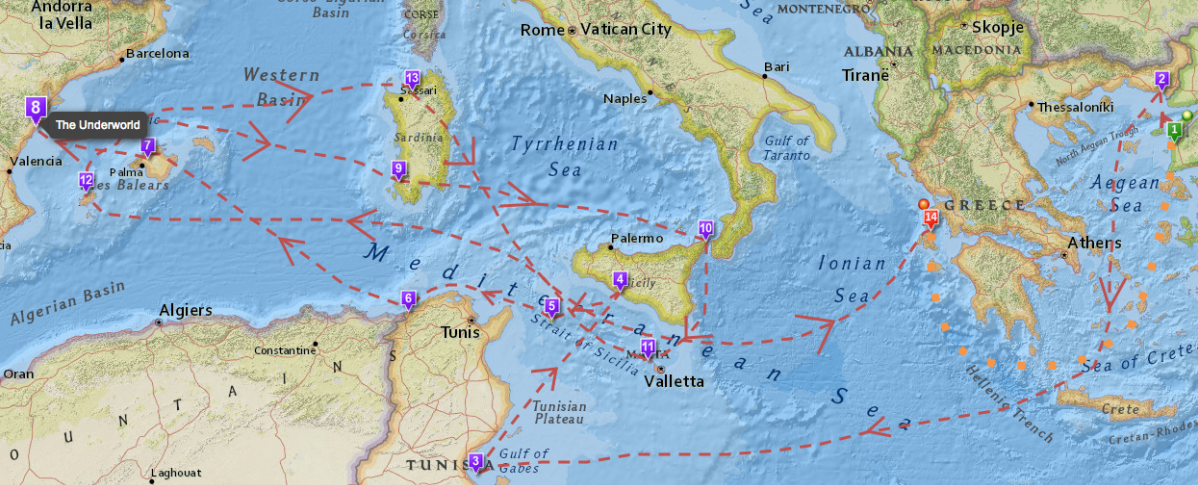
The Odyssey , one of Homer’s two great epics, narrates Odysseus’ long, strange trip home after the Trojan war . During their ten-year journey, Odysseus and his men had to overcome divine and natural forces, from battering storms and winds to difficult encounters with the Cyclops Polyphemus, the cannibalistic Laestrygones, the witch-goddess Circe and the rest. And they took a most circuitous route, bouncing all over the Mediterranean, moving first down to Crete and Tunisia. Next over to Sicily, then off toward Spain, and back to Greece again.
If you’re looking for an easy way to visualize all of the twists and turns in The Odyssey, then we’d recommend spending some time with the interactive map created by Gisèle Mounzer . “Odysseus’ Journey” breaks down Odysseus’ voyage into 14 key scenes and locates them on a modern map designed by Esri, a company that creates GIS mapping software.
Meanwhile, if you’re interested in the whole concept of ancient travel, I’d suggest revisiting one of our previous posts: Play Caesar: Travel Ancient Rome with Stanford’s Interactive Map . It tells you all about ORBIS , a geospatial network model, that lets you simulate journeys in Ancient Roman. You pick the points of origin and destination for a trip, and ORBIS will reconstruct the duration and financial cost of making the ancient journey. Pretty cool stuff.
If you would like to sign up for Open Culture’s free email newsletter, please find it here . Or follow our posts on Threads , Facebook , BlueSky or Mastodon .
If you would like to support the mission of Open Culture, consider making a donation to our site . It’s hard to rely 100% on ads, and your contributions will help us continue providing the best free cultural and educational materials to learners everywhere. You can contribute through PayPal , Patreon , and Venmo (@openculture). Thanks!
Related Content:
Hear Homer’s Iliad Read in the Original Ancient Greek
What Ancient Greek Music Sounded Like: Hear a Reconstruction That is ‘100% Accurate’
Discover the “Brazen Bull,” the Ancient Greek Torture Machine That Doubled as a Musical Instrument
Learning Ancient History for Free
by OC | Permalink | Comments (14) |
Related posts:
Comments (14), 14 comments so far.
Pretty pictures, “interactive,” but no indication of the sources of the localizations or method. A great example of the vapidity of internet technology when used aimlessly. For a theorized and researched approach to the wanderings of Odysseus, see the site “In the Wake of Odysseus” by J. Burgess
This is a good map I tried screenshoting for my project but it didn’t let me.
Works terribly on my tablet, but then, so does this site.
This map contains an important omission:nOdysseusu2019s near return to Ithaca.nn In Bookn10 of The Odyssey Odysseus and his men, carrying the leather sack in which Aeolus had confined the winds and carried by a fair wind from the west,come within sight of Ithaca. “u201cFor nine days we sailed, night and day alike, and now on the tenth our native land came in sight, and lo, we were so near that we saw men tending the beacon fires. (28 ff. Translation A.T. Murray).Then, of course, Odysseus falls asleep and his men open the sack allowing the winds to escape and blow them all the way back to the city of Aeolus. That they had come so close to home in space and end up so far from it not only in space but in time has always struck me as one of the most poignant episodes in the poem. This map includes no indication whatsoever of that part of the journey. (Peter D. Grudin)
It should be remarked that this is just one of many possible spatial interpretations of Odysseus’ trip.
Ako se oslanjamo na Homerovu Odiseju onda ova teorija ne odgovara. Primer Kiklopova pećina na Siciliji je toloiko mala da taj događaj nije mogao da se odigra.Odisej je plovio Okean Rekom tj . Jadranom čija ostrva i danas imaju stare Grčke nazive. U Grapčevoj pećini na Hvaru pronađen je isti broj ljuskih kostura koliko je Polifem pojeo Odisejevih ljudi. Toponimi vetrovi položaj zvezda i daljine se u potpunosti poklapaju sa Jadranskim morem.
I think some of these localizations here are really far-fetched.
i had to do this for my school and it isnt interactive and i cannot find Ogygia or anythig like that. please fix this so others who come to this site arent disappointed like i am
I think that the map is a great resource for teaching, and maybe that is its aim or objective. Of course, I am now interested in the reference given: ” In the wake of Odysseus” but nevertheless, is important to interact with this places and to see them in a map and to make students know where the action took place. All is perfectible, I congratulate the effort taken by the author Gisele Mounzer. The map is not only useful but beautiful.
Homer is quite clear in the number of days Odysseus travels, the wind direction and the type of craft he is using. As a seafarer one can put all this together and do a passage plan of his journeys, as I have done in my book ‘The Odysseus Code’. For example, the distance Odysseus travels between Ogygia and the land of the Phaeacians makes it impossible for Scheria to be Corfu or even for Ogygia to be within the Mediterranean. He sails from Ogygia for 17 days non-stop (i.e. 408 hours)in an easterly direction. At less than 2.5 nautical miles per hour he would not have had steerage way on such a heavy craft — work it out! Homer even tells us what type of craft it was as we have a detailed description of its construction. But this way of tackling the question is ignored by academics who insist on placing all the journeys within the Mediterranean Sea because they relate the story to the Greeks of the Bronze Age whereas Homer is incorporating the myths and legends of the more ancient and more nautically capable Phoenicians and Minoans whose skills were largely lost after the upheaval of the Thera volcano around 1500 BC.
Too many mistakes.
did not even work
did not even work boi
How does one map where a floating island (i.e. Aeolia) was?
Add a comment
Leave a reply.
Name (required)
Email (required)
XHTML: You can use these tags: <a href="" title=""> <abbr title=""> <acronym title=""> <b> <blockquote cite=""> <cite> <code> <del datetime=""> <em> <i> <q cite=""> <s> <strike> <strong>
Click here to cancel reply.
- 1,700 Free Online Courses
- 200 Online Certificate Programs
- 100+ Online Degree & Mini-Degree Programs
- 1,150 Free Movies
- 1,000 Free Audio Books
- 150+ Best Podcasts
- 800 Free eBooks
- 200 Free Textbooks
- 300 Free Language Lessons
- 150 Free Business Courses
- Free K-12 Education
- Get Our Daily Email
Free Courses
- Art & Art History
- Classics/Ancient World
- Computer Science
- Data Science
- Engineering
- Environment
- Political Science
- Writing & Journalism
- All 1500 Free Courses
- 1000+ MOOCs & Certificate Courses
Receive our Daily Email
Free updates, get our daily email.
Get the best cultural and educational resources on the web curated for you in a daily email. We never spam. Unsubscribe at any time.
FOLLOW ON SOCIAL MEDIA
Free Movies
- 1150 Free Movies Online
- Free Film Noir
- Silent Films
- Documentaries
- Martial Arts/Kung Fu
- Free Hitchcock Films
- Free Charlie Chaplin
- Free John Wayne Movies
- Free Tarkovsky Films
- Free Dziga Vertov
- Free Oscar Winners
- Free Language Lessons
- All Languages
Free eBooks
- 700 Free eBooks
- Free Philosophy eBooks
- The Harvard Classics
- Philip K. Dick Stories
- Neil Gaiman Stories
- David Foster Wallace Stories & Essays
- Hemingway Stories
- Great Gatsby & Other Fitzgerald Novels
- HP Lovecraft
- Edgar Allan Poe
- Free Alice Munro Stories
- Jennifer Egan Stories
- George Saunders Stories
- Hunter S. Thompson Essays
- Joan Didion Essays
- Gabriel Garcia Marquez Stories
- David Sedaris Stories
- Stephen King
- Golden Age Comics
- Free Books by UC Press
- Life Changing Books
Free Audio Books
- 700 Free Audio Books
- Free Audio Books: Fiction
- Free Audio Books: Poetry
- Free Audio Books: Non-Fiction
Free Textbooks
- Free Physics Textbooks
- Free Computer Science Textbooks
- Free Math Textbooks
K-12 Resources
- Free Video Lessons
- Web Resources by Subject
- Quality YouTube Channels
- Teacher Resources
- All Free Kids Resources
Free Art & Images
- All Art Images & Books
- The Rijksmuseum
- Smithsonian
- The Guggenheim
- The National Gallery
- The Whitney
- LA County Museum
- Stanford University
- British Library
- Google Art Project
- French Revolution
- Getty Images
- Guggenheim Art Books
- Met Art Books
- Getty Art Books
- New York Public Library Maps
- Museum of New Zealand
- Smarthistory
- Coloring Books
- All Bach Organ Works
- All of Bach
- 80,000 Classical Music Scores
- Free Classical Music
- Live Classical Music
- 9,000 Grateful Dead Concerts
- Alan Lomax Blues & Folk Archive
Writing Tips
- William Zinsser
- Kurt Vonnegut
- Toni Morrison
- Margaret Atwood
- David Ogilvy
- Billy Wilder
- All posts by date
Personal Finance
- Open Personal Finance
- Amazon Kindle
- Architecture
- Artificial Intelligence
- Comics/Cartoons
- Current Affairs
- English Language
- Entrepreneurship
- Food & Drink
- Graduation Speech
- How to Learn for Free
- Internet Archive
- Language Lessons
- Most Popular
- Neuroscience
- Photography
- Pretty Much Pop
- Productivity
- UC Berkeley
- Uncategorized
- Video - Arts & Culture
- Video - Politics/Society
- Video - Science
- Video Games
Great Lectures
- Michel Foucault
- Sun Ra at UC Berkeley
- Richard Feynman
- Joseph Campbell
- Jorge Luis Borges
- Leonard Bernstein
- Richard Dawkins
- Buckminster Fuller
- Walter Kaufmann on Existentialism
- Jacques Lacan
- Roland Barthes
- Nobel Lectures by Writers
- Bertrand Russell
- Oxford Philosophy Lectures
Sign up for Newsletter
Open Culture scours the web for the best educational media. We find the free courses and audio books you need, the language lessons & educational videos you want, and plenty of enlightenment in between.
Great Recordings
- T.S. Eliot Reads Waste Land
- Sylvia Plath - Ariel
- Joyce Reads Ulysses
- Joyce - Finnegans Wake
- Patti Smith Reads Virginia Woolf
- Albert Einstein
- Charles Bukowski
- Bill Murray
- Fitzgerald Reads Shakespeare
- William Faulkner
- Flannery O'Connor
- Tolkien - The Hobbit
- Allen Ginsberg - Howl
- Dylan Thomas
- Anne Sexton
- John Cheever
- David Foster Wallace
Book Lists By
- Neil deGrasse Tyson
- Ernest Hemingway
- F. Scott Fitzgerald
- Allen Ginsberg
- Patti Smith
- Henry Miller
- Christopher Hitchens
- Joseph Brodsky
- Donald Barthelme
- David Bowie
- Samuel Beckett
- Art Garfunkel
- Marilyn Monroe
- Picks by Female Creatives
- Zadie Smith & Gary Shteyngart
- Lynda Barry
Favorite Movies
- Kurosawa's 100
- David Lynch
- Werner Herzog
- Woody Allen
- Wes Anderson
- Luis Buñuel
- Roger Ebert
- Susan Sontag
- Scorsese Foreign Films
- Philosophy Films
- February 2024
- January 2024
- December 2023
- November 2023
- October 2023
- September 2023
- August 2023
- February 2023
- January 2023
- December 2022
- November 2022
- October 2022
- September 2022
- August 2022
- February 2022
- January 2022
- December 2021
- November 2021
- October 2021
- September 2021
- August 2021
- February 2021
- January 2021
- December 2020
- November 2020
- October 2020
- September 2020
- August 2020
- February 2020
- January 2020
- December 2019
- November 2019
- October 2019
- September 2019
- August 2019
- February 2019
- January 2019
- December 2018
- November 2018
- October 2018
- September 2018
- August 2018
- February 2018
- January 2018
- December 2017
- November 2017
- October 2017
- September 2017
- August 2017
- February 2017
- January 2017
- December 2016
- November 2016
- October 2016
- September 2016
- August 2016
- February 2016
- January 2016
- December 2015
- November 2015
- October 2015
- September 2015
- August 2015
- February 2015
- January 2015
- December 2014
- November 2014
- October 2014
- September 2014
- August 2014
- February 2014
- January 2014
- December 2013
- November 2013
- October 2013
- September 2013
- August 2013
- February 2013
- January 2013
- December 2012
- November 2012
- October 2012
- September 2012
- August 2012
- February 2012
- January 2012
- December 2011
- November 2011
- October 2011
- September 2011
- August 2011
- February 2011
- January 2011
- December 2010
- November 2010
- October 2010
- September 2010
- August 2010
- February 2010
- January 2010
- December 2009
- November 2009
- October 2009
- September 2009
- August 2009
- February 2009
- January 2009
- December 2008
- November 2008
- October 2008
- September 2008
- August 2008
- February 2008
- January 2008
- December 2007
- November 2007
- October 2007
- September 2007
- August 2007
- February 2007
- January 2007
- December 2006
- November 2006
- October 2006
- September 2006
©2006-2024 Open Culture, LLC. All rights reserved.
- Advertise with Us
- Copyright Policy
- Privacy Policy
- Terms of Use

- Repeated Customers
- Booking Request
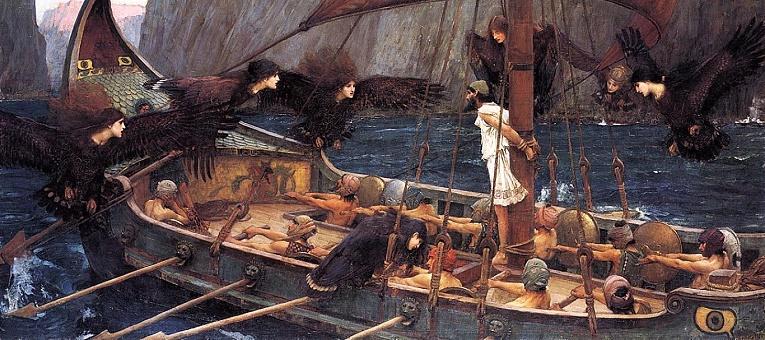
One hell of a sailor
Odysseus , a legendary hero and an ingenious man...
After his catalytic contribution to the Trojan War , with his inspiration of the Trojan Horse , a wooden structure which the Greeks used to infiltrate Troy, and a sample of our hero's strategic intelligence, the Trojan War comes to an end.
Odysseus begins his journey back to his homeland along with his comrades.
Tragically, after many adventures and losses, he is the only one who manages to return back to his homeland, Ithaca .
During his long voyage, Odysseus ' bravery and intelligence is proven many times over. But... was it bad luck that Odysseus ' unfortunate wandering lasted ten whole years, or was there a reason for this?
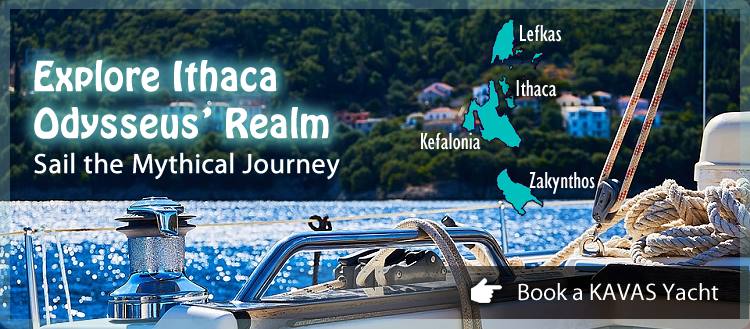
But... was Odysseus so unlucky after all, or there was a reason for this unfortunate wandering that lasted ten whole years?
THE ARDUOUS JOURNEY HOME
After the end of the Trojan war , Odysseus , like everyone else, began his long journey home, to the island of Ithaca. And yet, everyone managed to return to their loved ones except Odysseus who wandered for ten whole years through seas and countries far away from home, enduring many hardships until finally reaching Ithaca .
Starting from Troy , Odysseus had 12 ships at his disposal in which his comrades fought, and fell. This was of course no accident, seeing as the Gods of Olympus were very angry for the burning of their temples in Troy by the Greeks.
So, they sent their way strong and wild winds so as to punish them for their hubris by making their journey back home impossible.
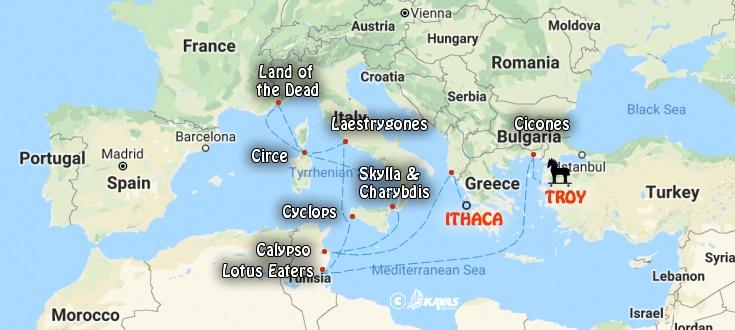
The Cicones
When Odysseus ’s ships were sailing in the Aegean, the gods sent wild winds to push them north into the land of the Cicones .
There, Odysseus and his men attack and fight some of the native Cicones , snatching animals and wine, and sitting by the beach to eat and drink. But when Odysseus tells his men that it is time to leave, they refuse, as the food is too good and the wine too sweet.
Shortly, all the Cicones gather and attack them together, killing many while the others quickly boarded the ships and left in a wild storm. Evidently, the lack of prudence and sobriety had cost many good men their very lives…
The lotus eaters
During their journey the strong winds blowing north pushed the ships away, in Africa . And so, Odysseus and his men arrived in the land of the Lotus Eaters .
Once ashore Odysseus sent three of his warriors to see what kind of people lived in this country. There, his men met the Lotus Eaters who offered them persimmons to eat, later revealed to be enchanted fruit!
Because of this enchantment, the men soon forgot their homeland and refused to leave the country of the Lotus Eaters.
Odysseus went to find them and took them back by force, immediately ordering the ships to sail.
According to Homer , it would seem to be quite a tragedy for someone to forget the place from which they came as well as their destination…

Polyphemus the Cyclops
Odysseus was known for being quick-witted even in the face of adversity.
After traveling for many days, the wind pushed their ships to the island of the Cyclops (Sicily).
After disembarking they went out and discovered a mighty cave close to the beach. Inside, they found milk, cheese, lambs and goats to eat.
But then Cyclops Polyphemus , son of Poseidon , who had only one eye, returned to his cave and discovered Odysseus and his men.
He shut the door of the cave with a huge rock and ate some of the men, saving the rest for later. The next day Odysseus offered Polyphemus sweet wine (the famous red wine, " Mavroudi " that is cultivated in several parts of Greece such as in Kea island ).
Nobody, is my name , he replied, and Polyphemus answered "You, Nobody, I will eat you last".
Then the Cyclop continued to drink until finally he fell asleep.
Odysseus then grabbed a branch and nailed it into the eye of Polyphemus. The Cyclop jumped up screaming and shouting for help.
The other Cyclops ran to his cave, "What happened, Polyphemus?", they asked. " Nobody blinded me !" answered Polyphemus .
"As nobody has blinded you, why are you shouting?" they wondered, and quickly left, making no sense of the Cyclop's words.
The next morning, blind Polyphemus opened the door of the cave and stood at the exit with his arms outstretched waiting to catch Odysseus and his men. But Odysseus, ingenious as he was, had tied his men under the bellies of the largest rams and he himself hung from the hair of the largest animal.
The Cyclop was stroking the rams' backs as they came out of the cave, and did not realize that there were people underneath.
When everyone was safely out of the cave, they ran to the ships and went away.
Island of Aeolus
Then they arrived to the island of Aeolus , the God of the winds . Aeolus welcomed them and hosted them for about a month.
When it was time for them to leave, the God Aeolus blessed Odysseus' journey with a favorable wind and handed him a sac where all the unfavorable ones were confined, so he could return immediately to Ithaca .
However, as they were approaching Ithaca , Odysseus' men opened the bag, causing a storm that destroyed 11 ships and swept away Odysseus to the island of Laestrygones .
Modern-day Greeks use the expression "opening the sac of Aeolus" to describe adverse situations with uncontrollable consequences (similar to the expression "opening a can of worms").
Fleeing the Laestrygonians
In the island of Laestrygonians Odysseus and his men were unwelcome.
As our hero and his comrades were approaching the harbor, the Laestrygonians , these wild and tall giants ran up against them, screaming and throwing boulders on the ships.
The rocks broke and sank the ships and the wild Laestrygonians ate all the men who were close. Only Odysseus' ship survived. He and his men quickly left the land of the wild Laestrygones.
The Sorceress Circe
The Greek hero and his men were driven to the island of Circe by the wind.
Odysseus then asked some of his men to go and ask where they were. The men soon found Circe ’s luxurious palace. Upon their arrival, the immortal sorceress offered them to feast and drink, unbeknownst to them that her goods would magically turn them into pigs , punishing them for their greedy appetite.
Only one of them managed to escape and went back to inform Odysseus. Without hesitation, he grabbed his sword and entered Circe 's palace, being immune to her magic with the help of god Hermes .
Amazed, Circe quickly became fond of Odysseus who eventually forced her to turn his comrades back to humans again.
They stayed in the island of Circe for a long time. When they decided to leave, Circe advised Odysseus to go to underworld and meet prophet Tiresias who would tell him how to get to Ithaca safely.
The Journey to the Underworld
Odysseus and his men arrived to underworld , a place no one ever dared trespass.
After a while the prophet Tiresias came to meet Odysseus and he asked the prophet what he has to do in order to get back home.
Tiresius said to him: "Poseidon hates you, because you blinded Cyclops Polyphemus, his son.
However, take care not to disturb the oxen of the Sun god, when you go to his island, and you will arrive at Ithaca one day".
The island of Sirens
Leaving underworld, Odysseus and his men were drawn to the island of Sirens .
Τhese zoomorphic creatures would enchant sailors with their sweet song and when they approach, they would eat them.
Fortunately, Circe had advised Odysseus to wax his men's ears so as to drown out the sirens' songs , and the men managed to escape the Sirens' call.
Scylla and Charybdis
They then approached the Strait of Scylla and Charybdis , the mythological sea monsters who made sailing through the strait almost impossible.
From one side of the narrow waterway, Charybdis would create whirlpools that would sink the ships, while on the other side, Skylla , curled up in her cave, would stretch out her six terrible heads, and eat the sailors.
"Caught between Scylla and Charybdis" as the proverb goes, Odysseus decided to pass by Charybdis , sacrificing some of his men instead of risking sinking his ship, this way choosing the lesser of two evils.
The cattle of Helios
After many nights at sea, Odysseus and his remaining comrades arrived to the island of the Sun god .
Remembering prophet Tiresias ' advice to stay clear of the oxen of the Sun god , Odysseus begged his men to leave the island. But they were very tired and did not accept.
When they ran out of food, they fasted for a few days. One day, however, when Odysseus was asleep, they slaughtered some oxen and roasted them. When Odysseus woke up it was too late.
Leaving the island of the Sun , Zeus (the father of all gods) sent them a wild storm. An asteroid hit the ship and shattered it. Everyone drowned. Only Odysseus escaped.
Holding onto a board, he spent ten whole nights in the sea until finally being taken to the island of nymph Calypso.
The immortal nymph Calypso took worn-out Odysseus to her cave and took care of him but would not let him go --keeping him prisoner for seven whole years, and dreaming to make him her immortal husband.
Finally, goddess Athena felt sorry for him and begged her father, Zeus , to help him.
Zeus sent Hermes (the messenger god) to Calypso and ordered her to let Odysseus go.
Our hero was once again on his way back home.
Back in Ithaca
After ten years of hardship , Odysseus finally arrives to Ithaca .
Once there, the goddess Athena approached him and informed him that his palace was filled with many suitors who wished to marry his wife, Penelope . Only she was waiting patiently for him to return.
Odysseus then entered his palace, seeing all the suitors eating and drinking. Meanwhile, Athena put it in Penelope's mind to bring the bow of Odysseus , his arrows and twelve axes, which had a hole at the top.
Penelope ordered for the axes to be set in order, and made an announcement:
“Listen, Suitors! Whoever manages to bend the string of this bow and throw an arrow, which will pass through the holes of the twelve axes, he will become my husband".
Eager, all the suitors, one after the other, began to try, but no one was able to stretch the string. Odysseus then asked to be tested as well.
He grabbed the bow, bent the string and threw an arrow, which passed like lightning through the holes of all the axes.
The moment Penelope realizes the winner is in fact her long-lost husband is undoubtedly one of the best part of the Odyssey .
Lessons from The Odyssey: Perseverance, Strategy, and Collaboration
The epic poem The Odyssey by Homer is one of the most enduring works of literature in the Western canon.
It tells the story of Odysseus, a hero who embarks on a perilous journey home after the Trojan War.
Along the way, he faces numerous challenges, overcomes incredible odds, and learns valuable lessons that are still relevant today.
In particular, we can learn from his perseverance in the face of adversity, his strategic thinking in overcoming obstacles, and his collaborative approach to working with others.
These three lessons - perseverance , strategy , and collaboration - are essential for anyone seeking to navigate the challenges of life and achieve their goals.
1. The value of patience and perseverance in difficult times.
The first lesson we can learn from the adventures of Odysseus is the value of patience and perseverance in difficult times.
Throughout his journey, Odysseus faced many obstacles and challenges, but he never gave up .
Instead, he remained patient , determined , and focused on his ultimate goal of returning home to his family.
His unwavering commitment to his mission serves as a powerful reminder that even in the face of adversity, we must stay strong and resilient, and have faith that we can overcome any challenge.
2. The importance of strategy and wisdom in facing challenges
Throughout his journey, Odysseus encountered many challenges that he could not overcome through strength alone.
Instead, he relied on his strategic thinking and wisdom to outsmart his enemies and overcome the obstacles in his path.
This highlights the importance of having a well-thought-out plan , being adaptable , and using one's intelligence and knowledge to navigate difficult situations.
3. The importance of collaboration, communication, and listening to others
Throughout his journey, Odysseus learned the value of working together with others, communicating effectively , and listening to their perspectives .
This helped him to build alliances, gain new knowledge and insights, and ultimately, achieve his goals.
This highlights the importance of collaboration, empathy, and understanding in achieving success, and shows us that by working together and valuing the contributions of others, we can accomplish great things.
The moral of the story is simple: Have faith and keep on going .
- Old World Gods
Greek Mythology Odysseus: The Epic Journey of the Brave Hero
In Greek mythology , Odysseus, also known as Ulisses, is a prominent character and the hero of Homer’s epic poem, the Odyssey. He was the king of Ithaca, known for his bravery, intelligence, and leadership.
Odysseus played a crucial role in the Trojan War and embarked on a journey filled with trials and adventures. Upon his return to Ithaca, he faced challenges at home but ultimately reclaimed his kingdom.
Odysseus’ story has become synonymous with epic journeys and courage.
The journey of Odysseus is filled with encounters with mythical creatures and tests of his strength and wit. From his confrontation with the Cyclops Polyphemus to navigating the treacherous Scylla and Charybdis , Odysseus overcame countless perils.
Back in Ithaca, he had to confront the suitors who invaded his home and prove his rightful place as the ruler. With the help of his son and the goddess Athena , Odysseus emerged victorious.
Sources and References: Various Greek texts, including Homer’s Odyssey, and scholarly books on Greek mythology .
Content of this Article
The Story of Odysseus in Greek Mythology
The story of Odysseus, the brave hero of the Trojan War, is a tale filled with adventure, resilience, and the triumph of the human spirit. From his valiant efforts in battle to his enduring love for his wife Penelope, Odysseus is a captivating figure in Greek mythology .
Let’s explore the different aspects of his story:
Odysseus: The Brave Hero of the Trojan War
Odysseus, also known as Ulisses, was renowned for his leadership, bravery, and tactical genius in the Trojan War. His clever strategies, such as the iconic wooden horse, played a pivotal role in the Greek victory over the Trojans.
Odysseus’s unwavering determination and unwavering loyalty to his comrades made him a true hero.
Odysseus’ Wife: Penelope’s Faithful Love
Penelope, Odysseus’s wife, exemplifies faithful love and resilience. During her husband’s long absence, she cleverly avoided the persistent suitors who sought her hand in marriage. Penelope’s undying loyalty to Odysseus and her unwavering hope of his return make her a symbol of devotion and steadfastness.
Odysseus and Circe : The Enchanting Sorceress
Download for FREE here our best selection of Images of the Mythology Gods and Goddesses!
Odysseus’s encounter with the sorceress Circe is a fascinating part of his journey. Circe , with her magical powers, lured Odysseus and his men to her island. However, Odysseus’s wit and cunning allowed him to outsmart Circe and secure his crew’s release from her enchantments.
This encounter highlights Odysseus’s ability to navigate treacherous situations using his intelligence.
Odysseus’ Son: Telémachus’ Journey to Manhood
Telémachus, Odysseus’s son, embarked on a transformative journey to seek information about his father’s fate. With the guidance of Athena , the goddess of wisdom, Telémachus traveled from island to island, encountering various challenges and learning important lessons.
His courageous pursuit of the truth showcases his growth from a young man to a capable and determined individual.
Throughout the story of Odysseus, his strength, intellect, and perseverance shine as he faces formidable obstacles and longs for his homeland.
The tale of his odyssey continues to captivate audiences, offering a timeless exploration of heroism and the human spirit.
The Journey of Odysseus
The Journey of Odysseus is a legendary tale filled with trials, adventures, and notable encounters. Throughout his arduous journey, Odysseus faced numerous struggles and triumphed over them with his wits and courage.
Trials and Adventures: Odysseus’ Struggles and Triumphs
Odysseus encountered a series of trials and adventures on his way back to Ithaca. From facing the seductive Lotus-Eaters to the perilous challenges posed by the Cyclops Polyphemus , each obstacle tested Odysseus’ resolve and resourcefulness.
His ability to outwit and strategize against formidable foes allowed him to overcome these challenges and continue his journey homeward.
Encounter with the Lotus-Eaters and Other Perils
One of the notable encounters in Odysseus’ journey was with the Lotus-Eaters, a group that tempted his crew with their addictive fruit, causing them to forget their mission. With his determination, Odysseus managed to rescue his men and move on to face other perils, such as the temptations of the enchantress Circe and the treacherous Sirens . Through his cleverness and steadfastness, Odysseus navigated through these dangers and forged ahead on his quest.
Confrontation with the Cyclops Polyphemus
One of the most famous episodes in Odysseus’ journey was his confrontation with Polyphemus , the Cyclops . In order to escape the clutches of the one-eyed giant, Odysseus devised a cunning plan.
By blinding Polyphemus , he managed to free himself and his companions, leaving the enraged monster helplessly searching for revenge. This triumph showcased Odysseus’ strategic thinking and bravery in the face of immense danger.
Navigating Scylla and Charybdis
As Odysseus sailed through treacherous waters, he encountered the dual perils of Scylla , a six-headed monster, and Charybdis, a deadly whirlpool. He had to make a difficult choice between risking the lives of his crew by sailing closer to Scylla or facing the threat of being devoured by Charybdis’ whirlpool.
Despite the inevitable loss, Odysseus made the strategic decision to navigate through Scylla ’s path, prioritizing the safety of his men. This moment exemplified his leadership and sacrifice for the greater good.
Odysseus’ journey was a test of his character and resilience. Each trial and encounter showcased his ability to navigate through adversity using his intelligence, bravery, and determination. The fascinating and epic tale of Odysseus’ journey continues to captivate audiences even in the present day, as his story remains an enduring symbol of heroic perseverance.
Return to Ithaca
After nearly a decade of trials and adventures, Odysseus embarked on his long-awaited journey back to his homeland of Ithaca. However, his return was not without its challenges.
Challenges at Home: Odysseus’ Battle Against the Suitors
Upon arriving in Ithaca, Odysseus discovered that his palace had been invaded by numerous suitors vying for his wife Penelope’s hand in marriage.
These suitors displayed disrespect and arrogance, consuming Odysseus’ resources and mistreating his loyal servants.
Odysseus, with the guidance of his son Telemachus, devised a plan to reclaim his kingdom. He disguised himself as a beggar and entered his own palace, observing the suitors’ behavior and testing their loyalty.
After proving his strength and skill, Odysseus engaged in a fierce battle against the suitors, ultimately emerging victorious.
Reunion with Penelope: True Love Prevails
Throughout his absence, Penelope remained faithful to Odysseus, resisting the suitors’ advances with unwavering devotion. When Odysseus revealed his true identity to Penelope, their reunion was filled with joy, relief, and love.
Their enduring love and trust served as a testament to the power of fidelity and the deep connection between Odysseus and Penelope.
Restoration of Odysseus’ Kingdom: Victory and Justice
Having vanquished the suitors, Odysseus set out to restore order and establish justice in Ithaca. He purged the palace of disloyal servants and punished those who had conspired against him and his family.
To solidify his authority, Odysseus revealed himself to the people of Ithaca as their rightful king. His reign brought prosperity, peace, and stability to the land he fought so hard to reclaim.
Odysseus in Greek and Roman Mythology
Odysseus, the legendary hero of Greek mythology , played a significant role in the Iliad and the Trojan War. His cunning tactics and strategic mind were instrumental in the Greek victory over Troy.
As depicted by Homer, Odysseus showcased his bravery and leadership skills in various military engagements, earning him a reputation as a formidable warrior.
Role of Odysseus in the Iliad and the Trojan War
In the Iliad, Odysseus emerged as a key figure among the Greek forces during the Trojan War.
Known for his diplomatic skills and eloquence, he played a vital role in several critical events, including the assembly of the Greek army, the reconciliation between Achilles and Agamemnon , and the strategic deployment of soldiers.
Odysseus’ clever plans and insightful advice contributed greatly to the final Greek victory.
Comparison of the Original Epic and the Odyssey
The Odyssey, a separate epic poem attributed to Homer, focuses specifically on the post-war journey of Odysseus. This remarkable narrative showcases his challenges and adventures as he attempts to return to his homeland, Ithaca.
Contrasting with the war-oriented Iliad, the Odyssey delves into the personal trials and transformations of Odysseus, highlighting his resilience, intelligence, and quest for self-discovery.
Influence of Odysseus in Ancient Greek and Roman Culture
Odysseus’ legend extends beyond the confines of Greek mythology .
His character had a profound impact on both ancient Greek and Roman cultures, serving as a symbol of courage, cunning, and the pursuit of journey and knowledge. Artists, poets, and writers drew inspiration from Odysseus, depicting him in various works of literature, art, and sculpture.
His name and story have become synonymous with bravery and resourcefulness throughout history.
Sources and References
When exploring the rich world of Greek mythology and the captivating story of Odysseus, it is important to refer to various reliable sources and references. These sources provide valuable insights and interpretations of the epic journey and heroic exploits of Odysseus.
1. Homer’s Odyssey : The primary and most influential source is the epic poem itself, written by the legendary poet Homer. It details the trials and tribulations faced by Odysseus during his ten-year journey back to Ithaca from Troy.
2. Ancient Greek Literature: Numerous ancient Greek texts, such as the works of Hesiod, Pausanias, and Apollodorus, provide additional information about Odysseus’ adventures, genealogy, and interactions with other mythical characters.
Ancient Art and Sculptures: The artwork and sculptures of ancient Greece offer visual representations of Odysseus and his renowned exploits, showcasing his cunning tactics and bravery on various vases, murals, and statues.
4. Classical Commentaries: Works by ancient scholars and philosophers, including Plutarch, Strabo, and Aristotle, offer valuable commentary and analysis regarding the character of Odysseus and the symbolic meaning behind his adventures.
5. Modern Interpretations: Contemporary literary works, critical essays, and academic research provide new perspectives and interpretations of the epic journey of Odysseus, shedding light on different themes and psychological aspects that relate to his character.
6. Archaeological Discoveries: Archaeological excavations in ancient Greek sites, such as Troy, Ithaca, and Mycenae, have unearthed artifacts and structures that provide tangible evidence and a deeper understanding of the historical context surrounding Odysseus and the world in which he lived.
7. Scholarly Books and Journals: Academic publications by experts in the field of Greek mythology and ancient literature provide comprehensive analysis, in-depth research, and scholarly discussions about Odysseus, his journey, and his significance within the larger context of Greek mythology .
By consulting these sources and references, we can delve into the fascinating world of Odysseus and gain a more comprehensive understanding of his adventures, his role in Greek mythology , and the enduring legacy he has left behind.
Gods and Goddesses By Pantheon
Challenge the gods in our quizzes, more than 3500 images a single click away.
Download any of our Mythology Bundles of the world!
Get your images here!
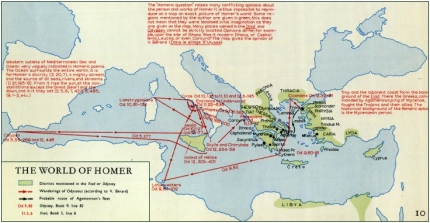
Home — Guides — The Odyssey — Exploring The Odyssey: A Comprehensive Introduction
- Introduction
- All Plot summary
- Full Summary
- By Sections
- All Characters
- Hospitality
- Pride and Temptation
- Fate and Free Will
- All Literary Devices
- By Character
- All Infographics
- Character Map
- Odysseus Strengths and Weaknesses
- Hero’s Journey
- Biography of author
The Odyssey: Introduction

The Odyssey, written by Homer, is an epic poem that is widely regarded as a masterpiece of ancient Greek literature. It tells the story of the Greek hero Odysseus and his ten-year journey home from the Trojan War. The poem is a testament to Homer's skill as a storyteller, and it is an important work in Western literature.
One of the most striking aspects of The Odyssey is its portrayal of the ancient Greek gods and their interactions with mortal humans. The gods play an active role in the lives of the characters, and they often intervene in human affairs to achieve their own ends. For example, the goddess Athena helps Odysseus throughout his journey, while the sea god Poseidon opposes him. These divine interventions serve to reinforce the themes of fate and destiny that are central to the poem.
Another important theme in The Odyssey is the idea of hospitality, or xenia. The ancient Greeks placed great value on hospitality, and it was considered a duty to welcome and care for strangers who arrived in one's home. This theme is present throughout the poem, as Odysseus is welcomed and cared for by various hosts along his journey. However, the theme is also complicated by the fact that Odysseus himself is often a guest who brings trouble and danger to his hosts.
The Odyssey is also notable for its use of symbolism and metaphor. For example, the journey of Odysseus can be seen as a metaphor for the journey of life, with its many trials and tribulations. The various characters and creatures that Odysseus encounters along his journey can also be seen as symbols of different aspects of human nature, such as greed, lust, and pride.
One of the most memorable sections of The Odyssey is the encounter between Odysseus and the Cyclops Polyphemus. This episode is notable for its use of suspense and tension, as Odysseus and his men are trapped in the Cyclops' cave and must devise a plan to escape. The episode also highlights the themes of cunning and wit, as Odysseus outsmarts the Cyclops by blinding him and then escaping under the bellies of his sheep.
The poem also includes several memorable female characters, which is unusual for ancient Greek literature. Penelope, the wife of Odysseus, is a strong and resourceful woman who holds her own against the suitors who are vying for her hand in marriage. Circe, the sorceress who turns some of Odysseus' men into pigs, is also a powerful figure who commands great respect. These female characters challenge the traditional gender roles of ancient Greece and provide a more nuanced view of women's roles in society.
In terms of its structure, The Odyssey is divided into 24 books, each of which tells a different part of Odysseus' journey. The poem is written in dactylic hexameter, a form of meter that is characteristic of ancient Greek poetry. The language is rich and poetic, with many metaphors, similes, and allusions to other works of literature. The poem is also notable for its use of repetition and formulaic language, which was a common feature of ancient Greek oral poetry.
Overall, The Odyssey is a complex and multifaceted work that offers insights into ancient Greek culture and mythology. It is a testament to Homer's skill as a storyteller, and it has had a profound influence on Western literature and culture. The themes of fate, destiny, hospitality, and cunning continue to resonate with readers today, and the characters and events of the poem have become archetypes that are still referenced in literature, film, and other forms of popular culture.
Our writers will help you with any type of work on the topic of "The Odyssey"

Dive Deeper into The Odyssey
Free essay examples database
Questions & Answers
Featured Essays
2 pages / 690 words
1 pages / 632 words
2 pages / 969 words
3 pages / 1398 words
2 pages / 719 words
1 pages / 673 words
Recommended for You

by Mary Shelley

by Franz Kafka

by William Shakespeare
We use cookies to personalyze your web-site experience. By continuing we’ll assume you board with our cookie policy .
- Instructions Followed To The Letter
- Deadlines Met At Every Stage
- Unique And Plagiarism Free

StarsInsider
Where did Odysseus go during his 10-year journey?
Posted: July 19, 2024 | Last updated: July 19, 2024
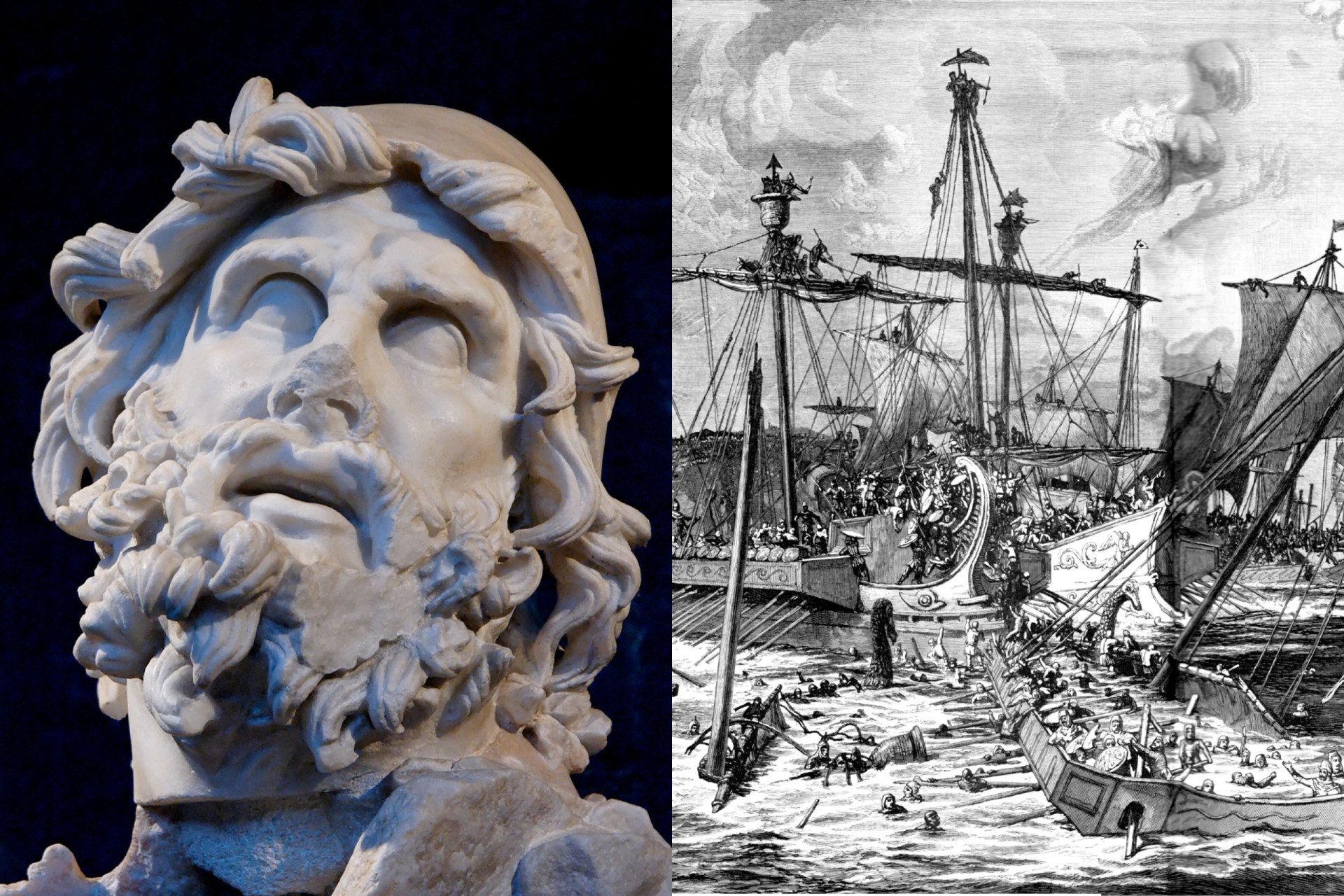
In the 12th century BCE, a legendary battle known as the Trojan War came to an end. Most of the surviving Greek warriors and heroes returned home, but not all of them did. For 10 years, the hero Odysseus sailed around the Mediterranean Sea, trying to return to his home and his wife. His journey was described by the ancient Greek poet Homer in an epic poem known as 'The Odyssey.'
Curious? Click through the following gallery to see where Odysseus went during those 10 years.
You may also like: 30 beautiful and single Hollywood celebrities
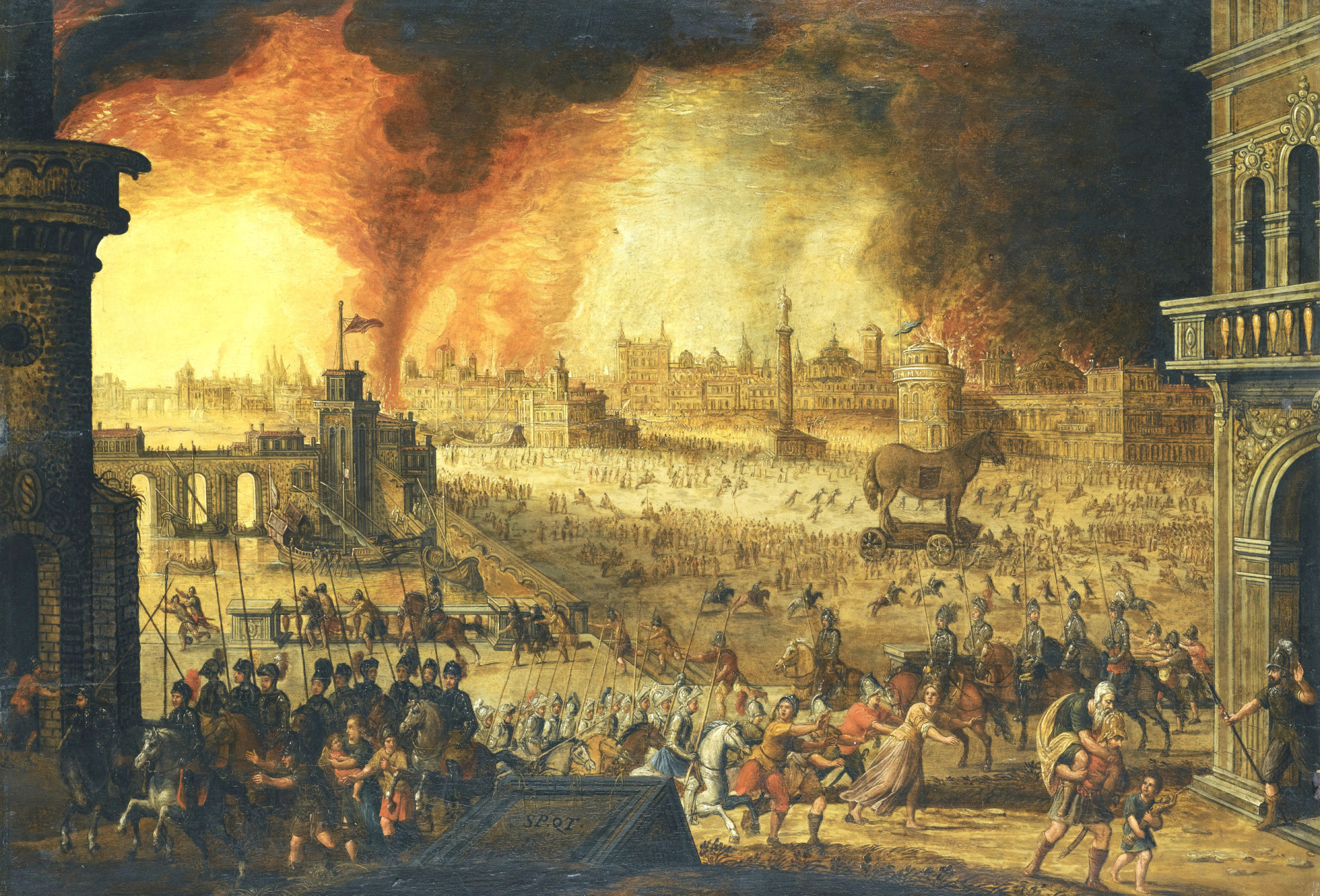
Departure from Troy
After the Greeks emerged victorious from the Trojan War, Odysseus and his men set sail from Troy for their homeland of Ithaca. However, their journey was far from straightforward. Due to past grievances, the gods (particularly Poseidon) had other plans for Odysseus.
Follow us and access great exclusive content every day
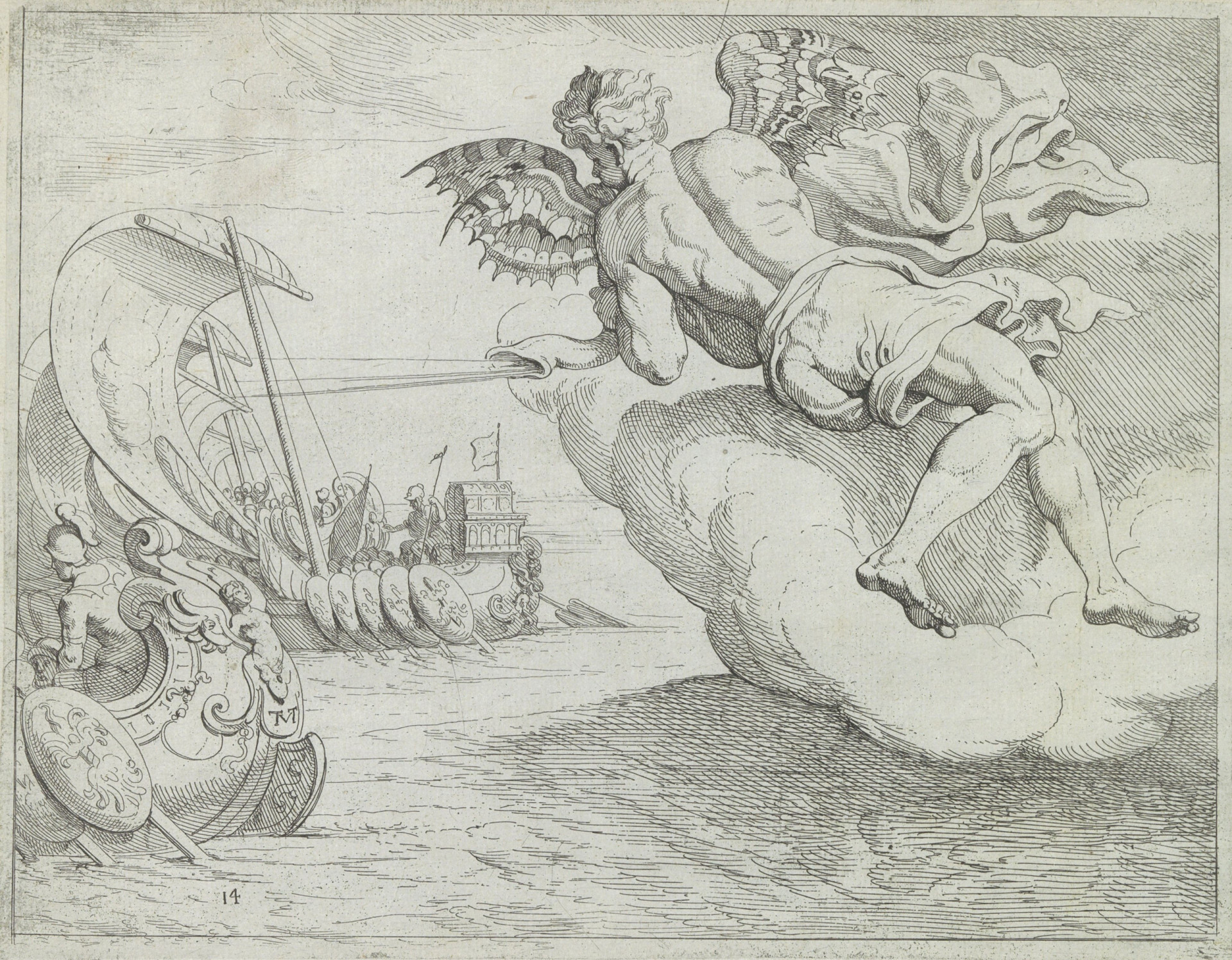
With the winds against them and their morale initially high, Odysseus and his crew anticipated a swift return home. But their hopes were quickly dashed as they faced one obstacle after another. The fleet was soon blown off course, marking the beginning of a series of trials that would test Odysseus' leadership and resilience.
You may also like: Conspiracy theories Americans are obsessed with
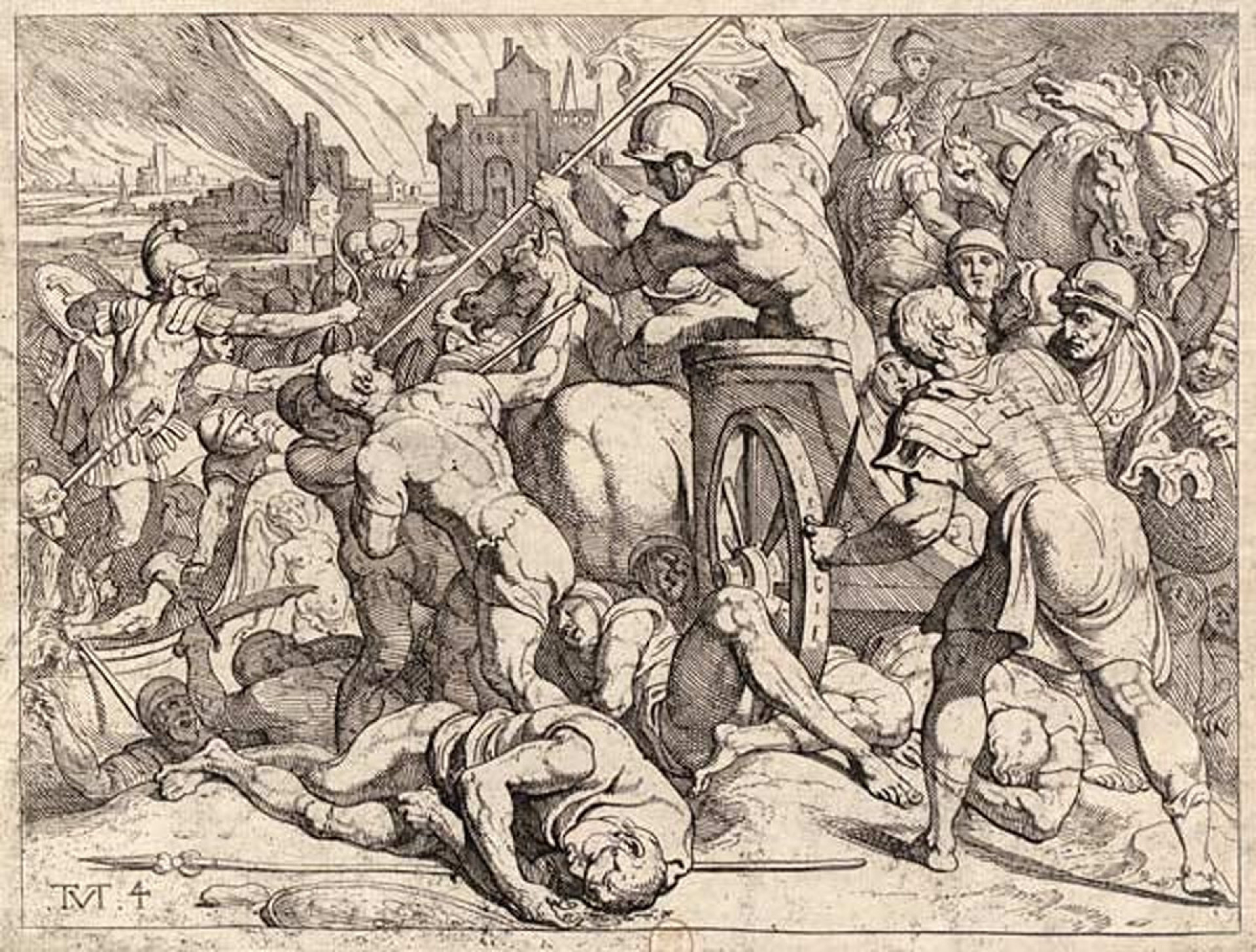
The land of the Cicones
The first notable stop on Odysseus’ voyage was the land of the Cicones, a tribe allied with the Trojans (the mortal enemies of the Greeks). Here, Odysseus and his men sacked the city of Ismarus, taking spoils and enslaving women. Despite their initial success, Odysseus’ men, driven by greed, ignored his warnings to leave quickly.
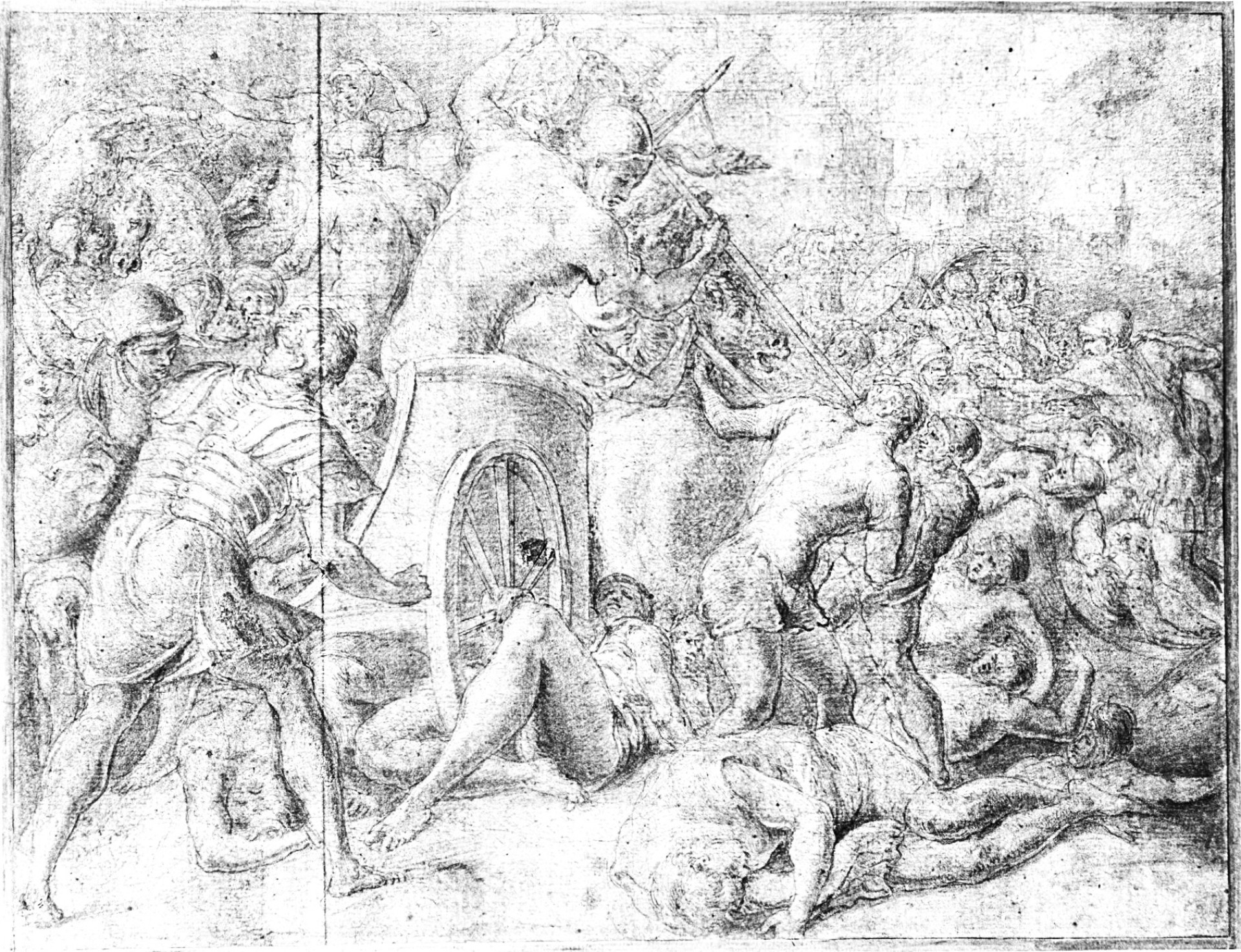
The Cicones gathered reinforcements and launched a counterattack. The Greeks were caught off guard, leading to a fierce battle where many of Odysseus' men were killed. Their arrogance cost them their lives; they would have survived if they had listened to their captain.
You may also like: Famous celebrities you didn't know were related

The island of the Lotus-Eaters
After their encounter with the Cicones, the fleet was driven by a storm to the land of the Lotus-Eaters near the African continent. The inhabitants of this island lived in a state of blissful forgetfulness induced by the consumption of the lotus plant (pictured).

Odysseus sent a reconnaissance party to explore the island, but these men, upon eating the lotus, lost all desire to return home. Realizing the danger, Odysseus forcibly retrieved his men and set sail immediately.
You may also like: Environmentally destructive foods we all consume
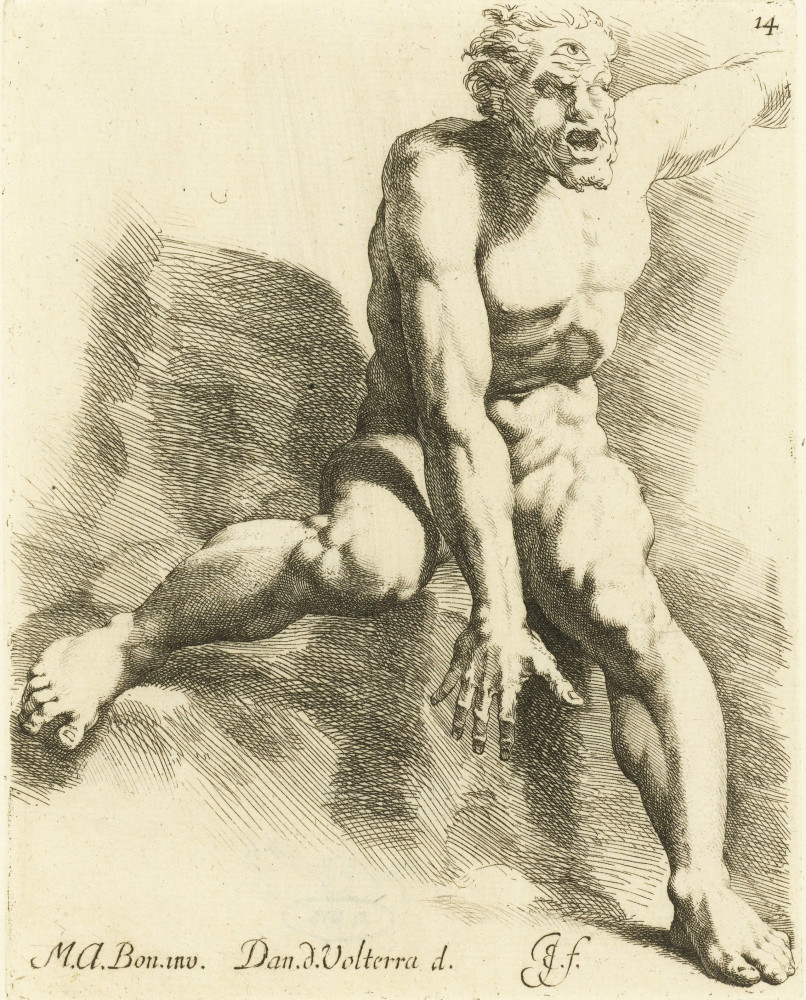
The Cyclops Polyphemus
The next significant challenge came when Odysseus and his crew landed on the island of the Cyclopes (known in modern times as the island of Sicily). Driven by the need for provisions, they ventured into the cave of Polyphemus, a gigantic, one-eyed Cyclops.
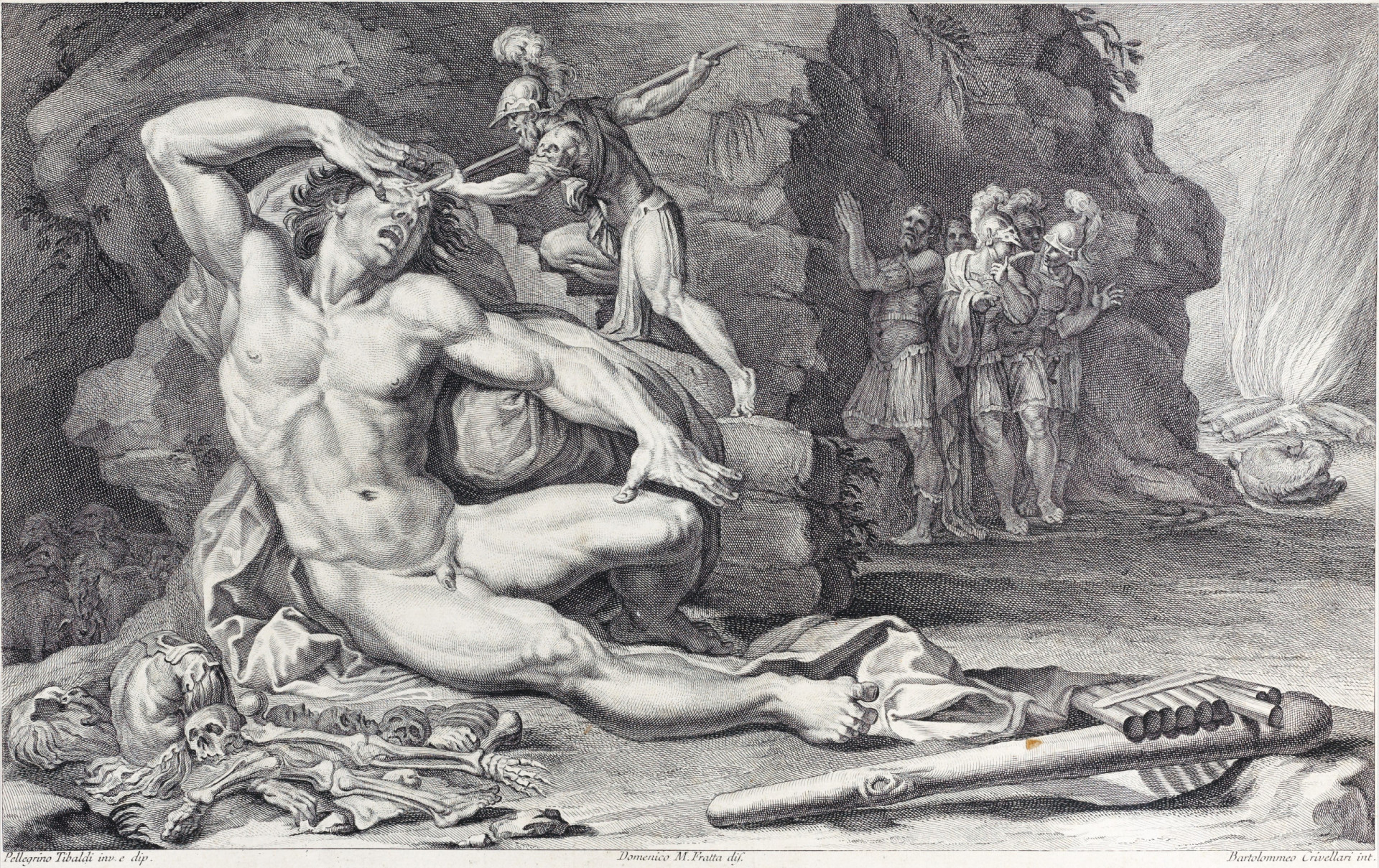
Polyphemus trapped them and began devouring Odysseus’ men one by one. Odysseus cunningly blinded Polyphemus with a heated stake, allowing him and his men to escape. However, Odysseus’ hubris led him to reveal his true identity as they fled, provoking the wrath of Polyphemus’ father, the god Poseidon.
You may also like: Celebrities who lost all their money
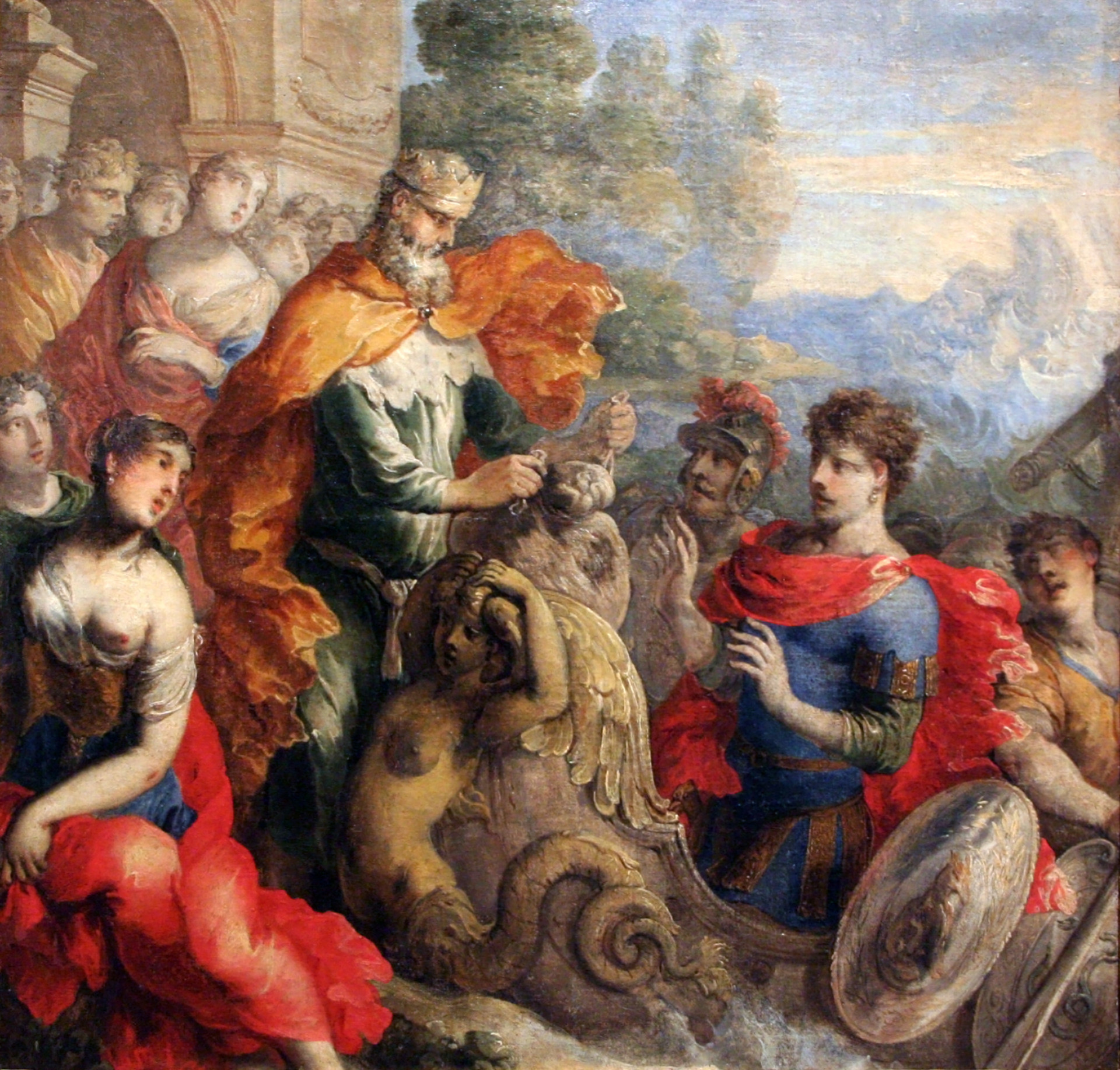
Seeking aid in their voyage, Odysseus and his men arrived at the floating island of Aeolia, home to Aeolus, the keeper of the winds. Aeolus kindly gave Odysseus a bag containing all the winds except the west wind, which would guide them home.
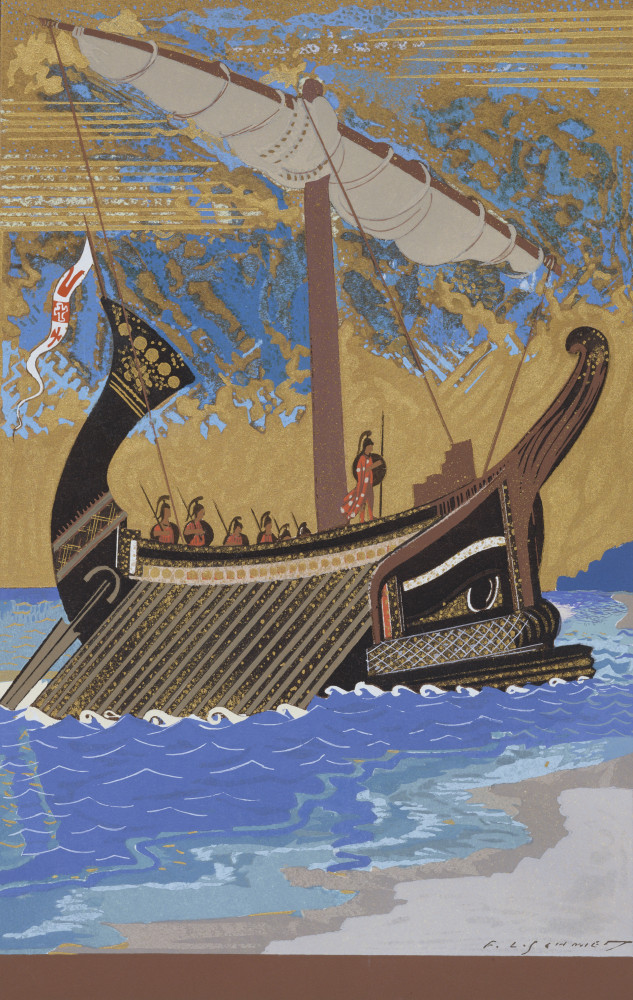
Just as the fleet sailed within sight of Ithaca, Odysseus' crew opened the bag, thinking that it contained treasure. The winds were unleashed into a tempest that drove them back to Aeolia. This time, Aeolus refused to help, believing their misfortune was a sign of divine displeasure.
You may also like: Australia's 60 biggest companies
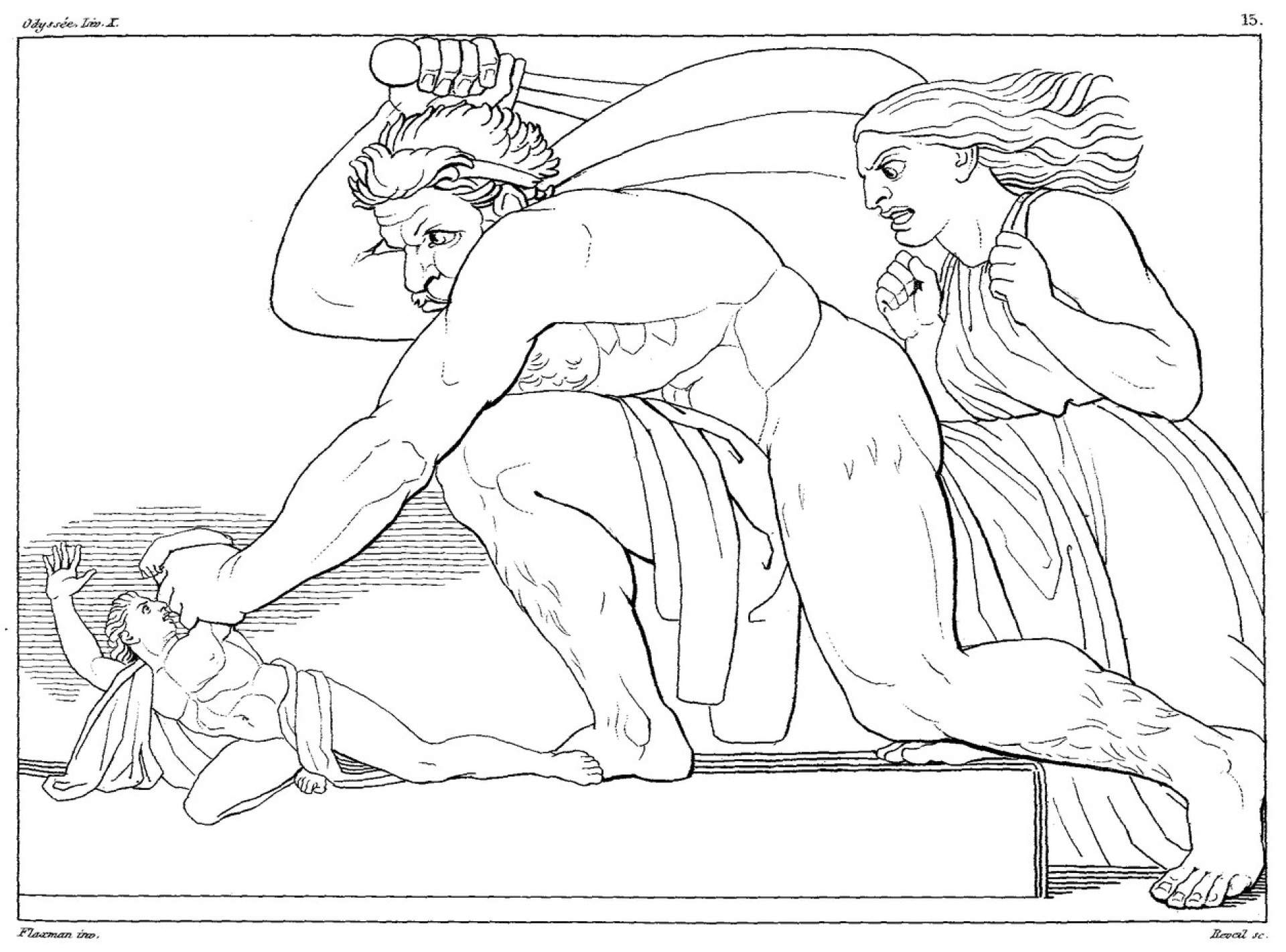
The Laestrygonians
Directionless, Odysseus and his crew sailed west, away from their homeland. The next landfall was in the territory of the Laestrygonians, a race of giant cannibals . Odysseus sent scouts to explore, who encountered the king's daughter and were led to the king's palace where the Laestrygonians attacked and devoured the scouts.
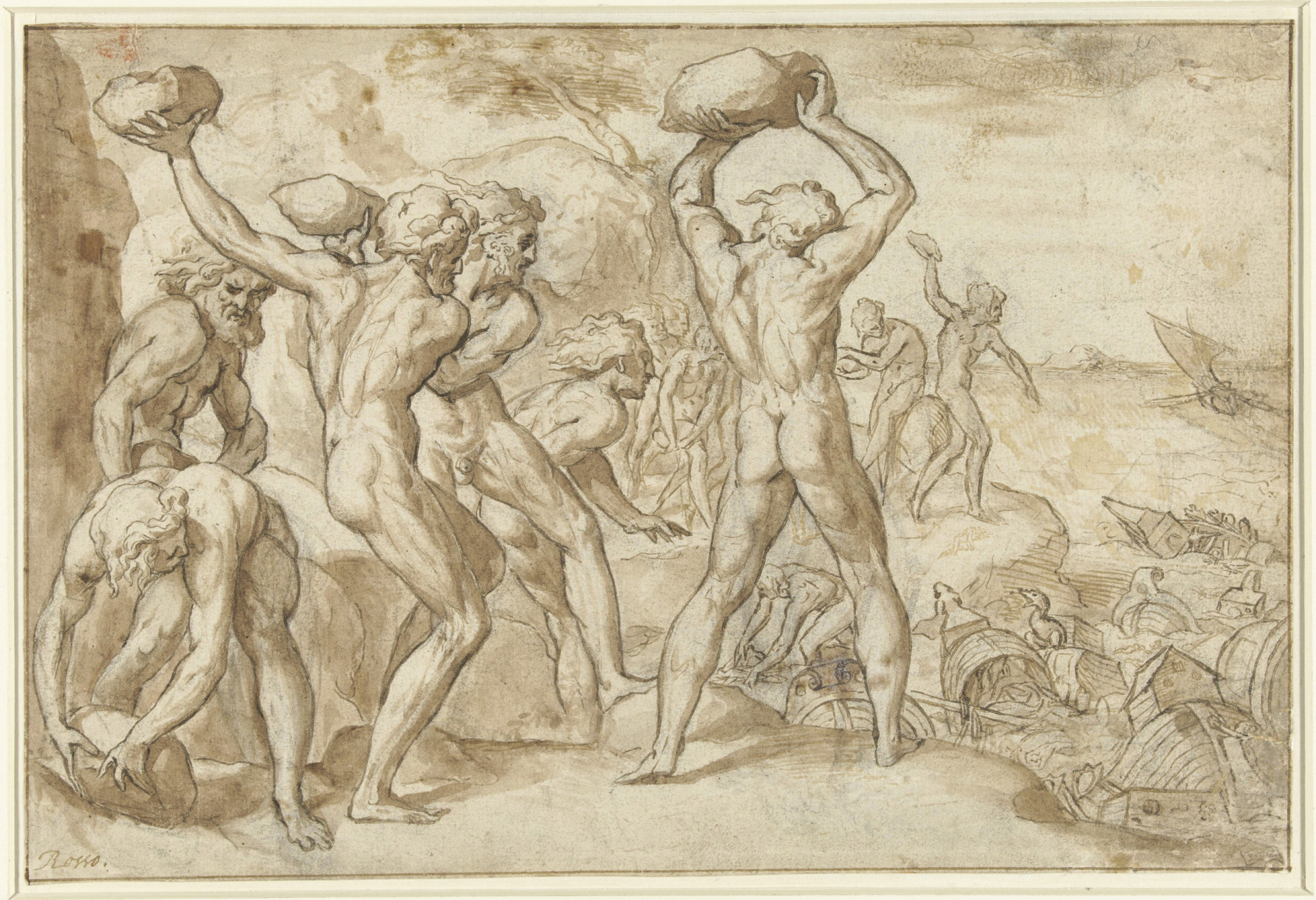
Fleeing back to their ships, Odysseus and his crew were ambushed at the harbor. The giants hurled massive rocks and sank all but Odysseus’ ship. With only one vessel remaining, Odysseus managed to escape with only a few survivors.
You may also like: Food facts that airlines don't want you to know
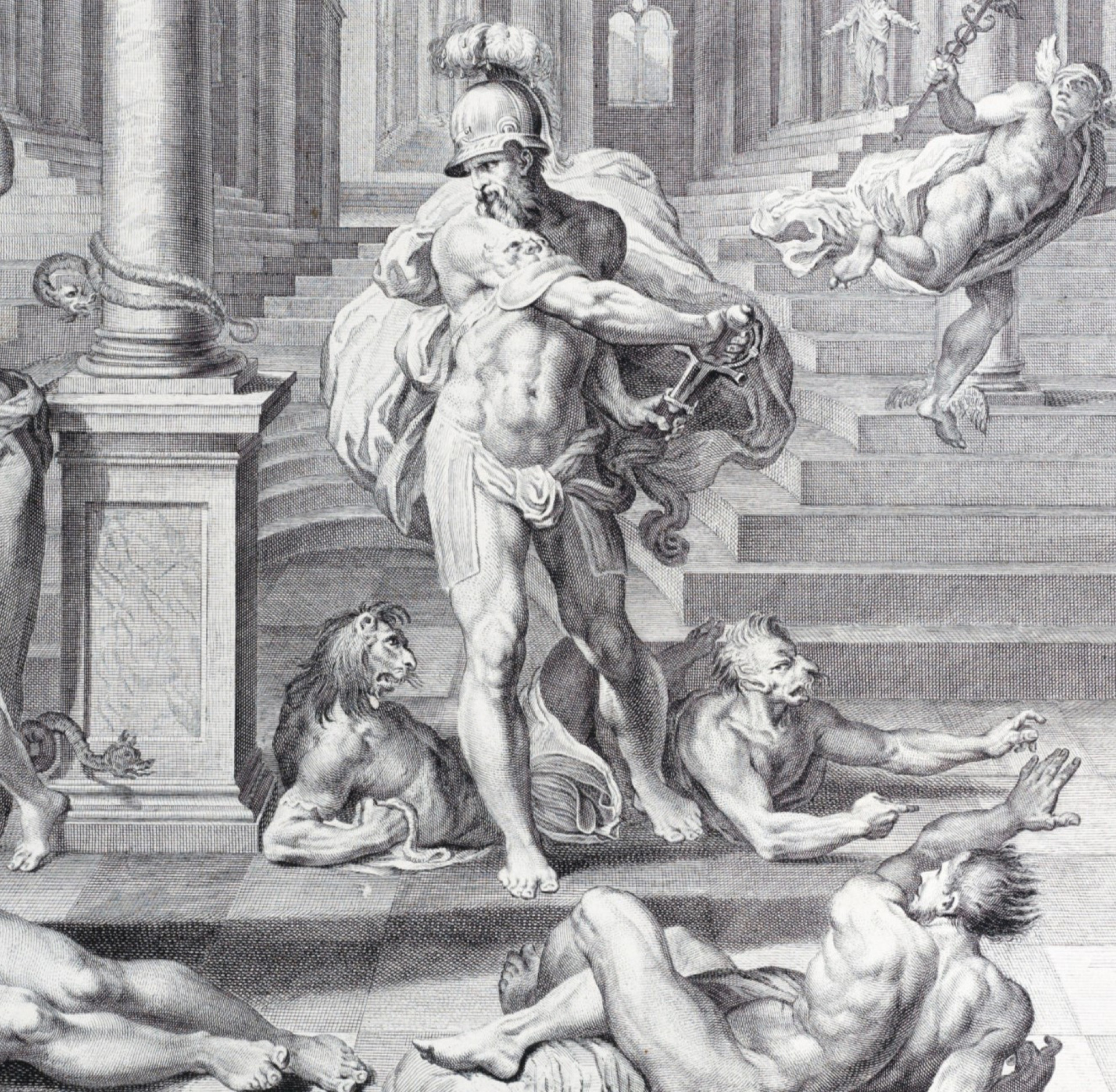
Circe’s island
Odysseus and his remaining men arrived at Aeaea, the island home of the enchantress Circe, located near modern-day Spain. She turned half of his men into swine upon their arrival. With the help of the god Hermes, Odysseus resisted Circe’s magic and forced her to restore his men to their human forms.
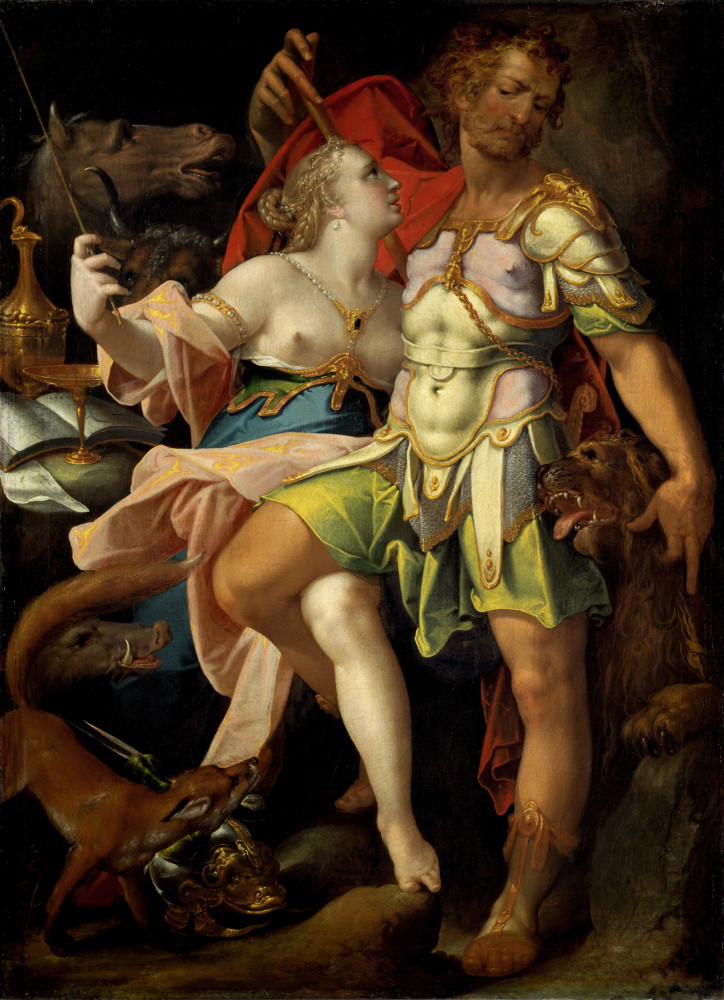
Circe was impressed by Odysseus, and so she became his ally and lover. They stayed on the island for a year, feasting and resting, until Odysseus was eventually reminded of his goal to return home. To help him, Circe advised Odysseus to seek the counsel of the prophet Tiresias in the Underworld.
You may also like: Celebrities who were already rich before being famous

The Underworld
Following Circe’s instructions, Odysseus journeyed to the Underworld, the realm of the dead, to consult the blind prophet Tiresias. There, he performed the necessary rituals to summon the spirits. Tiresias foretold the challenges still to come and warned Odysseus of the perils he would face, including the need to avoid harming the cattle of Helios.
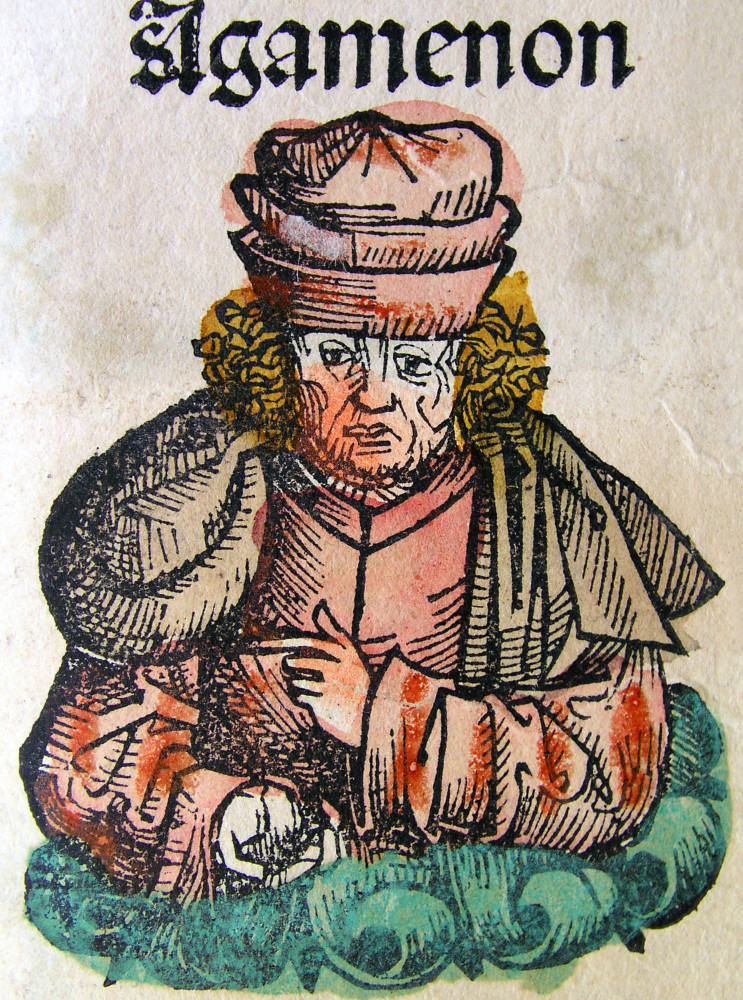
In the Underworld, Odysseus also encountered the spirits of his mother, Anticlea, and other notable figures from his past, such as the hero Achilles and the late king Agamemnon. These encounters provided him with crucial insights and a renewed sense of determination to return to Ithaca and his wife, Penelope.
You may also like: Famous women worth more than their male partners
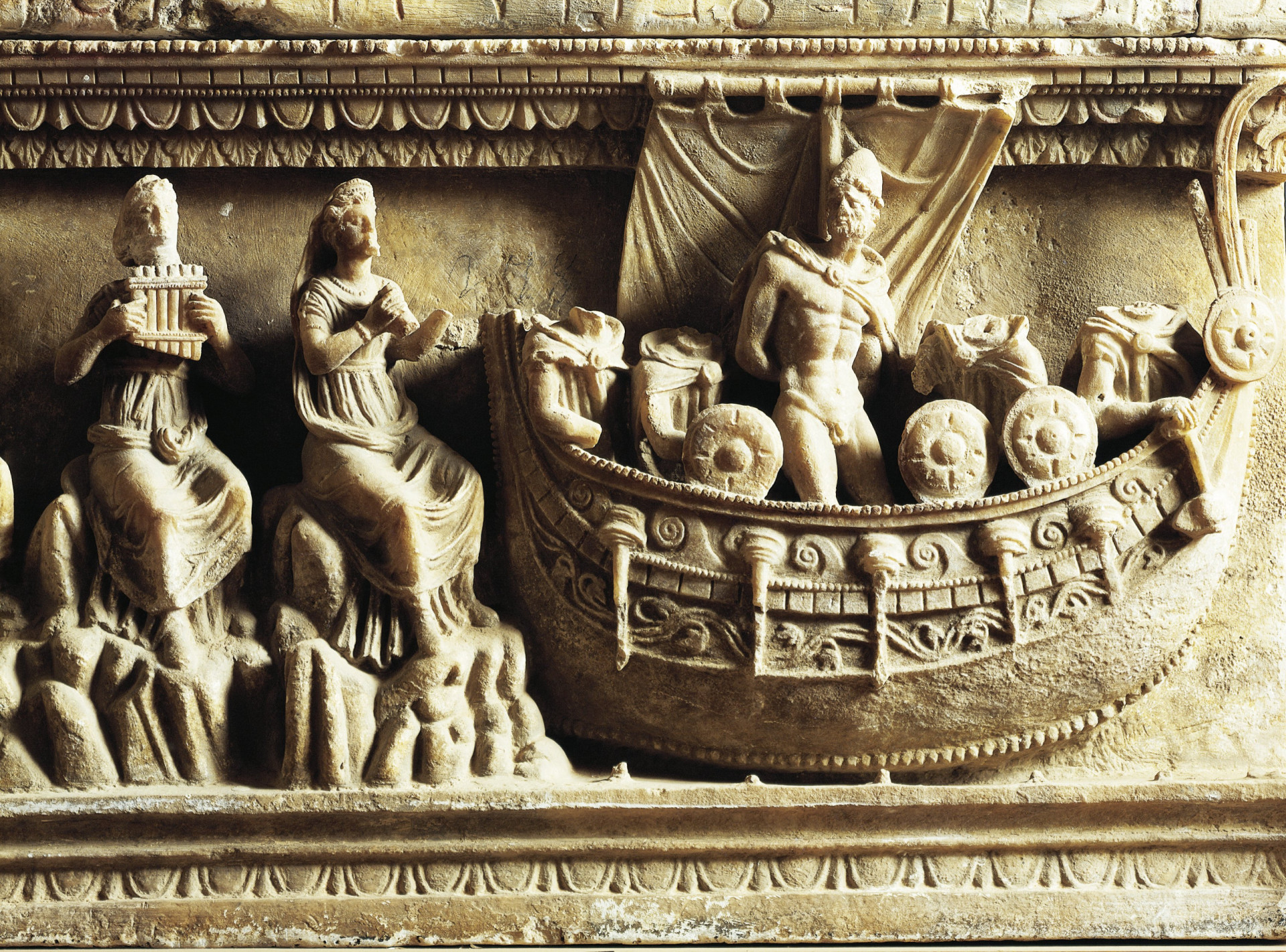
Upon returning from the Underworld, Odysseus and his men sailed east and eventually faced the Sirens, whose enchanting song lured sailors to their doom. Following Circe’s advice, Odysseus had his crew plug their ears with beeswax and ordered them to tie him to the mast of the ship.

Odysseus was curious to hear the Sirens' song without succumbing to their lure, and so he alone listened while bound to the mast. As they sailed past, he was entranced and begged to be released, but his loyal crew kept him securely fastened until they were safely out of earshot.
You may also like: Incredible historic images of D-Day
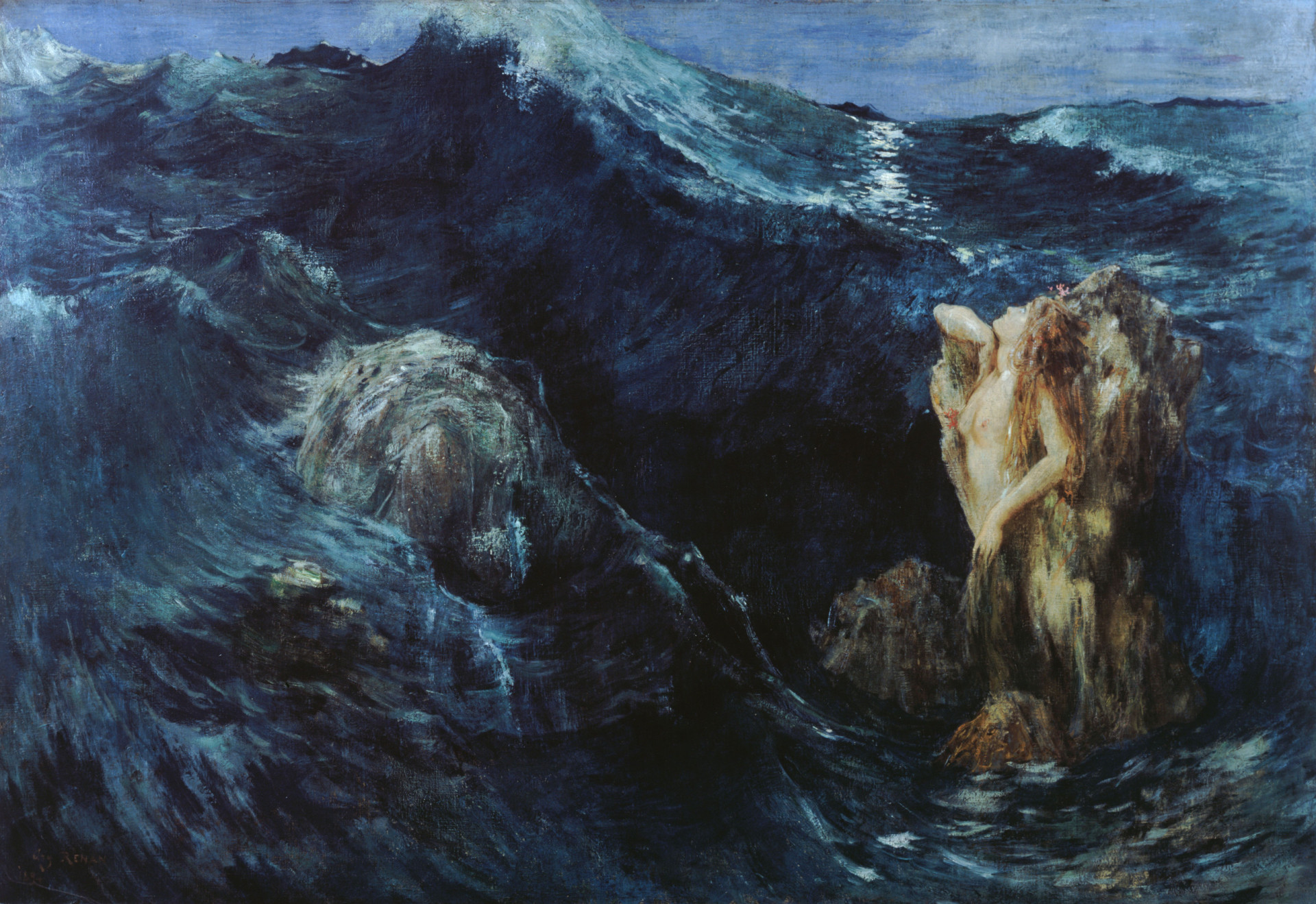
Scylla and Charybdis
The journey next brought Odysseus to a narrow strait guarded by Scylla and Charybdis. Scylla was a six-headed monster that devoured sailors from passing ships, while Charybdis was a massive whirlpool that could swallow entire vessels.
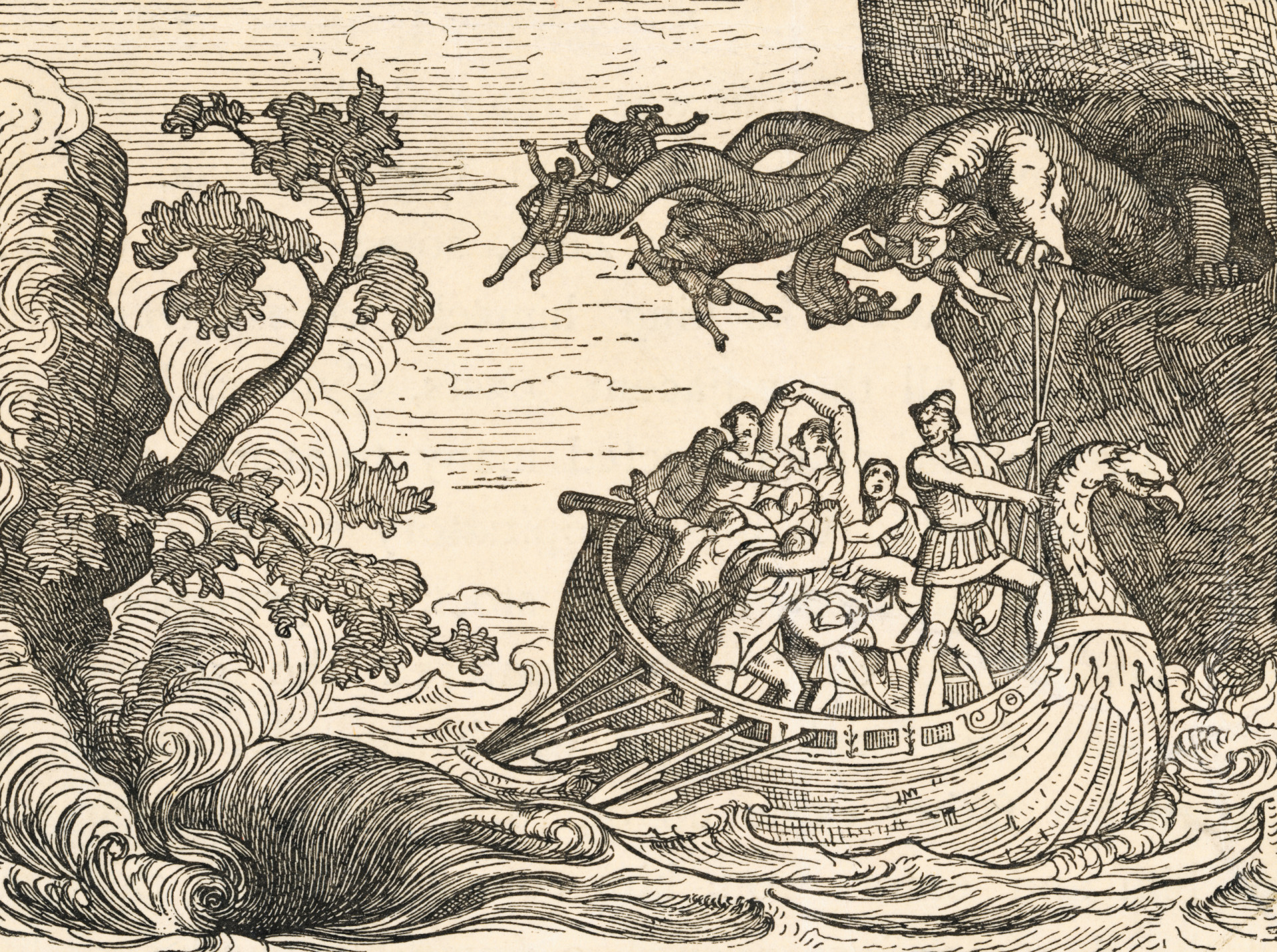
Odysseus chose to sail closer to Scylla, sacrificing a few men rather than risking the entire ship being engulfed by Charybdis. As they navigated the narrow passage, Scylla snatched and devoured six of Odysseus' best men.
You may also like: Looking back at Tom Hanks' best and worst movies
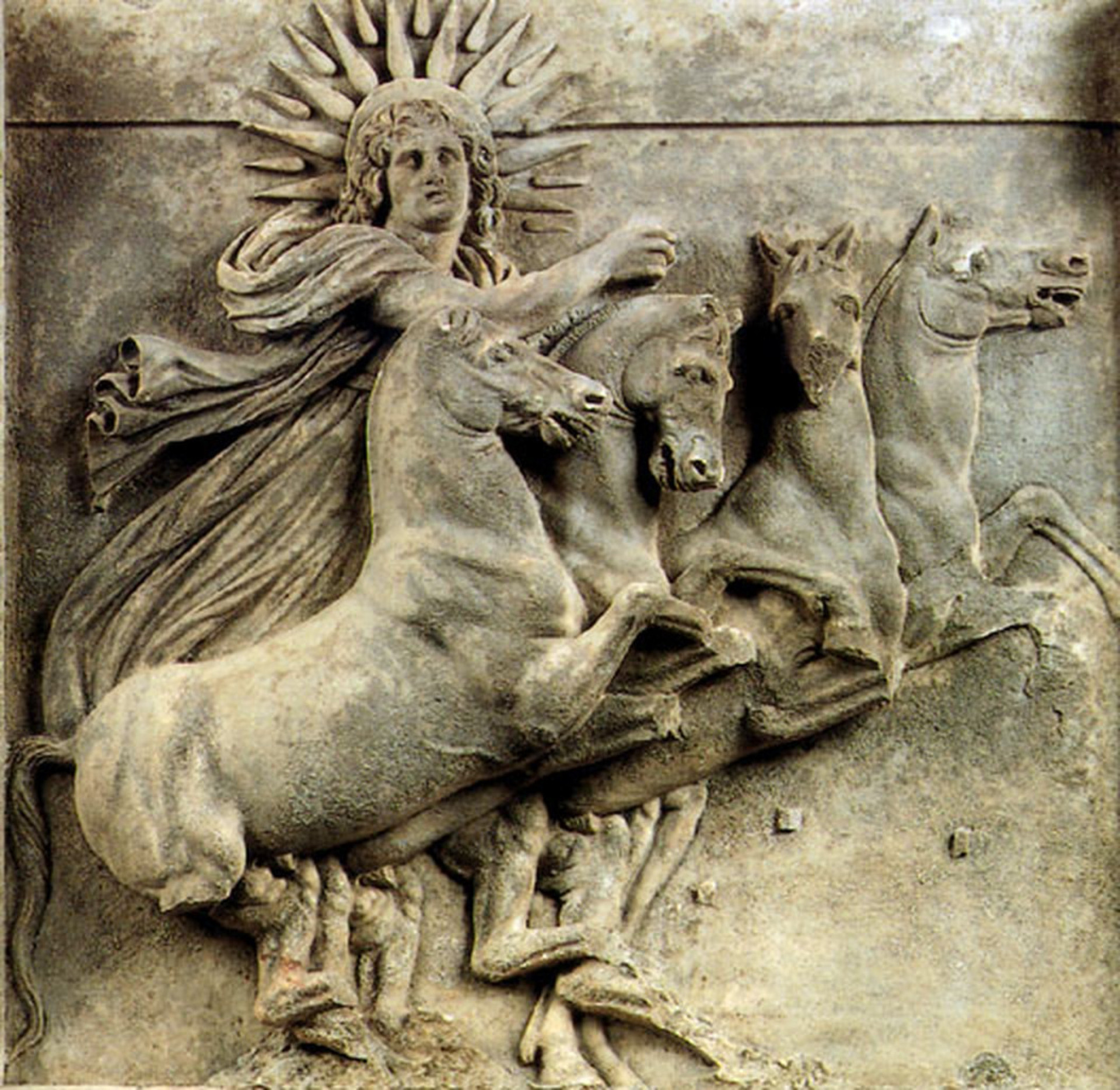
The island of Thrinacia
Odysseus and his remaining crew sailed south to Thrinacia, the island where the sacred cattle of Helios (pictured) lived. Despite explicit warnings from Tiresias and Circe to avoid the island and the cattle, adverse winds stranded them on Thrinacia for a month.
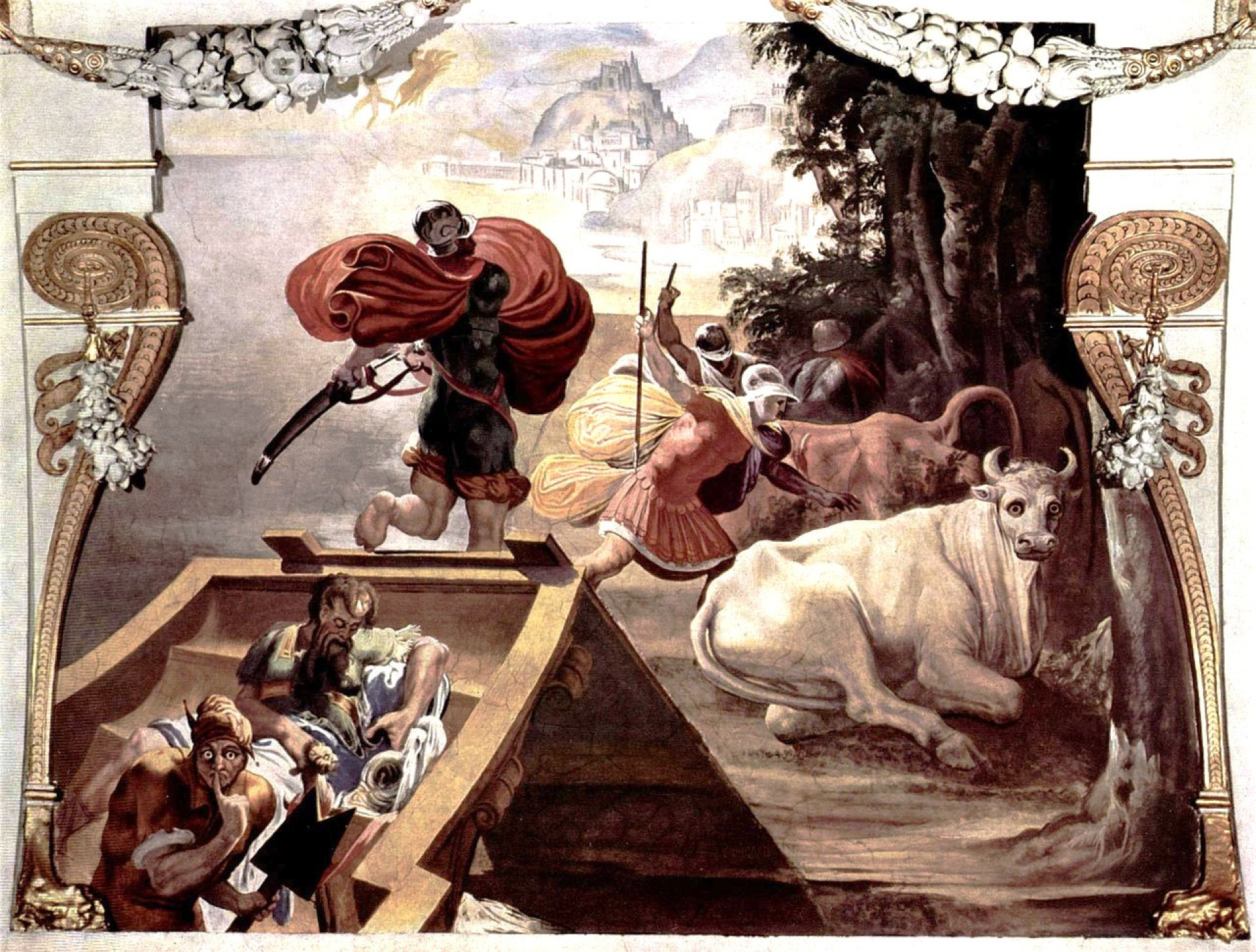
Facing starvation, the crew eventually slaughtered the sacred cattle while Odysseus was asleep. This act of defiance angered Helios, who demanded retribution from Zeus. Once they set sail, Zeus sent a storm that destroyed the ship and drowned all of Odysseus' men. Only Odysseus survived, clinging to a piece of wreckage from his ship.
You may also like: Disney stars: Then and now
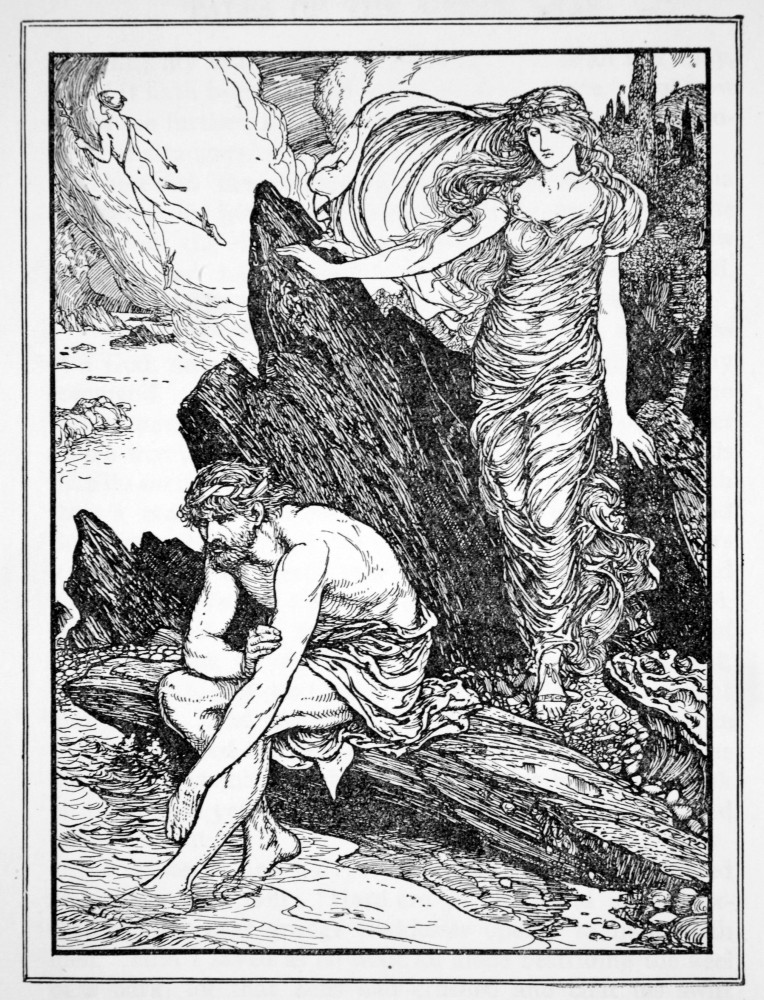
Calypso’s island
After drifting at sea, Odysseus washed ashore on Ogygia, the island of the nymph Calypso. Calypso fell in love with Odysseus and kept him captive for seven years, offering him immortality if he stayed with her. Despite the comfort and temptation, Odysseus longed to return home.
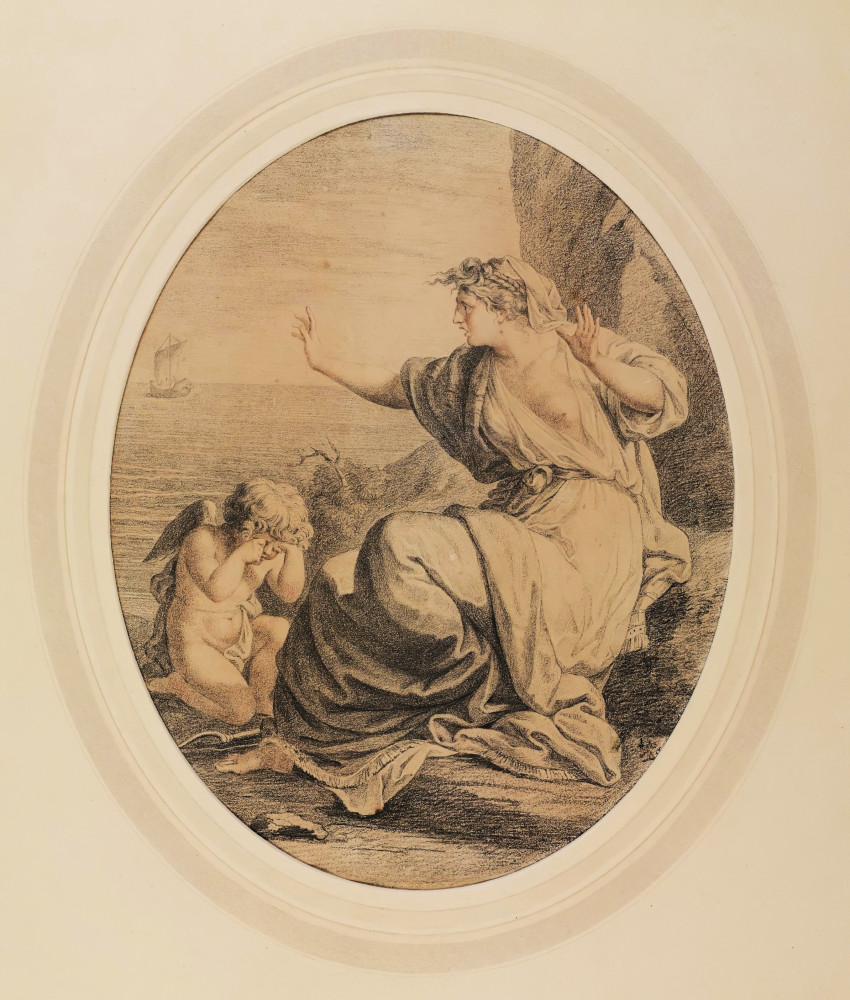
Eventually, the gods intervened, and Athena persuaded Zeus to order Calypso to release Odysseus. Calypso reluctantly complied, providing him with materials to build a raft. This period truly tested Odysseus' resolve and his commitment to his goal of returning to Ithaca.
You may also like: The environmental impact of COVID-19
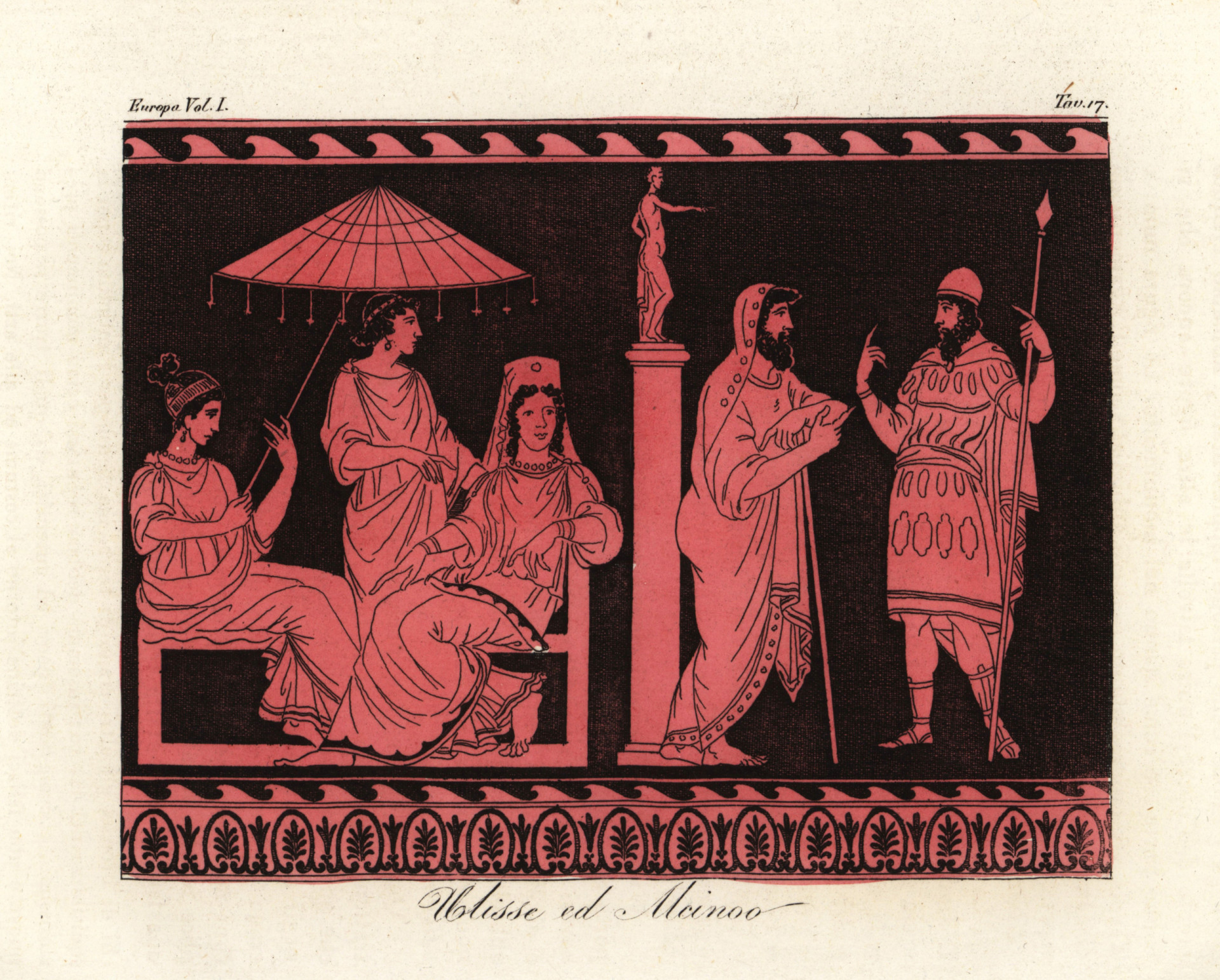
The Phaeacians
Shortly after leaving Calypso’s island, Odysseus' raft was wrecked by Poseidon. Thankfully, he was saved by the sea goddess Ino and washed ashore on Scheria, the land of the Phaeacians. Exhausted and near death, he was discovered by Nausicaa, the king's daughter, who led him to the palace.
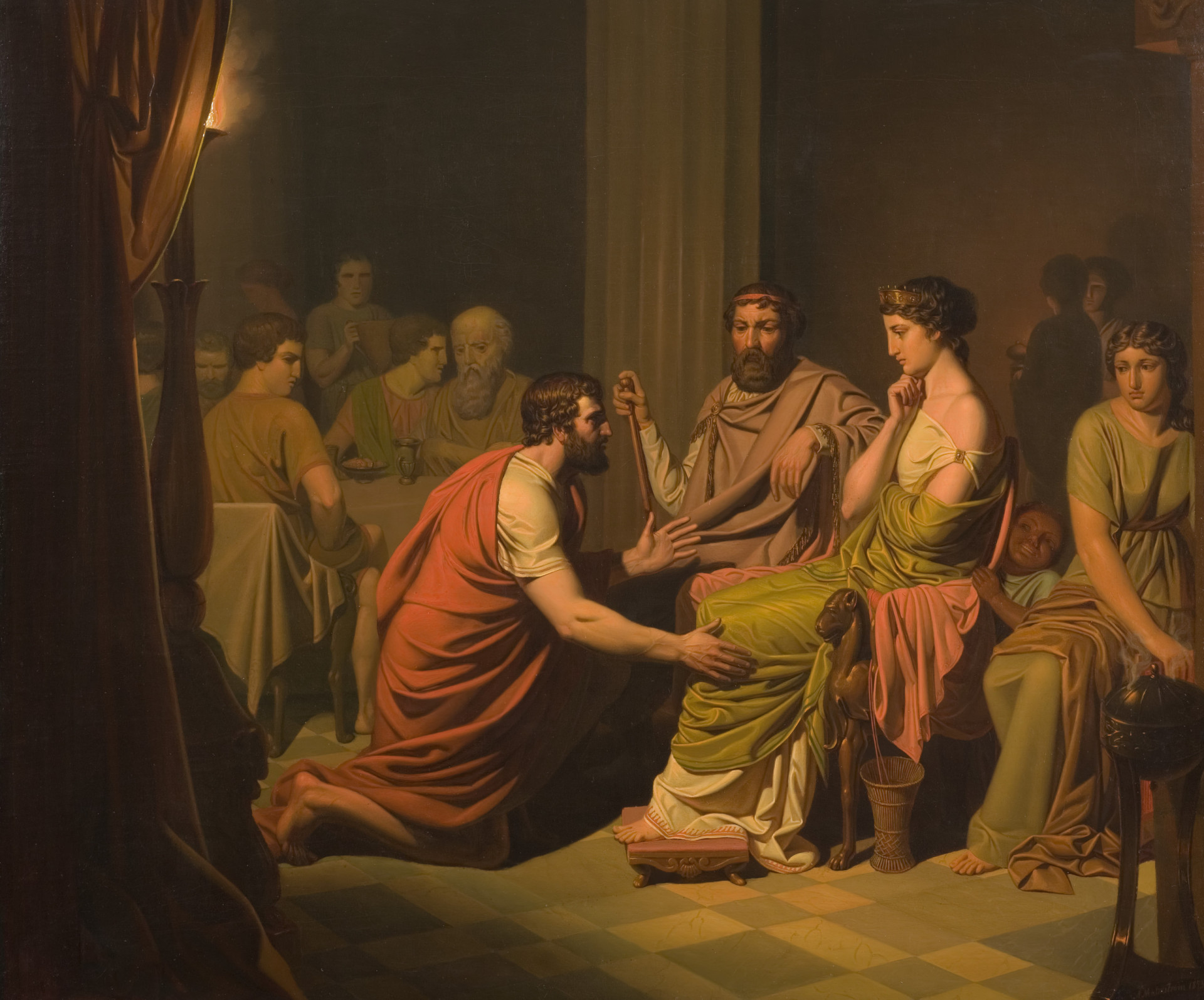
The Phaeacians were known for their hospitality, and so they welcomed Odysseus and listened to the tale of his adventures since he left Troy. The Phaeacians were moved by his story, and they provided him with a ship to return to Ithaca.
You may also like: Be careful: 30 foods you shouldn't eat after 30
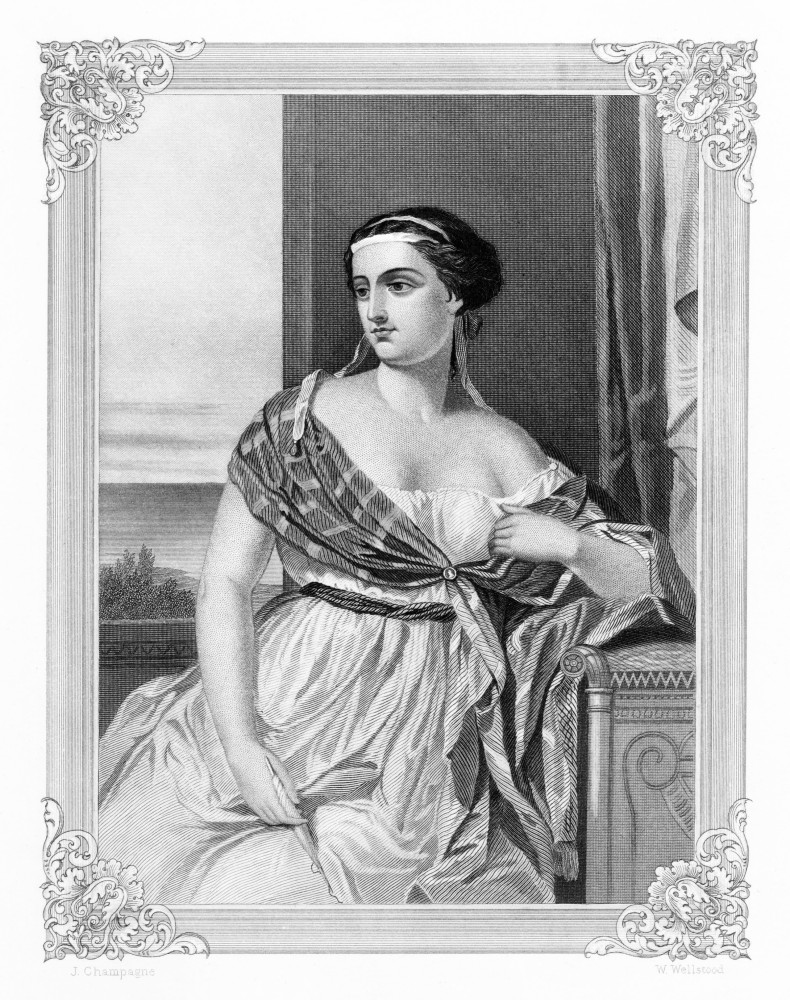
Return to Ithaca
Odysseus sailed west on the ship and finally arrived in Ithaca after a tumultuous journey. But his trials were not yet over. Disguised as a beggar, Odysseus learned that his palace was overrun by suitors vying for the hand of Penelope (pictured), since they believed him to be dead.
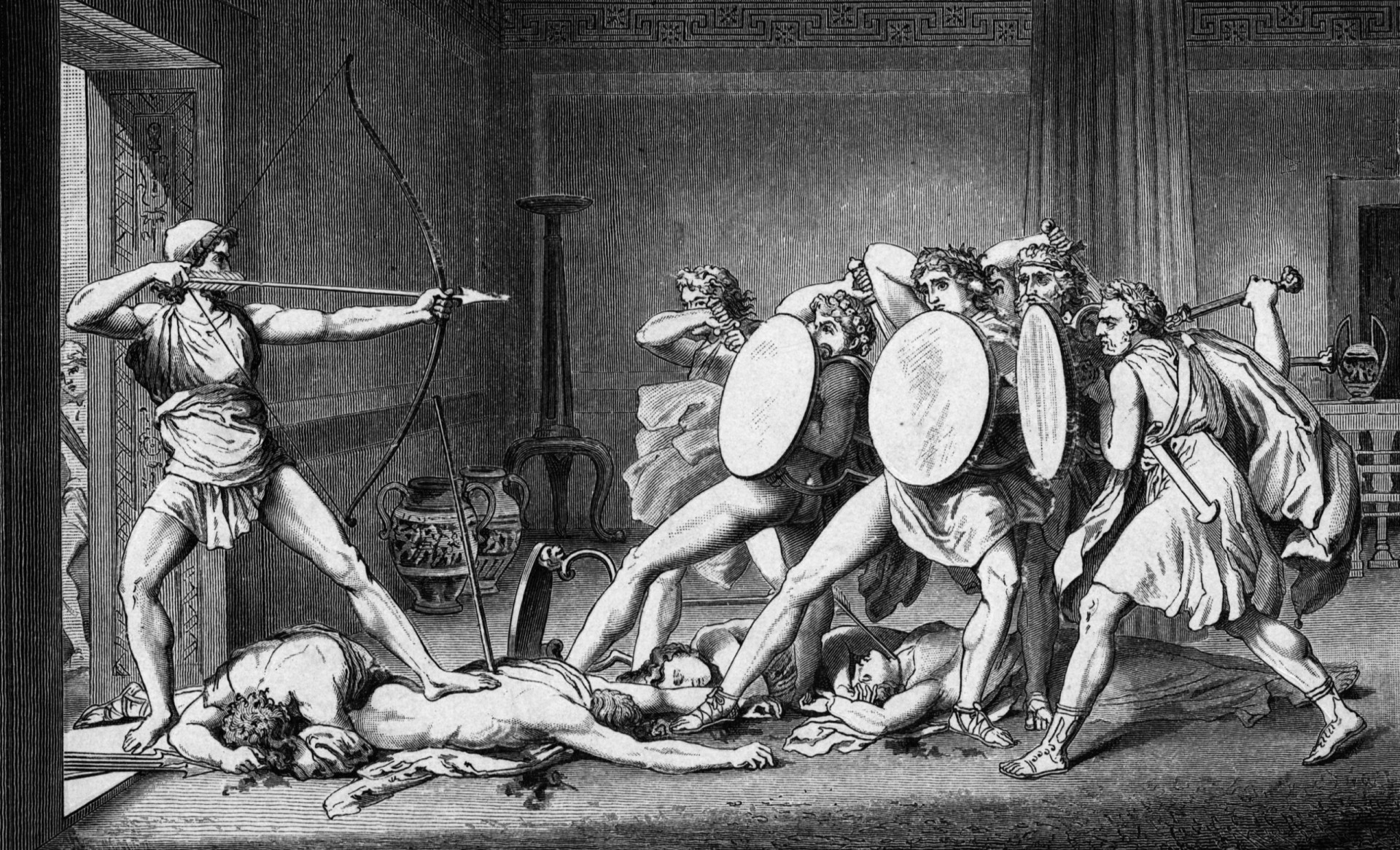
With the help of his son and a few loyal servants, Odysseus plotted his revenge. Penelope, still loyal to Odysseus, devised a contest for the suitors to each string a bow and shoot an arrow through 12 axe heads, a feat only Odysseus could accomplish. By completing the challenge, Odysseus revealed himself. The remaining suitors were slain quickly after.
You may also like: Stars who survived serious plane incidents
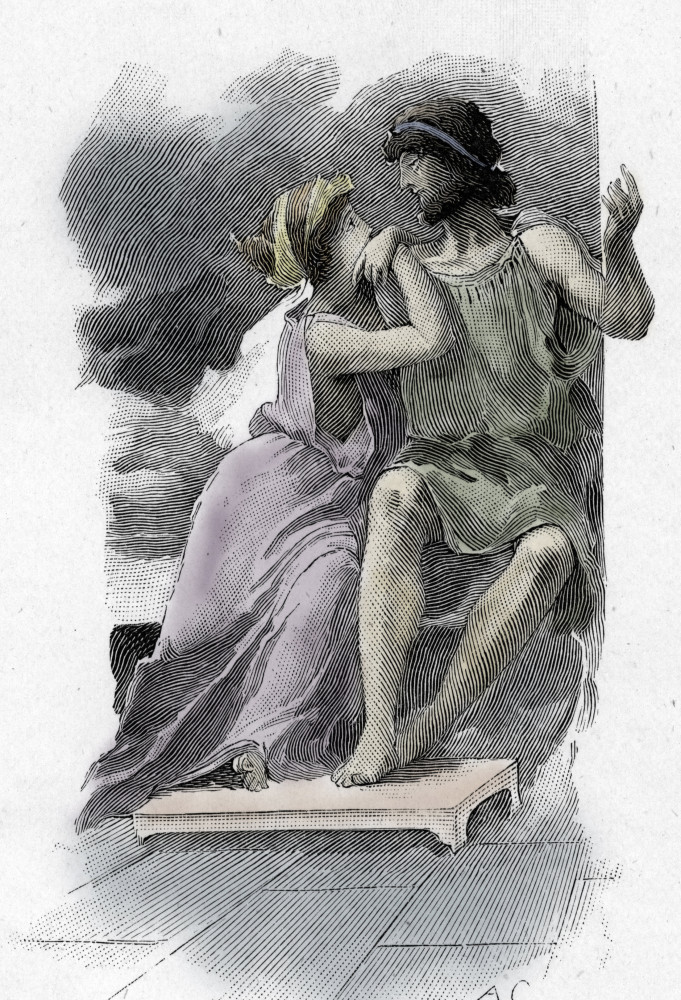
Reunion and restoration
The reunion of Odysseus and Penelope was initially marked by skepticism. Penelope tested Odysseus by ordering their marriage bed to be moved, a task that was impossible because one of its legs was actually a living olive tree. Odysseus' knowledge of this secret proved his identity to Penelope.
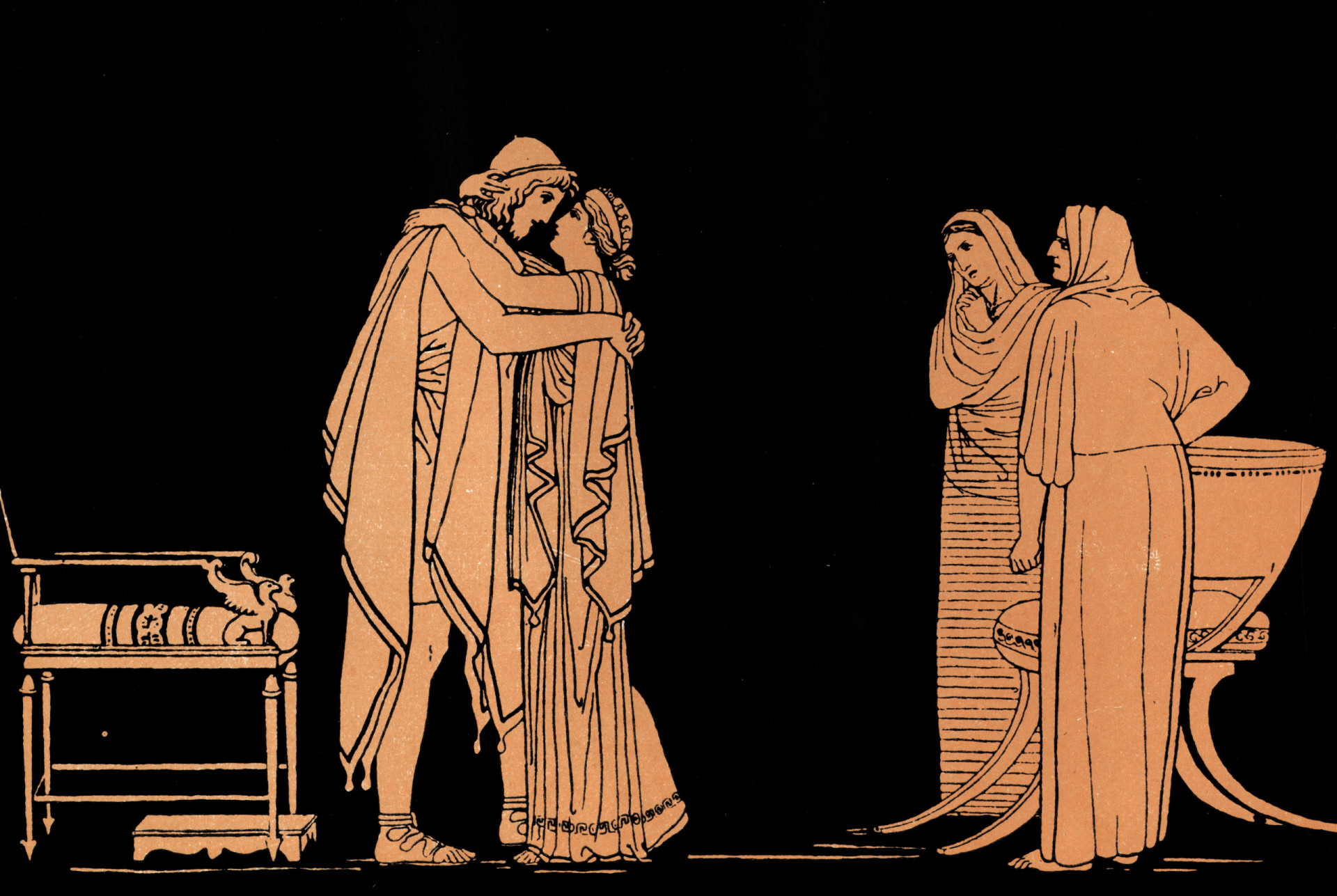
The couple's reunion was a joyous one. With Athena's assistance, peace was restored in Ithaca and Odysseus was able to reclaim his throne. In the millennia since, Odysseus’ 10-year journey has been used as an example of loyalty and how love is powerful enough to bring someone home.
Sources: (University of Pennsylvania) (World History Encyclopedia) ('The Odyssey')
See also: The differences between Greek and Roman mythology
More for You
Fundraising following Biden's dropout announcement just scorched Trump's after the former president's conviction
How Much Savings You Need to Comfortably Retire in Portugal
The Las Vegas Raiders Are Returning To Southern California, Very Quietly
35-year-old making $11,400 a week in passive income: The 3 questions I asked myself before quitting my day job
The Moon is slowly drifting away from Earth and it's beginning to impact us
50 Years Ago, a Sci-Fi Classic Was Saved From Becoming a Disaster — And Inspired a Modern Hit
The New 2024 Chevelle 70/SS Brings the American Muscle Car Roaring Back to Life
This Arizona Town Is One of the Best Places to Retire in the U.S. — With Affordable Homes, Excellent Weather, and Tons of Outdoor Recreation
Barber Coins Are Worth Thousands: Here’s How To Spot Them in Your Spare Change
Sam Altman gave people $1,000 a month for 3 years. Here's what happened
The New 'Twisters' Movie Honors Late 'Twister' Star Bill Paxton With a Surprise Cameo
6 signs someone secretly dislikes you, according to psychologists
A grim trend among Americans without college degrees exposes an enormous failure
Sen. Ron Johnson releases preliminary findings of probe into Trump assassination attempt
What's The Smallest Diesel Engine You Can Buy & Which Brands Currently Make Them?
I Suddenly Realized Why My Marriages Failed. I Was to Blame
Navy aviator scores first air-to-air victory by a US female fighter pilot
9 Places To Retire That Are Just Like Colorado But Way Cheaper
Harvard professor who teaches a class on happiness: The happiest people balance and prioritize 3 things
'This problem is not going away': An entire Florida homeowners association board just quit after $60K special assessment dispute — here's why

IMAGES
VIDEO
COMMENTS
This is a timeline of Odysseus' Journey From Ithaca to the Trojan War Then Back Home by: Emilia Irovic There was a call to war of the Achaeans (Greeks) against the people of Troy. This war, the Trojan War, started because Paris, the Trojan prince, abducted (or eloped with) Helen, the wife of Menelaus. Menelaus convinced his brother, Agamemnon, the king of Mycenae, to lead an expedition to find ...
2.Cicones. Odysseus and his men set off on their journey, and this was their first stop. They raided the city of Cicones, slaughtered their men and enslaved their women. They kill all of their stock and then set sail again. 3.Lotus Eaters. The Lotus Eaters were located on Northern Africa. The people who live on that island give Odysseus' men ...
This map shows Odysseus' journey after he left Troy. While his encounters were fictional — there were no Lotus Eaters, Sirens, or Cyclopes in the ancient Mediterranean — his ports of call were real. ... Freed from a mountain prison in order to guard a Chinese monk on his journey to retrieve the Buddhist scriptures from India, Monkey seeks ...
Odyssey Order. Odysseus and his men raid the Cicones. Council of the gods. Athena bargains with Zeus. They arrive at the Land of the Lotus Eaters. Athena visits Telemachus; he sails for Pylos. Odysseus blinds Polyphemus. Telemachus reaches Pylos, then moves on to Sparta. Aiolos gives Odysseus the bag of winds.
Odysseus Journey Map. The Greeks celebrate their victory over Troy at the beginning of the Odyssey, forgetting that it was not their own strength that won the city, but rather the will of the gods. In light of this neglect to give credit where it is due, Athena and Poseidon become very angry. They begged Zeus to make the Greeks suffer, and he ...
The Odyssey (/ ˈ ɒ d ɪ s i /; Ancient Greek: Ὀδύσσεια, romanized: Odýsseia) is one of two major ancient Greek epic poems attributed to Homer.It is one of the oldest extant works of literature still widely read by modern audiences. As with the Iliad, the poem is divided into 24 books.It follows the Greek hero Odysseus, king of Ithaca, and his journey home after the Trojan War.
The Odyssey, one of Homer's two great epics, narrates Odysseus' long, strange trip home after the Trojan war.During their ten-year journey, Odysseus and his men had to overcome divine and natural forces, from battering storms and winds to difficult encounters with the Cyclops Polyphemus, the cannibalistic Laestrygones, the ...
Disguised as a beggar, Odysseus devised a plan to reclaim his throne and eliminate the suitors. With the help of his son Telemachus, the goddess Athena and a few loyal allies, Odysseus executed his plan with precision and brutality. Odysseus revealed his true identity to the suitors and engaged in a battle that resulted in their defeat.
A map illustrating the journey home of the Achaean warrior-king Odysseus after the Trojan war.His travel from Troy to Ithaca (and his wife Penelope) took innumerable twists and turns and lasted ten years. Ever since Homer's Odyssey was written about 600 BCE (and undoubtedly long before that), people have been trying to plot the hero's trek on the Mediterranean map.
Timeline. Map. After the Trojan war, Odysseus and his men set sail from Troy. They plunder the Cicones but are routed by reinforcements. On the island of the lotus eaters, some men eat the food of the enchanting inhabitants and loose all hope of home. On the Island of the Cyclops, Odysseus's curiosity causes him trouble: he and twelve others ...
Book 11 is an account of Odysseus's journey to the Land of the Dead. Circe informs Odysseus that, in order to reach Ithaca, he must first go to Land of the Dead and speak with Tiresias, the ...
Odysseus's wanderings and the recovery of his house and kingdom are the central theme of the Odyssey, an epic in 24 books that also relates how he accomplished the capture of Troy by means of the wooden horse.Books VI-XIII describe his wanderings between Troy and Ithaca: he first comes to the land of the Lotus-Eaters and only with difficulty rescues some of his companions from their lōtos ...
Odysseus is an important character in Greek mythology. He is a major character in Homer's Iliad and the protagonist of the Odyssey. The island where Odysseus is from is called Ithaca; he is the ...
The Odyssey Odysseus--soldier, sailor, trickster, and everyman--is one of the most recognizable characters in world literature. His arduous, ten-year journey home after the Trojan War, the subject of Homer's Odyssey, is the most accessible tale to survive from ancient Greece, and its impact is still felt today across many different cultures.
The myth of Odysseus' journey home, like the myth of the Trojan War, spans a period of ten years. It begins with Odysseus' departure from the sacked city of Troy and follows him as he sails to numerous strange and exotic lands throughout the Mediterranean. ... In order for the civilized human world to function properly, however, certain ...
However, Odysseus' men ignore the warning and slaughter the cattle, incurring the wrath of the gods. As punishment, they are shipwrecked and all but Odysseus are killed. He washes up on the island of the nymph Calypso, where he is held captive for seven years. Eventually, the gods intervene and Hermes is sent to order Calypso to release Odysseus.
The Odyssey, one of Homer's two great epics, narrates Odysseus' long, strange trip home after the Trojan war. During their ten-year journey, Odysseus and his men had to overcome divine and natural forces, from battering storms and winds to difficult encounters with the Cyclops Polyphemus, the cannibalis ...
The Journey to the Underworld. Odysseus and his men arrived to underworld, a place no one ever dared trespass. After a while the prophet Tiresias came to meet Odysseus and he asked the prophet what he has to do in order to get back home. Tiresius said to him: "Poseidon hates you, because you blinded Cyclops Polyphemus, his son.
In Greek mythology, Odysseus, also known as Ulisses, is a prominent character and the hero of Homer's epic poem, the Odyssey. He was the king of Ithaca, known for his bravery, intelligence, and leadership. Odysseus played a crucial role in the Trojan War and embarked on a journey filled with trials and adventures.
Share Cite. Odysseus faces a number of challenges on his way home, including: sailors captivated by the lotus-eaters. a battle with Polyphemus, a cyclops. a storm sent by Poseidon. an encounter ...
Map of Odysseus' Journey: Odysseus' journey does not map with certainty onto any known geography. Homer doesn't specify exact locations. This has not stopped Homer's readers, ancient as well as modern, from attempting to reconstruct his travels by real world landmarks in the Mediterranean -- and it won't stop us!
For example, the journey of Odysseus can be seen as a metaphor for the journey of life, with its many trials and tribulations. The various characters and creatures that Odysseus encounters along his journey can also be seen as symbols of different aspects of human nature, such as greed, lust, and pride. ... Order your paper now. The service ...
Click to read story summaries: 1.Troy /troy.html 2.Cicones /cicones.html 3.Lotus Eaters /lotus-eaters.html 4.Cyclops /cyclops.html 5.Island of Aeolia /island-of-aeolia.html...
His journey was described by the ancient Greek poet Homer in an epic poem known as 'The Odyssey.' ... and Athena persuaded Zeus to order Calypso to release Odysseus. Calypso reluctantly complied ...
In contrast, "Tales from the Odyssey" tells the story of Odysseus, a Greek leader, leading his crew to return to Ithaca. During their journey, they face multiple risks on different islands. "Tales from the Odyssey" shows a lot of risks in Odysseus' journey, but there are two main ones: sinking in the ocean and forgetting about their home.